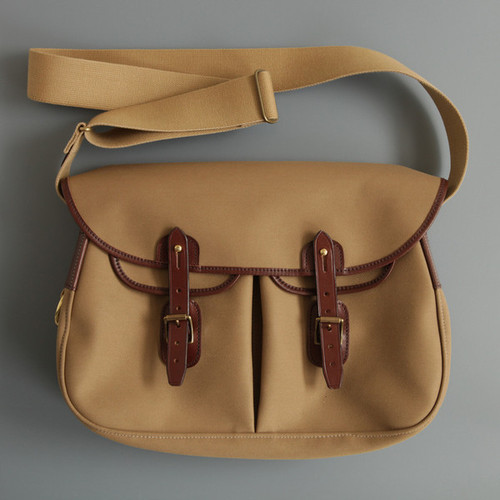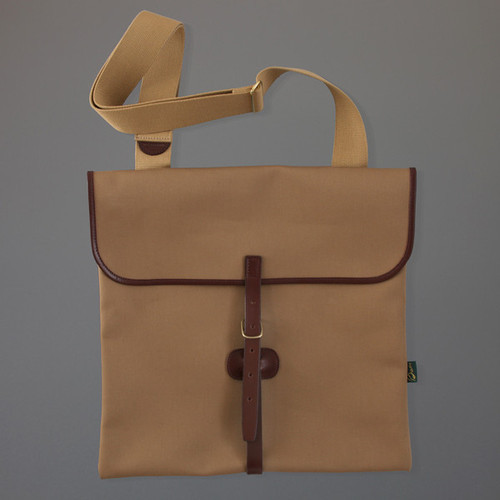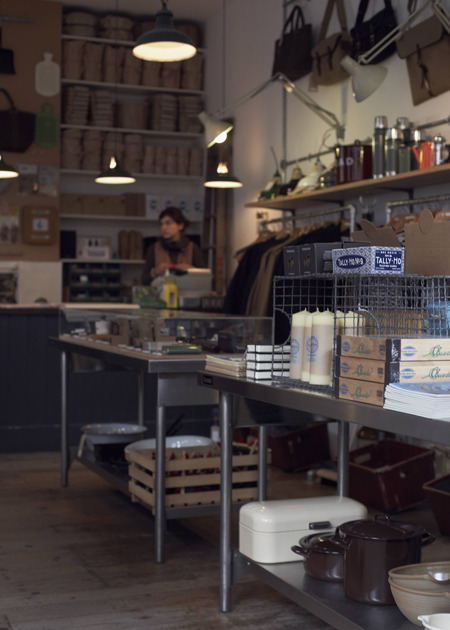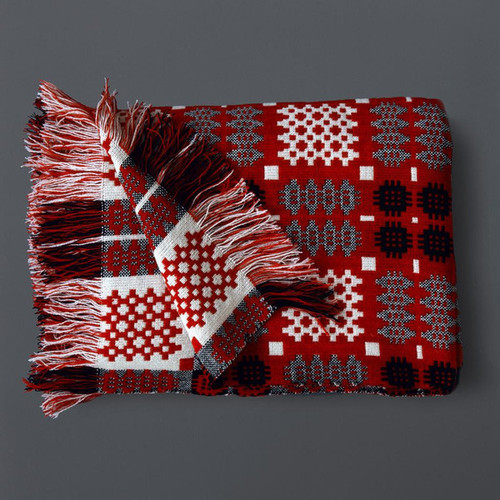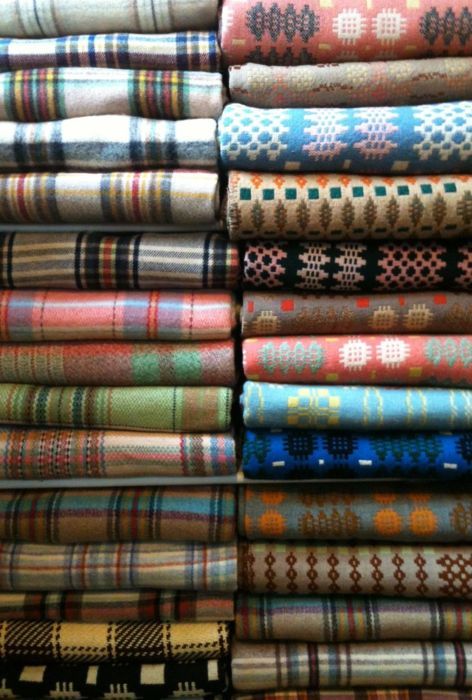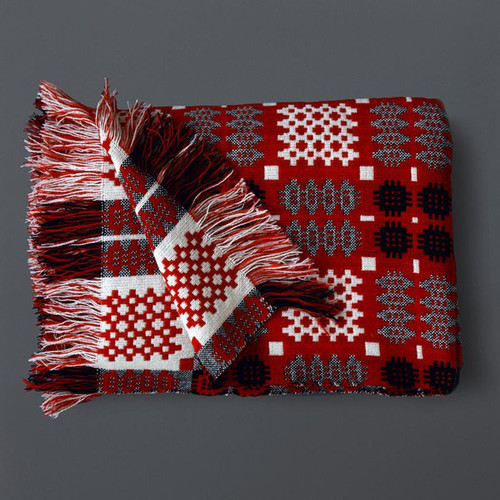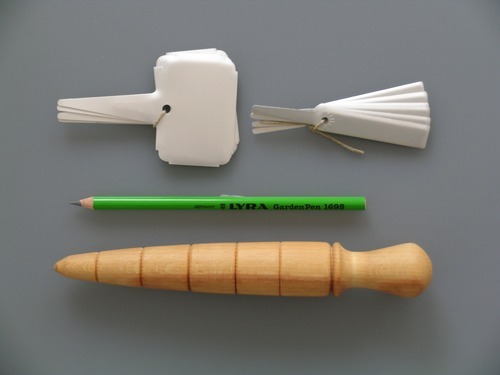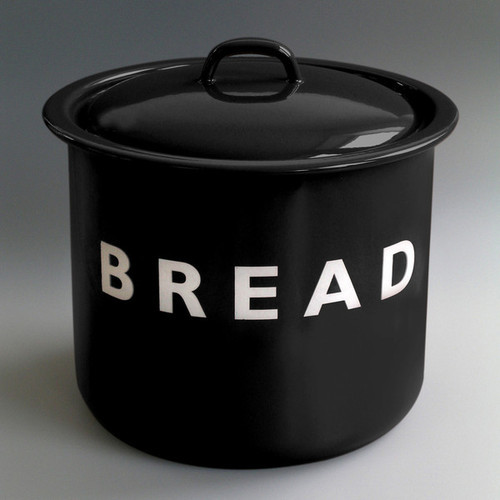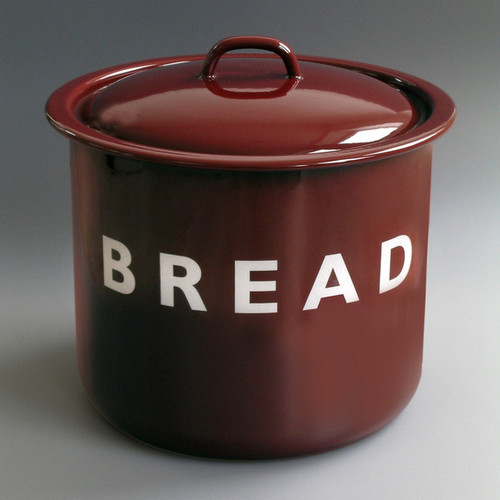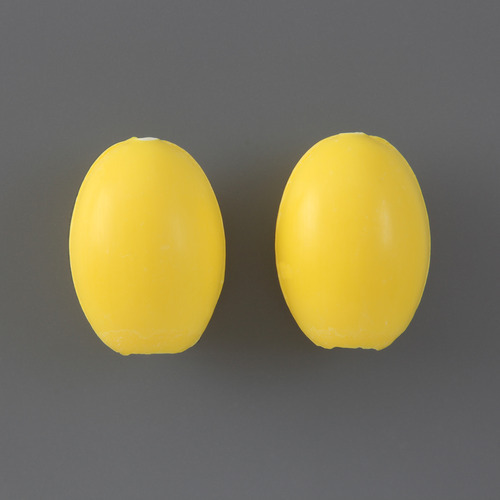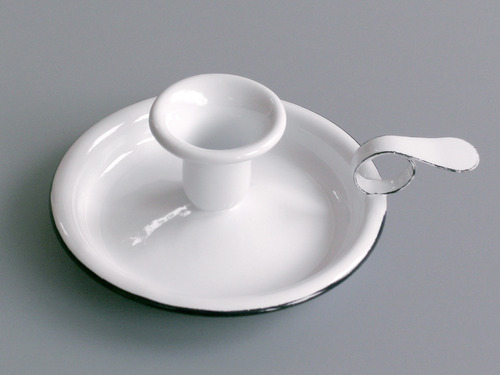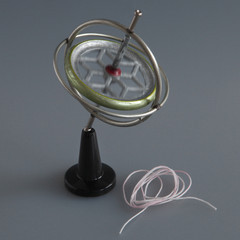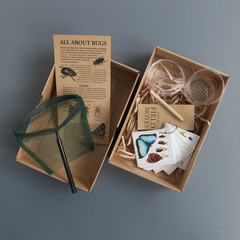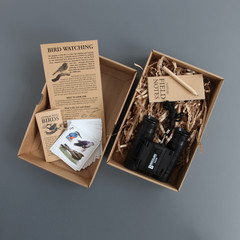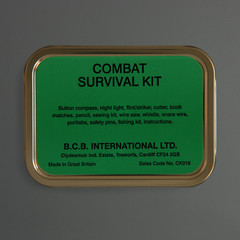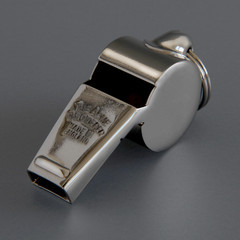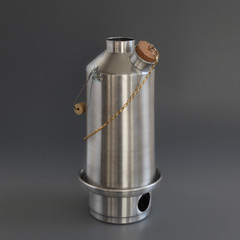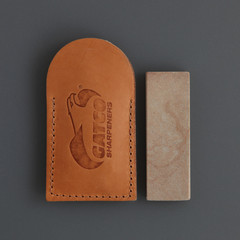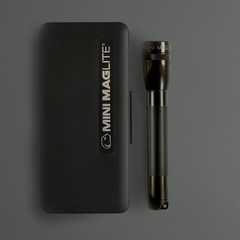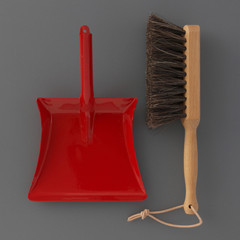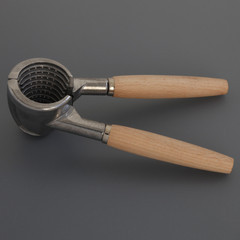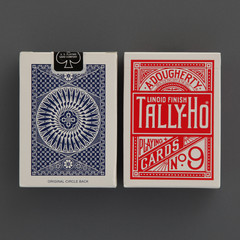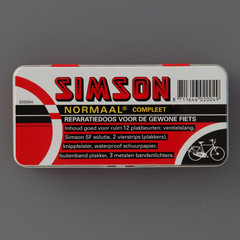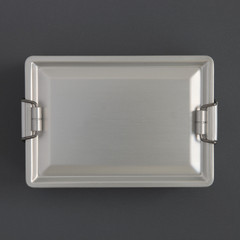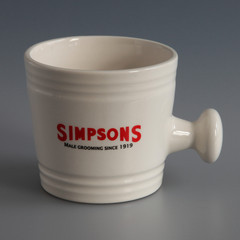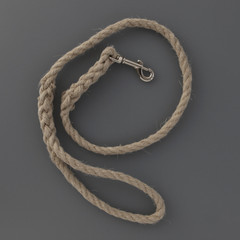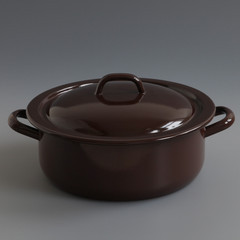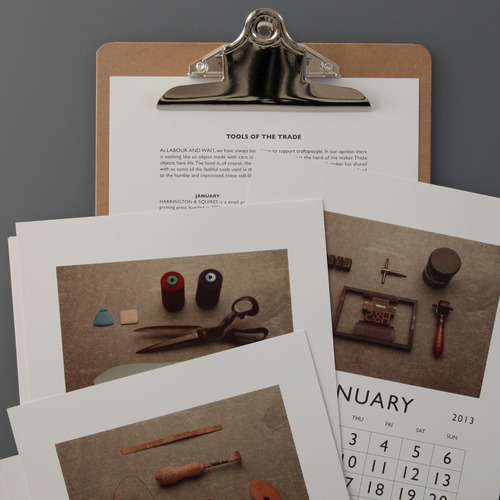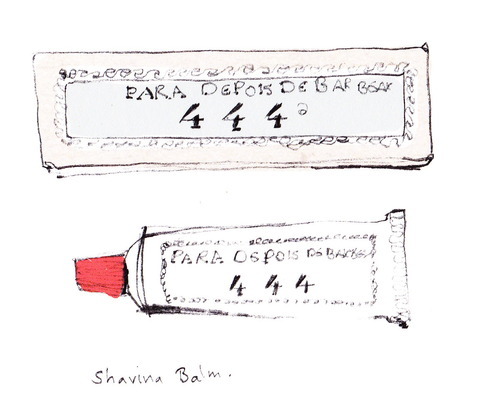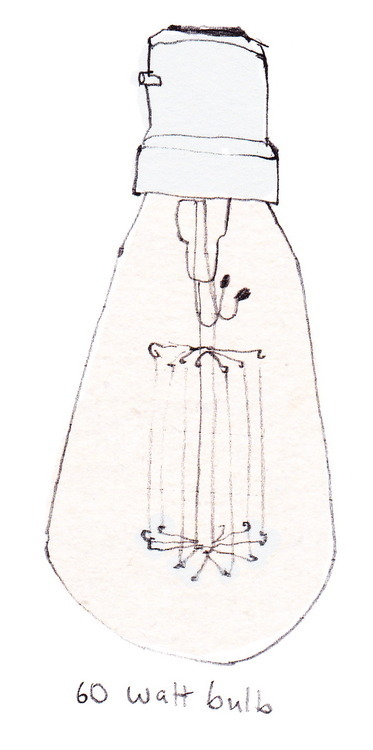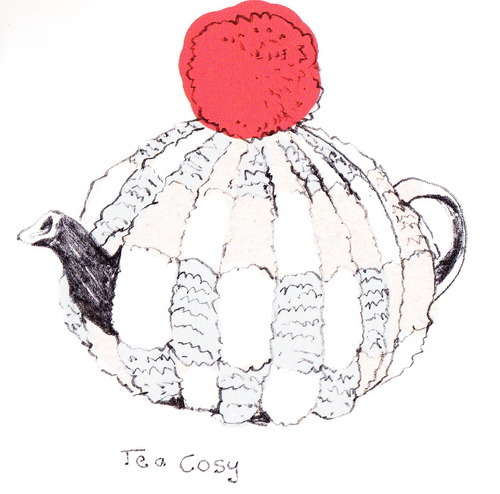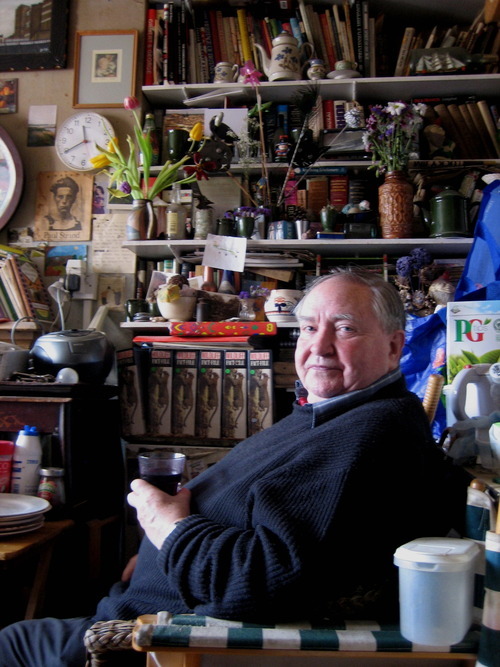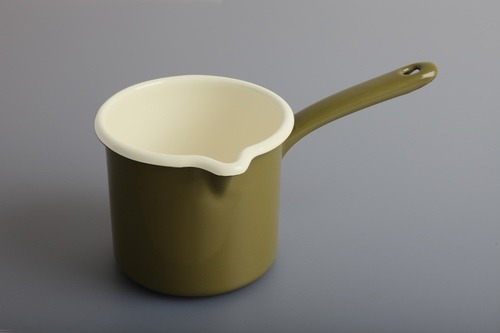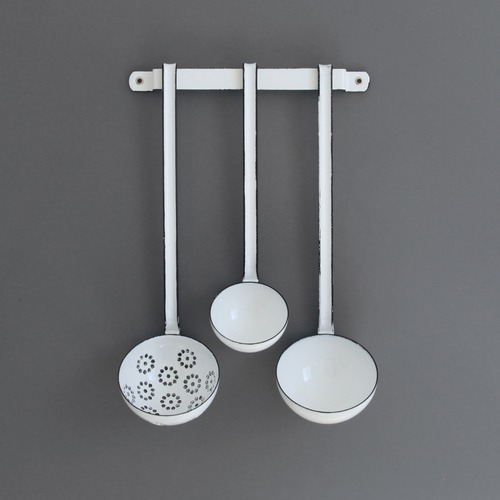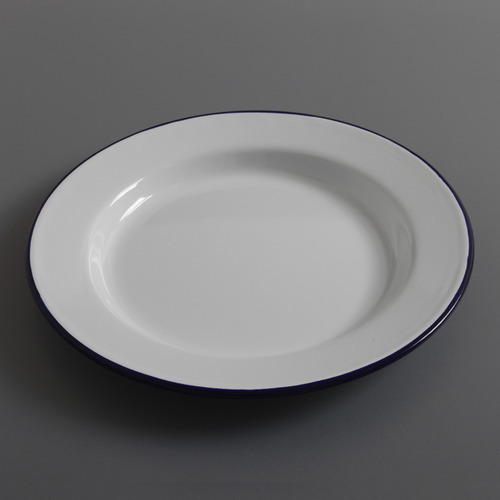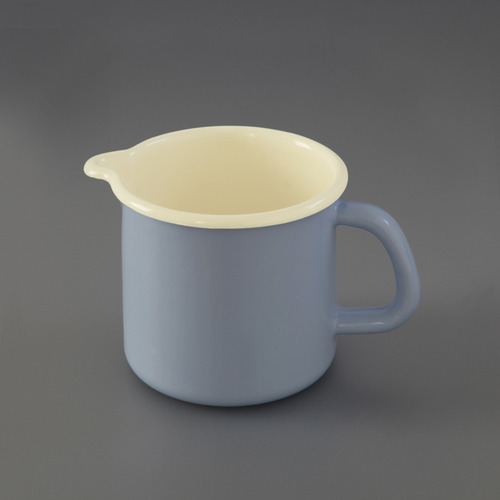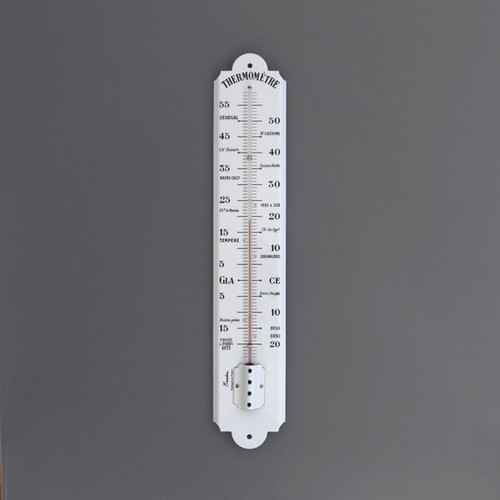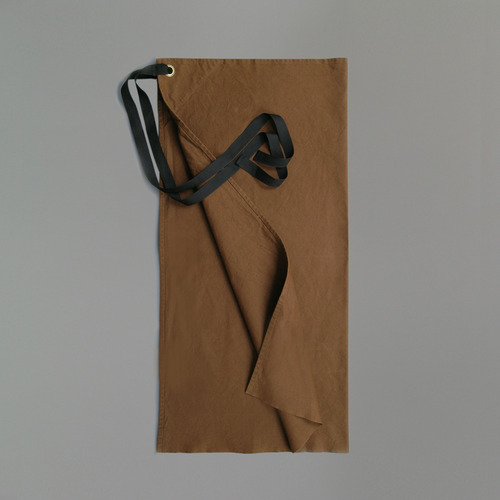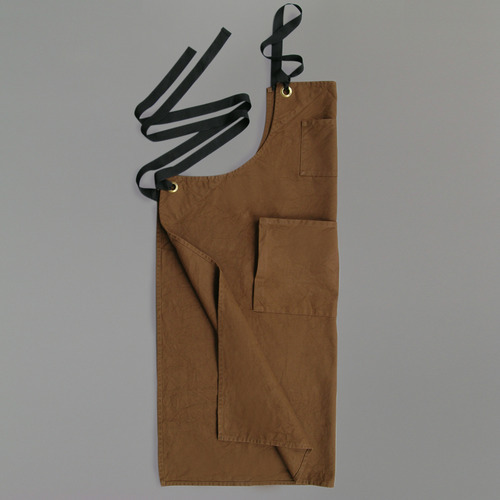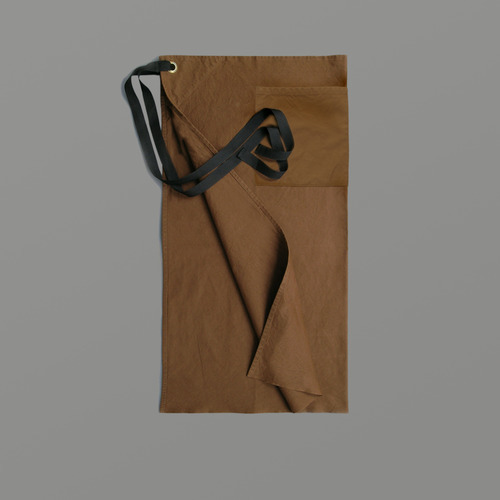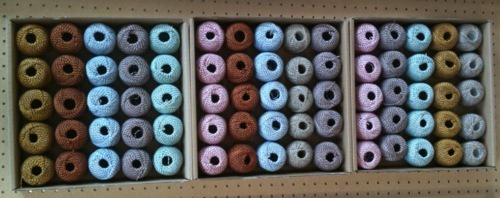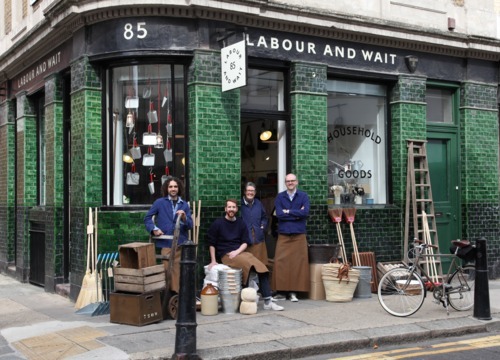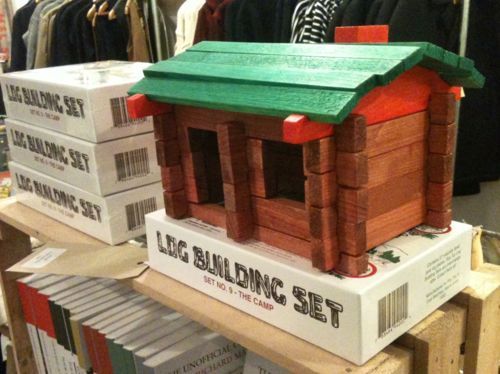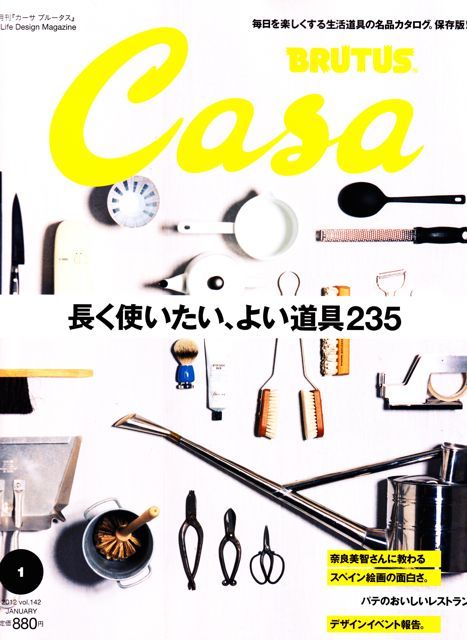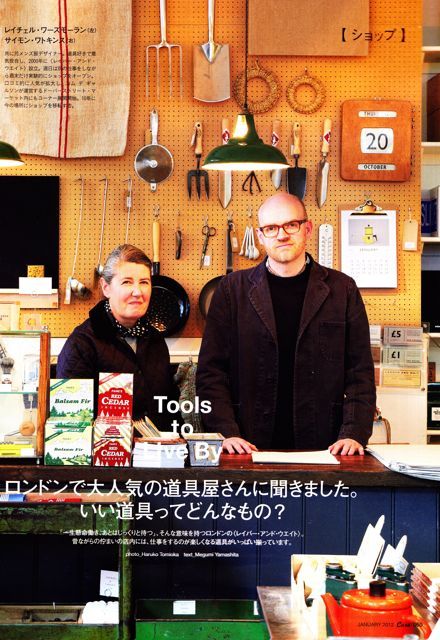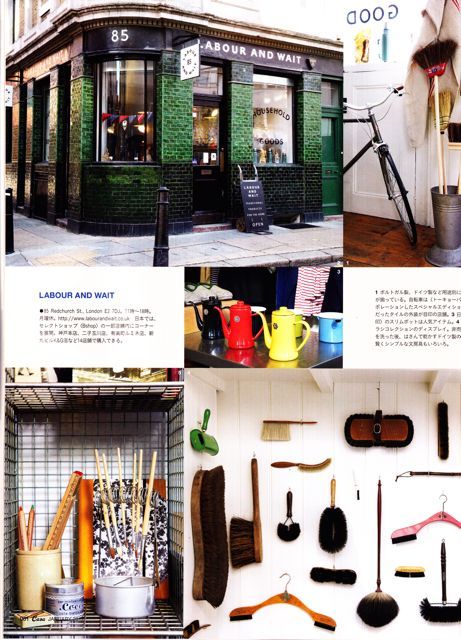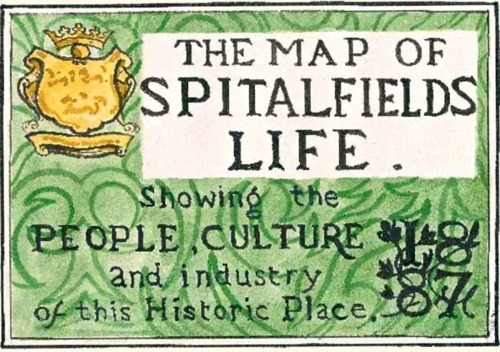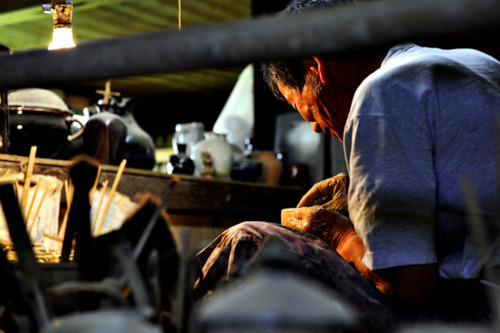 FOOTROPE KNOTS was established in 1980 by Des Pawson, an expert in knotting and sailor's rope work. Based at his home in Ipswich, working alongside his wife, he produces traditional ropework articles. His interest extends to a rope and knot museum situated in his garden.
FOOTROPE KNOTS was established in 1980 by Des Pawson, an expert in knotting and sailor's rope work. Based at his home in Ipswich, working alongside his wife, he produces traditional ropework articles. His interest extends to a rope and knot museum situated in his garden.
July’s Tools of the Trade come from R. Russell Brush Manufacturers, a family business with over 160 years experience in brushmaking.
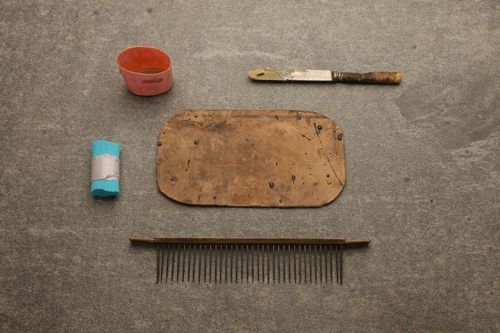
From this company we sell a selection of handmade all-natural bristle brushes, including a Banister Brush and a Clothes Brush - available online - and an Indoor Broom and a long-handled Cobweb Brush, available in our Redchurch Street store.

That august chronicler of London life the Gentle Author has written about the history of R. Russell on the Spitalfields Life blog, so to learn more about the history of the company and the six generations of brush-making Russells please take the time to visit this fascinating site. In the meantime Robert Russell will take us through the tools involved in the manufacturing process.
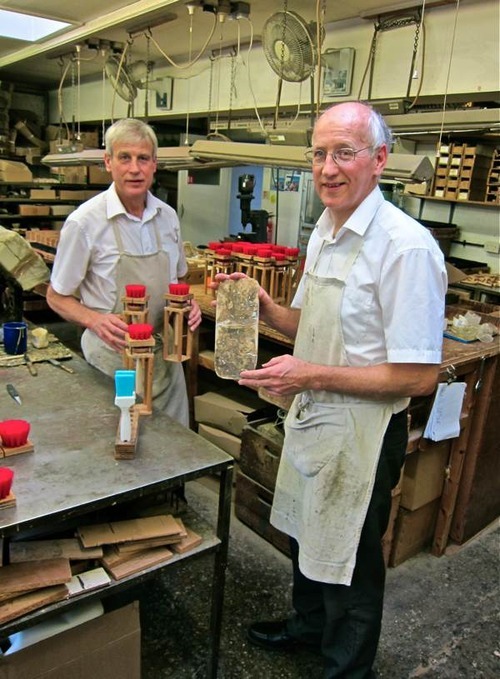
“The plastic cup is used for hand mixing the epoxy cement. If only a small amount is required we use this cup, if we need a larger amount it is dispensed via a cement mixing machine. The knife is used to wipe the plastic cup of any excess dribbles when pouring.”
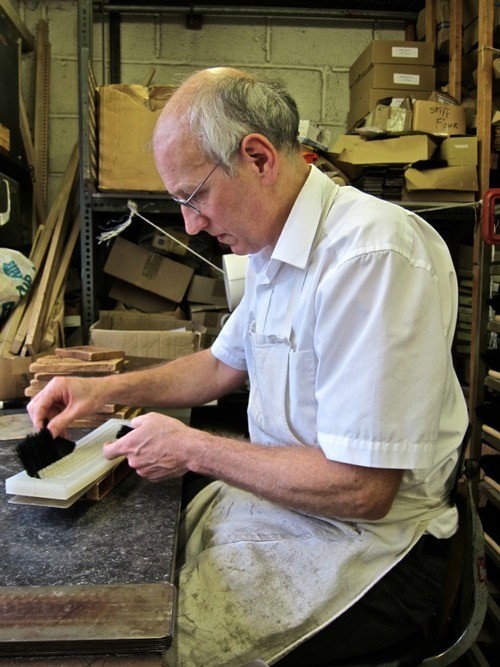
“The cardboard flapper is then used for patting down the filaments of the brush into the cement.”

“The blue cylinder is a wrap of a polyester material, used for brushes in food environment applications, such as pastry brushes etc.”
Russell make a huge variety of brushes for many different applications, but all of the brushes for Labour and Wait are made with natural bristle.
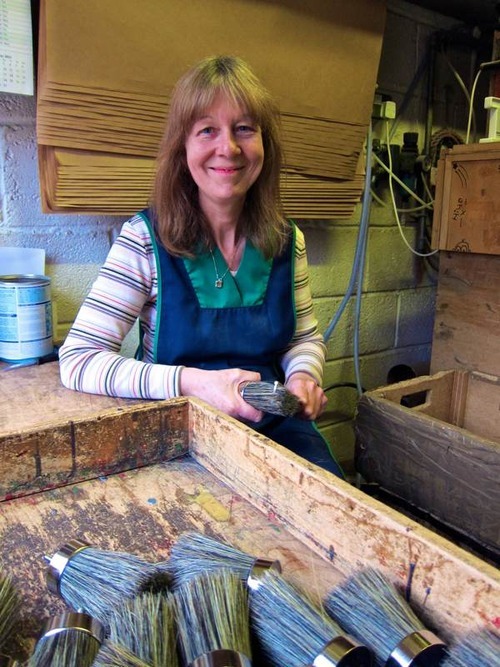
“Finally, the comb is just used to tease out loose strands which for what ever reason haven’t penetrated the cement.”

R. Russell’s long history as a brushmaking company was threatened by the growing availability of cheap mass-manufactured brushes from the far east, but in recent years they have found that their high-quality hand-made brushes have found an appreciative audience amongst discerning customers. There will always be a place in the home for quality products, and so we are proud to sell the Russell brushes, each one branded with the proud slogan “MADE IN ENGLAND”.

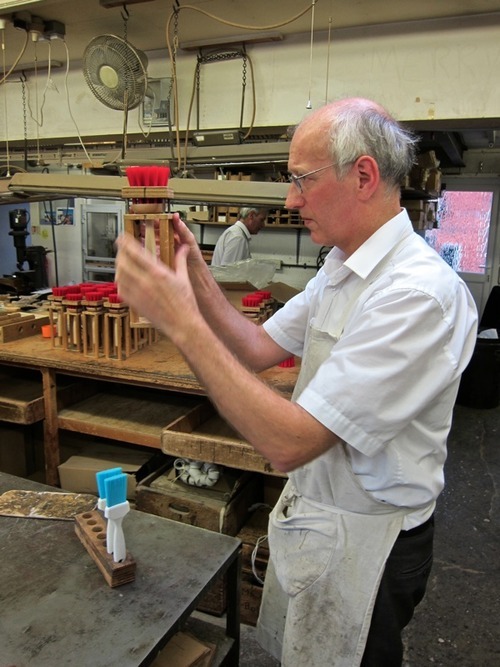
Our thanks go to Alan and Robert Russell, and to the Gentle Author for allowing us to use the Spitalfields Life photographs.

 R. RUSSELL are in their sixth generation as brush makers. They are believed to be the oldest family run business in Chesham, where brush making was once a thriving industry within the town. Almost all of their brushes are handmade utilising skills passed down from previous generations.
R. RUSSELL are in their sixth generation as brush makers. They are believed to be the oldest family run business in Chesham, where brush making was once a thriving industry within the town. Almost all of their brushes are handmade utilising skills passed down from previous generations.
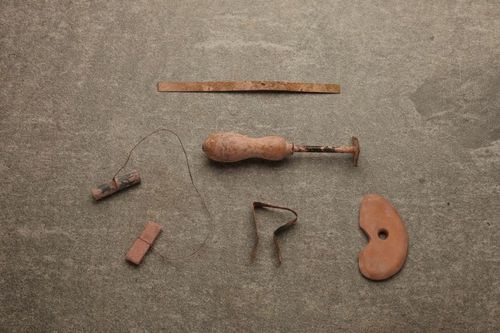
June’s Tools of the Trade takes us on a trip into the heart of the English Cotswolds, where we find the small town of Winchcombe and the Winchcombe Pottery.

From this small studio workshop we stock a selection of hand thrown pouring bowls, in three sizes and two glazes.

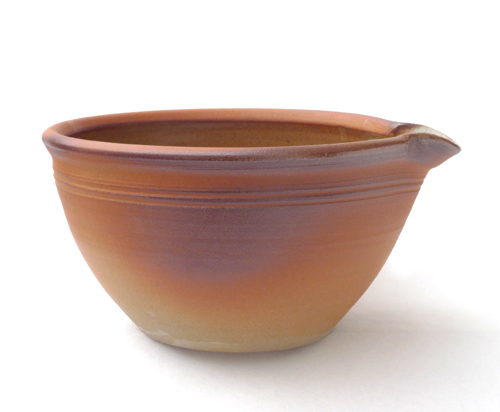
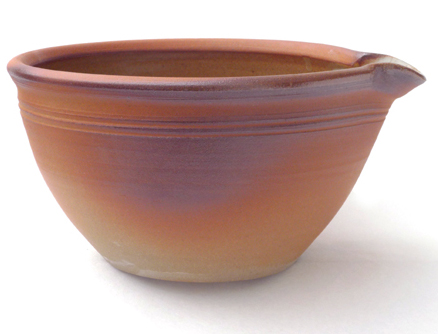
These beautiful bowls are fired in a wood-burning kiln, and it is this firing process which gives each bowl its unique appearance. Irregular colouring and scorch marks created by the smoke, soot and ash characterise each object, and the resulting depth of colour and complexity means no two bowls will ever be exactly alike.
The outside surfaces are left unglazed, revealing to the touch the rough clay surface, while inside one of two glazes is used:
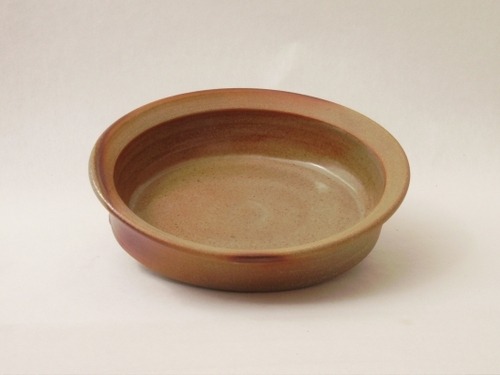

The clear glaze reveals more of the natural wood-fired colouring inside the bowl, while the dark tenmoku-like glaze adds depth to the finish, the oxidisation process creating its own irregular patterning in shades of brown and black.
Customers - and staff - will often deliberate long and hard over which particular bowl to buy, as each one is truly a unique item.
The Winchcombe Pottery can trace its history back to 1926, when a 25 year old potter named Michael Cardew rebuilt and reopened the local Becketts Pottery. Cardew had trained under Bernard Leach, the man responsible for the rebirth of craft pottery and the Studio pottery movement in the early years of the twentieth century; Leach believed that the potter’s focus should not be on decoration or embellishment but in the tactile and functional perfection of objects designed for everyday use, and Cardew’s ambition was to reopen the pottery as a place where traditional, functional and affordable wares could be made for the local population.

To help him in his task, Cardew hired two men; Elijah Comfort, the 63 year old chief thrower at the Becketts pottery, and 14 year old Sydney Tustin, a local lad whose first task was to turn the wheel for the elder potter. As the pottery established itself, the team expanded, Sydney’s brother Charlie Tustin joining in 1935 and Ray Finch a year later. Finch, from South London, had originally travelled to Gloucestershire to find work at the pottery in 1935 but Cardew instructed the young man to learn his skills first, so Finch studied at Central Saint Martins before joining Michael, Elijah, Sydney and Charlie at Winchcombe. Cardew himself, however, only stayed at the pottery for another three years before leaving for Cornwall where he set up the Wenford Bridge pottery, and so in 1939 Ray Finch took over the running of Winchcombe.

The team at Winchcombe in 1947 - Ray Finch is standing on the left.
In 1974 Finch and Winchcombe opened their first wood-fired kiln, establishing the process which defines Winchcombe pottery today. The wood firing introduces the essential element of random to the process, transforming the local clay into functional, practical, unique objects. Earth, water, wood, fire and ash, feldspar, limestone and iron oxide; the ingredients which create the magical transmutation which is stoneware pottery.

Ray Finch hard at work building a wood fired kiln, the essential element in Winchcombe Pottery.
So what tools are used in the production of these bowls? Ray’s son Mike explains them for us:
“On the left side is a wire for cutting off the pot from the wheel. The top and bottom middle are metal banding strips used in trimming and turning leather-dry pots, as is the paint scraper in the centre.”

“The wooden rib on the right is for smoothing throwing rings - especially on the inside of bowls."

Each bowl is hand thrown and hand finished, before being stamped with The WP mark that signifies the Winchcombe Pottery.
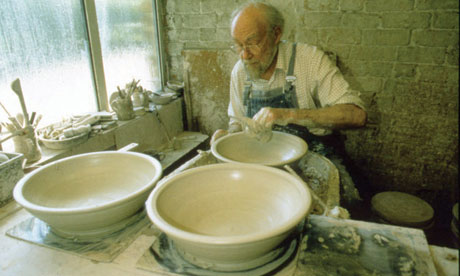
Sadly, Ray Finch passed away in 2012. He had worked at Winchcombe for over 70 years and trained and inspired generations of potters. A website has been set up to celebrate his life and honour his achievements - Ray Finch 1914 - 2012.
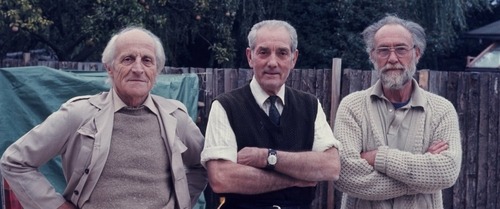
The original Winchcombe team of Michael Cardew, Sid Tustin and Ray Finch.

Mike and his team are carrying on the tradition established by his father and the original potters, and still make their wares in the same way. Hand thrown, hand finished and wood fired. Our thanks go to Mike and all at Winchcombe for sharing their tools and their story with us.
Unfortunately due to the unique and varying nature of these items and their limited availability we are unable to sell them on our website. If you are interested in buying one you can visit our Redchurch Street store or email us using info@labourandwait.co.uk.
For more information on Bernard Leach and studio pottery you can read our story about the Syussai Pottery here.
We have been selling local author Clive Murphy’s ‘Ordinary Lives’ first editions for many years now. We were delighted when we heard that after purchasing a book from us, Pan Macmillan would be republishing one of the series.
'Love, Dears’ will appear in a paperback edition, retitled as 'Up in Lights’. The novel tells the dramatic story of former chorus girl Marjorie Graham, as recorded in correspondence and conversation with Clive Murphy.
The original first editions of 'Love, Dears’ are available in store and online.
 WINCHCOMBE POTTERY was reopened in its current incarnation, in 1926 by the potter Michael Cardew; there having been a pottery on the site since 1800. Cardew's ambition was to make domestic ware for everyday use. Under the subsequent direction of Ray Finch a wood fired kiln was built in 1974 and has been in use ever since.
WINCHCOMBE POTTERY was reopened in its current incarnation, in 1926 by the potter Michael Cardew; there having been a pottery on the site since 1800. Cardew's ambition was to make domestic ware for everyday use. Under the subsequent direction of Ray Finch a wood fired kiln was built in 1974 and has been in use ever since.
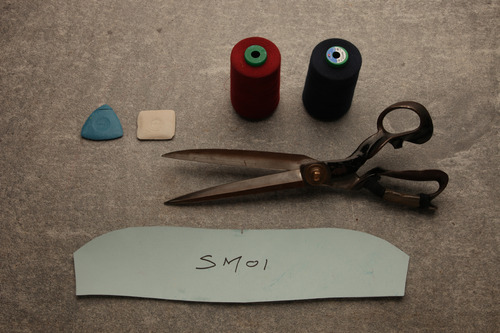
May’s Tools of the Trade takes us to Great Yarmouth, where Yarmo have been manufacturing their Fisherman’s Smock since 1898.
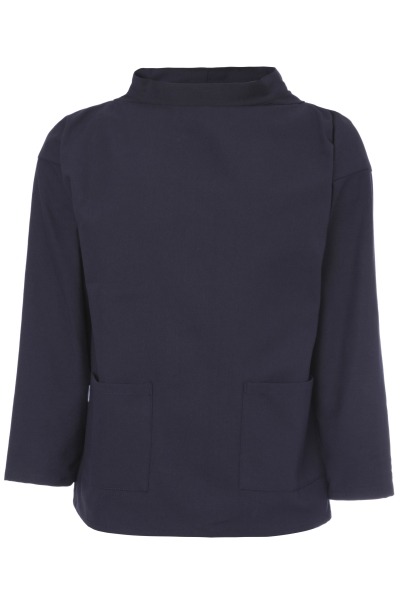
This classic piece of workwear has been an essential outerlayer for British fishermen for over a century, but it has also been popular with painters, sculptors, potters, craftsmen… and shopkeepers; most of us here at Labour and Wait have one. So what is it and why do we like it? Let us explain.

The fisherman’s smock is a classic example of functional, utilitarian clothing. This Folkestone fisherman is wearing the traditional pocketless version - cut from sailcloth, this garment was a strong and sturdy extra layer that kept the wearer warm and dry, protected his woollen jumper, and was comfortable and easy to work in. The short sleeves prevented the cuffs getting wet - a feature also seen on guernsey jumpers and breton shirts - while the tight fit and high neck ensured maximum protection from the elements.
The Yarmouth Stores supplied this and other items of clothing and chandlery from their harbourside warehouses on the outermost tip of the east of England. By 1914 they had opened up branches in ports all around the coast, from Brixham and Padstow in Cornwall to Grimsby, Hull and North Shields all the way up to Lerwick in Scotland. The fishing fleets moved around the coast, so a shop would be opened up for two or three months and as the herring shoals moved on the shop stock would be put aboard a drifter and transported to the next port.

By 1910 and the heyday of the herring industry Yarmo were supplying smocks to fishing communities throughout Great Britain. But it wasn’t just a uniform for fishermen to work in - the practical, utilitarian nature of the fisherman’s smock meant it was adopted by many artists and artisans.

Here Barbara Hepworth wears a smock as she sketches. In the early decades of the Twentieth Century St. Ives in Cornwall became a popular destination for artists and we can imagine the inspiration provided by the smocks being worn by the local crews - such as this rather motley bunch from along the coast in Mousehole. The cheap, tough, easy to find smocks provided the perfect protection for artists as well as sailors.
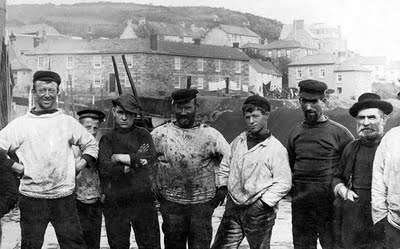
These white smocks show their sailcloth origins, and they are still made from the same material today, in particular a blue sailcloth which washes and ages beautifully, very much like good denim. The only alterations for the modern sailor or artist are longer sleeves and two patch pockets.
So what of May’s Tools of the Trade? Chalk, shears and thread, the essential tools of the tailor. But Yarmo’s process has been modernised from the days of chalking patterns by hand. Sharon Bowles, Factory Manager at Yarmo, talks us through the manufacturing operation:
“Patterns are printed via computer to a plotter machine by Barry our cutting room supervisor. We have kept the old card patterns for back-up, as you never know when you might need them.”
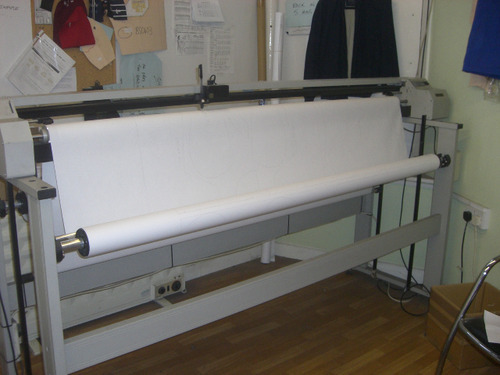
“Once the pattern has been drawn up on paper it is labelled with a job sheet ready for laying.”
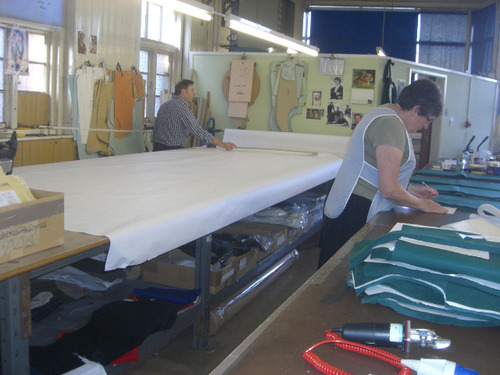
“The required fabric is rolled out and measured to the lay plan. The quantity is checked and the fabric is laid up depending on the number of garments required.
Lorraine is now ready to cut the lay out, the knife she uses will depend on the depth of the cloth in the lay.”
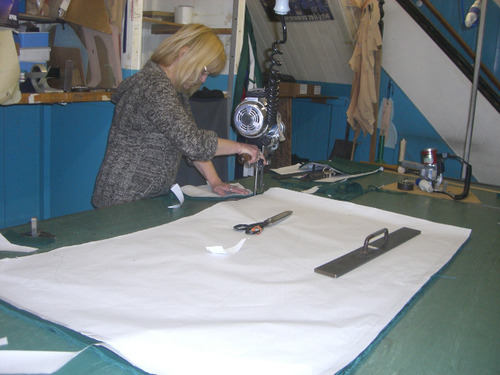
This is the largest of Yarmo’s cutters, but other sizes are used depending on the size of the lay.

“Once the lay is cut it is then passed to Sue to be fitted up into bundles of work with a work ticket ready for the machinist.”

The ‘bundle up table’.
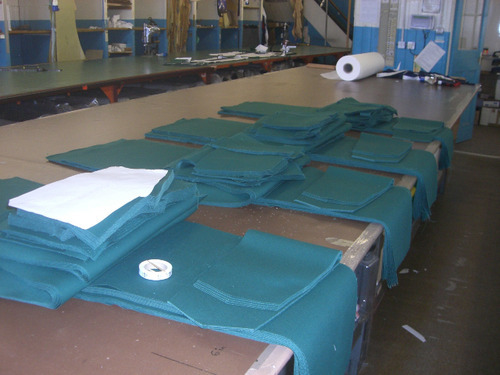
“These bundles are given out to the girls on the flat machines who stitch on the pockets, labels and collars.”
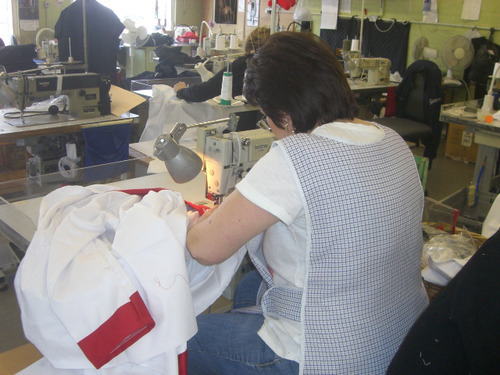
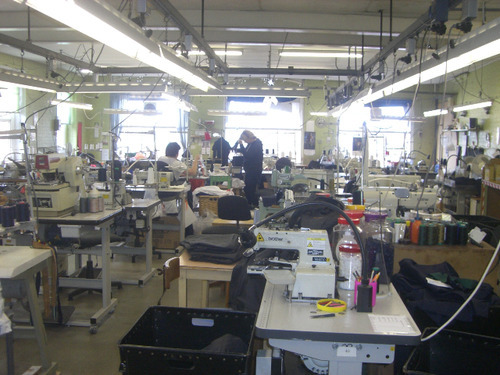
“After this, the bundle is passed to an overlocker to have the sleeves sewn in and the body sewn together.”

“They pass the work back to the flat machinist who hems the sleeves. The complete bundles finally go to the finishing machines and through to quality control. Once the garments are checked over by Debbie she labels and bags them ready to go to Lionel in the warehouse - and ready for despatch to our customers.”
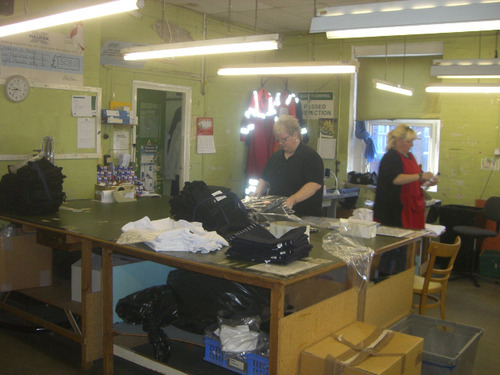
“Although smocks are still popular today, they are worn more for leisure wear - although I do know of some fisherman who still wear our smocks for fishing.”
Whether for sailor or sculptor, the fisherman’s smock is very much the traditional garment that is as wearable today as it ever was. Our thanks go to Sharon and all at Yarmo for sharing this information and for supplying us with pictures.
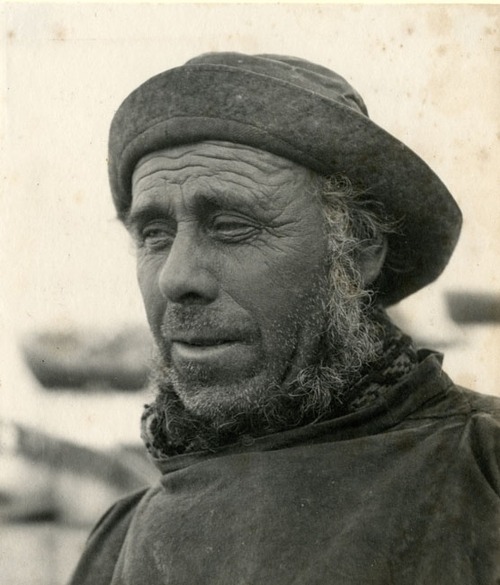
The author wearing his smock, yesterday.
Pictures from the National Maritime Museum Archive and the Pentreath Photographic Archives. Photograph of Eli Farrow the fisherman by Walter Clutterbuck, from the Norfolk County Council Library.
 YARMOUTH STORES were incorporated in 1898, the company supplied all types of fishermans' requisites from rope and groceries to tobacco and waterproof clothing. During the 1930s a factory was established in Great Yarmouth producing smocks and overalls for the fishing industry, a practice that continues to this day.
YARMOUTH STORES were incorporated in 1898, the company supplied all types of fishermans' requisites from rope and groceries to tobacco and waterproof clothing. During the 1930s a factory was established in Great Yarmouth producing smocks and overalls for the fishing industry, a practice that continues to this day.
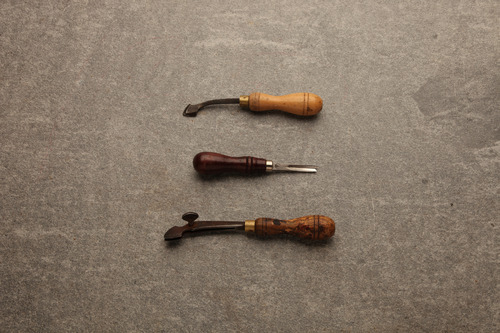
April’s Tools of the Trade have kindly been supplied by E Jeffries and Sons, saddlers and leatherworkers, and manufacturers of the Brady range of bags.
The Brady company can trace its history back 140 years, and is the label of choice for many of this country’s most discerning hunters, shooters, fishers and royals. Chris Hodgkiss from Jeffries explains the tools:
“(At the top) SINGLE CREASE and (at the bottom) DOUBLE CREASE: These tools are used for veining on the edge of the leather to give it a single or double crease. These tools must be heated before use.
EDGE TOOL (in the middle): This tool is used for edging the sides of leather strap work to give a smooth, round edge.”
This finishing can be seen on the leather straps of our Khaki Fishing Bag ( above ) and our Bridle Leather Belt ( below ). Made in Walsall, England since 1928, the Fishing Bags are produced by skilled craftsmen using the best quality bonded canvas and bridle leather. Although the belts can’t trace their heritage back this far, they too are made in Walsall, hand stitched and then veined, burnished and polished by hand.
The sharp, deep crease on the leather is the perfect finishing touch for both.
Each Brady Fishing Bag contains a removable rubberised lining to ensure your freshly caught trout doesn’t get your laptop or newspaper wet. The triple layered waterproof canvas and bridle leather straps and trim are of the highest quality and mean these bags will stand up to many years of hard use.
The Folio Bag is a design we found in the Brady archives, and is made exclusively for Labour and Wait. Originally a post / despatch bag this design has found a new lease of life thanks to its unique dimensions - it is ideal for large laptops, folders, portfolios, etc. The bonded canvas is waterproof and the bridle leather ensures the longest life for this stylish and durable bag.
We love selling products that are hand-made or hand-finished, particularly if they are made in England, so these Brady bags and belts are some of our favourite Labour and Wait items. Our thanks go to Jeffries and Sons for the loan of their tools.

 E JEFFRIES & SONS have been making saddles since 1820. Today they continue to make high-quality equestrian accessories and leather goods in their workshops in Walsall. They are also renowned for their handcrafted traditional game and sporting bags.
E JEFFRIES & SONS have been making saddles since 1820. Today they continue to make high-quality equestrian accessories and leather goods in their workshops in Walsall. They are also renowned for their handcrafted traditional game and sporting bags.
The good people at Port Magazine came in to interview Simon and Rachel last week. Our normally publicity-shy owners made an exception for this publication, as we are all fans of its intelligent approach and well considered aesthetic. The interview is now online here. ( By Chris Chasseaud with pictures by Liz Seabrook ).
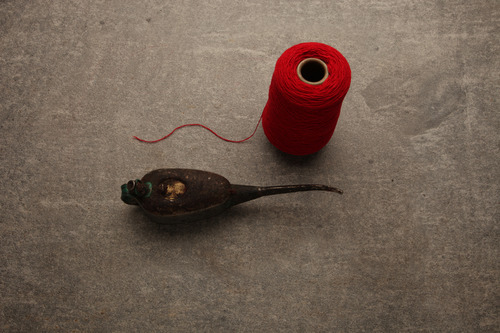
March; and Elvet Woollen Mill take their place as our calendar pin-ups. And from them we have an oil can and a cone of red yarn, both of which are used to make our Welsh Tapestry Blankets.
Elvet Woollen Mill is one of the last remaining working woollen mills in West Wales, and has a history dating back over 120 years. For the past 30 years it has been run by Mike Tolputt and his family. And Mike is the best man to tell us about his tools:
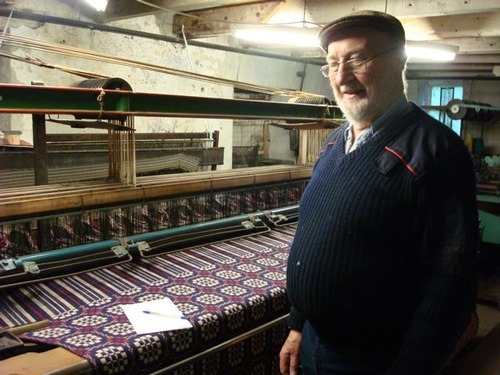

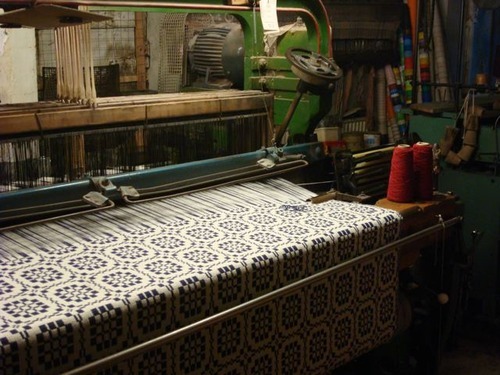
We have sold these beautiful blankets for years at Labour and Wait. We source vintage and antique blankets from all over Wales, and we never fail to be astounded by the brightness and variety of the colours. However, as their popularity has increased, so has their price, and it becomes harder to find the spotless - and the mothless - examples we are looking to sell. So we were very pleased to find Mike and his mill producing high quality modern versions.
At the moment we sell the blanket in the red, white and black colourway, but there are rumours of new colours being prepared just for Labour and Wait…
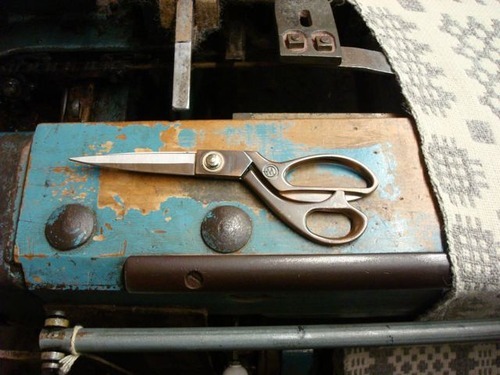
“The cone of red yarn is a sample of dyed yarn used to make our Welsh Tapestry Bedspreads. It is a blend of 100% pure new English Wools spun specially for us by a long established firm in Huddersfield. It is then sent onto Bradford where it is dip-dyed using well established traditional methods.”
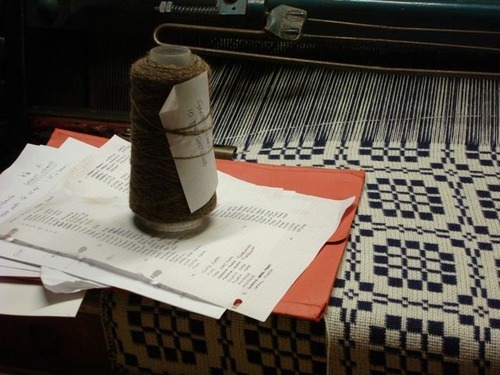
“The natural yarns used in our Tapestries are from Wales and are, of course, the natural colour of the fleece with no dyeing involved.”
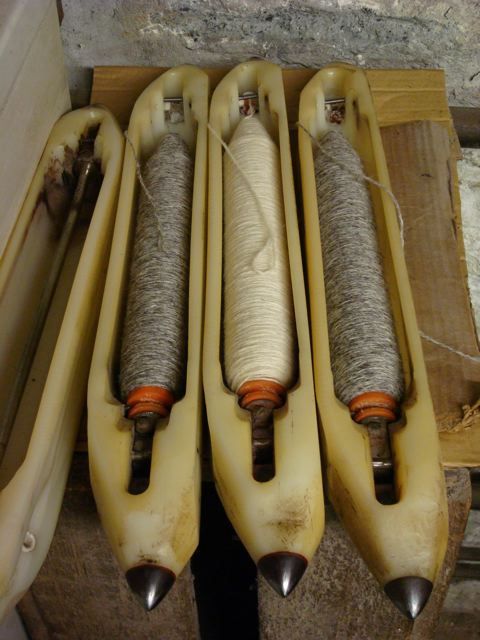
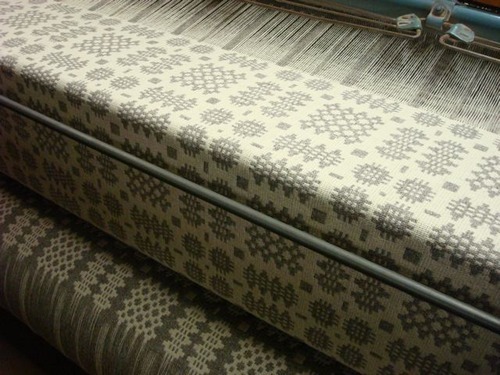
“Did you know that 7 miles of yarn is required to make 1 Double Size Bedspread, and in doing so the threads will cross over each other 5.3 million times. WOW.”

WOW indeed, Mike. It sounds like a lot of work, but at least we have something wonderful to show for it.
Our thanks go to Mike and Alison at Elvet for showing us their mill, and for revealing the intricacies of the Welsh Tapestry Blanket.
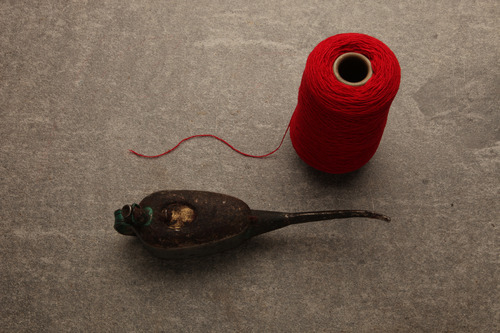
Deep in a valley in the foothills of the Austrian Alps, along the Iron Trail, in the shadow of Ore Mountain, we find the Mile of Forges - and an old Blacksmith’s Cottage.
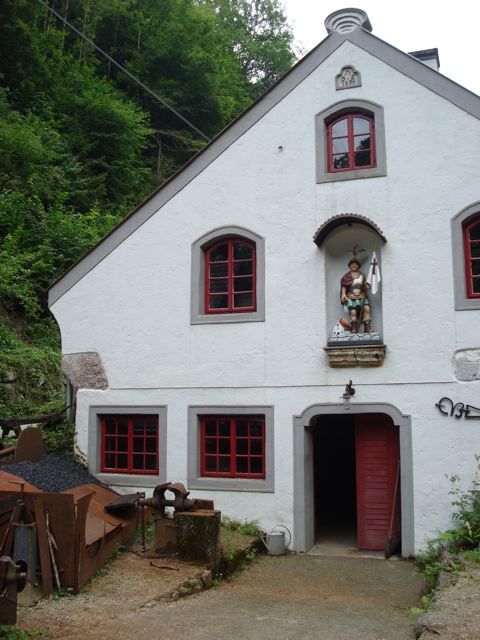

Inside, sat at the forge hammer, or stoking the fire - as he has done for 500 years - we find the smith himself.


At one time 69 privileged blacksmiths worked in this area, with another 90 who survived without the Imperial Favour. Their products were exported to all parts of the Austrian Empire - to Bohemia, Moravia and Trieste, as well as further afield to Germany, Prussia, Italy, Poland, Russia… and out to the Middle East and beyond.
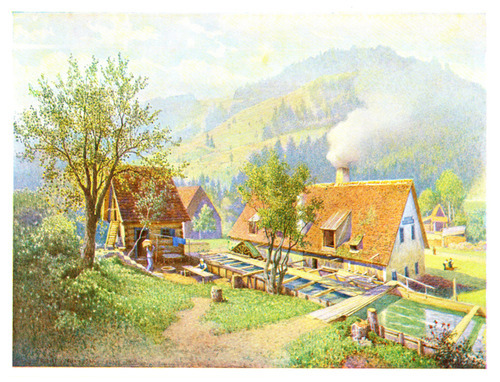
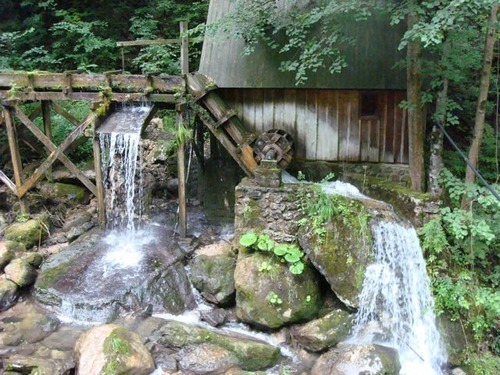
The Alpine streams provided the power, the forested hills the fuel and Ore Mountain the raw material. The valley rang to the clang of metal on metal.
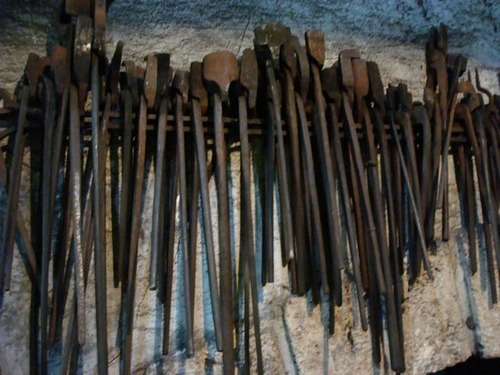

Today the descendants of these ‘Black Earls’ are still in business, with their modern forges and factories still sending their ironwares out around the world. But there are still one or two smiths sat at their forges, crafting their tools by hand in the way they always have.
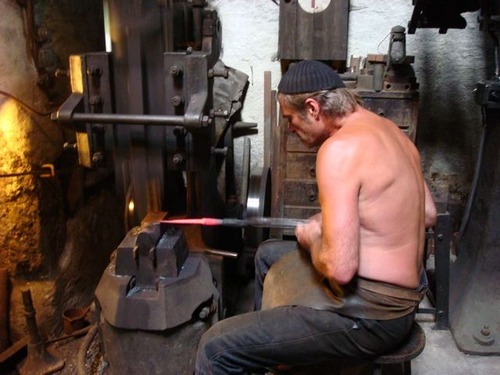
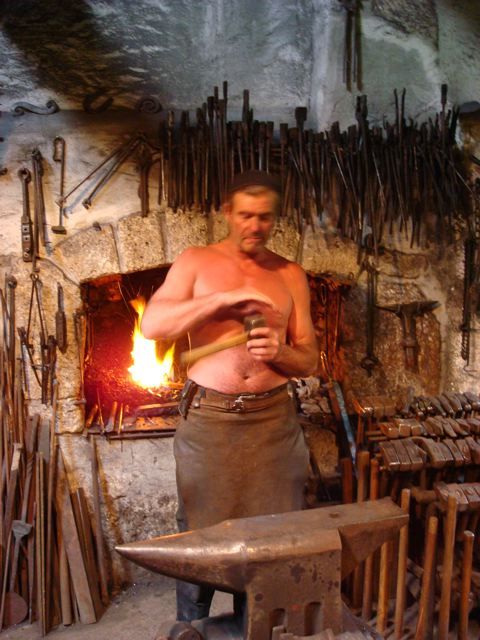
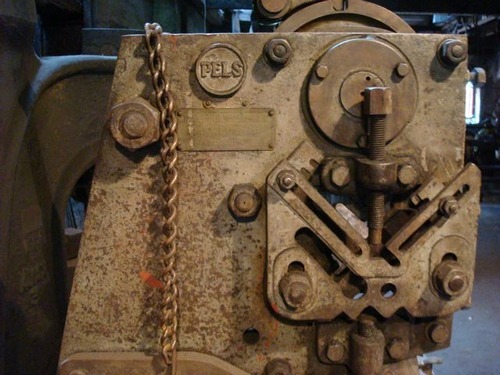
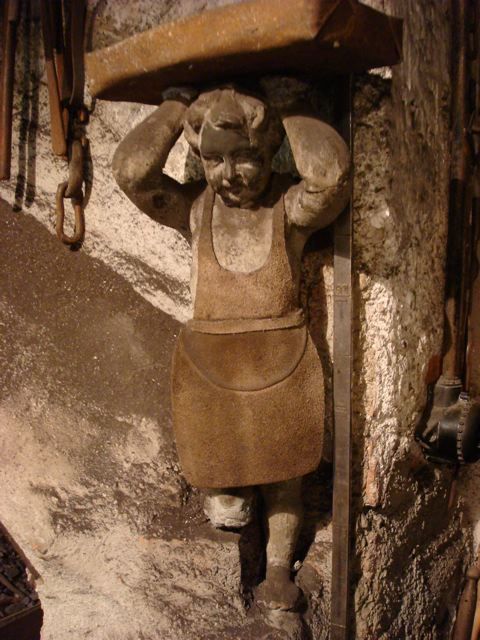

So deep in the valley in the Austrian Alps, along the Iron Trail, in the shadow of Ore Mountain, in the Mile of Forges, think of the Blacksmith sat at his hammer forge, in the living metal workshop, as he has for 500 years.
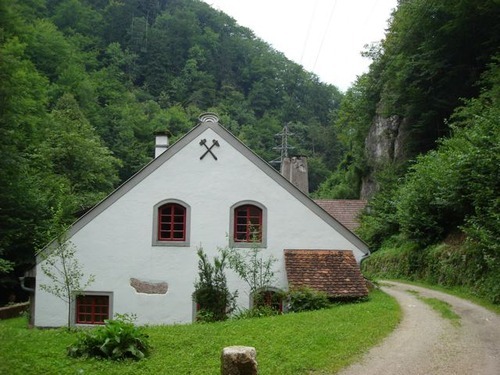
 ELVET WOOLLEN MILL is one of the few remaining working woollen mills in West Wales. The mill itself has a history dating back over 120 years. Family run, this historic mill weaves traditional Welsh textiles on original looms.
ELVET WOOLLEN MILL is one of the few remaining working woollen mills in West Wales. The mill itself has a history dating back over 120 years. Family run, this historic mill weaves traditional Welsh textiles on original looms.
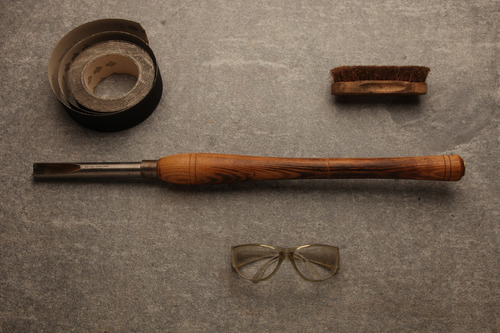
February sees Creamore Mill take their place as the stars of our Tools of the Trade Calendar. Established in 1981 in rural Shropshire, this family-run business designs and hand-turns all of their wooden products in the former corn and wood mill which gave its name to their business. From their extensive range of functional and practical household and garden items we have selected the Wooden Door Wedge, Twine Stand and Dibber.
Sam Buckland, son of business founders John and Cathryn Buckland, kindly gave us an explanation of each of the tools pictured:
“The goggles should be self explanatory, especially so when you see the direction in which the shavings generally leave the cutting tools while turning wood.”
“The gouge is a versatile turning chisel, used for both rough turning of blanks from a square down to the finishing cut. The long handle provides good leverage to control the angle of attack. An example of use is turning the bishop twine stand bases – square blanks are band sawed into discs and then mounted on a lathe. The gouge makes the straight roughing cut at the circumference, a finishing smooth cut and the adjacent bevel profiles.”
“Our hand chisels are made in Sheffield from high speed steel; an excellent balance between edge sharpness and durability for wood turning.”
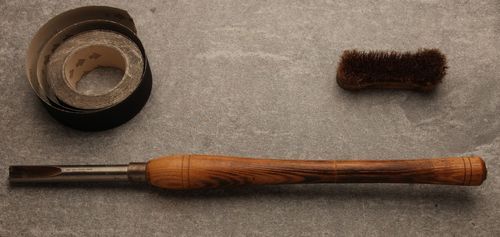
“The roll of sand paper is one of several with different grits, of graduating coarseness. While the work piece is still turning on the lathe the sand paper is used to smooth the final profile, knocking off the wood fibres from the end grain and corners. Sand paper also introduces a more uniform surface in preparation for certain finishes.”
“The bronze brush is used in general tool cleaning. The release of wood resins during working can leave a build-up of grime on the tools. The softer bronze bristles avoid damage to the cutting edges.”

With three decades of experience and a simple collections of tools, Creamore Mills are justifiably proud of their artisan approach. Our thanks go to them for allowing us to photograph their tools, and for Sam’s explanation of their use.
Allow us to introduce our new range of enamelware colours - Riess for Labour and Wait.
Since we first started selling enamelware from Riess over ten years ago, we have found it to be one of our most popular and in-demand ranges. And as enamelware has experienced its rebirth as a practical and functional material so our range of Riess goods has expanded.
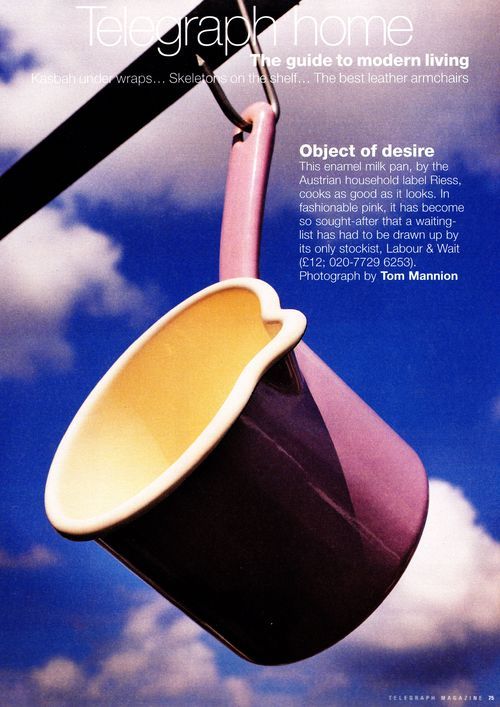
This Pink Milk Pot featured in the Telegraph Magazine in 2002 and led to Sunday morning queues along Cheshire Street and an overload of our fledgling mail-order service.
But as we saw other shops and online retailers selling the same range of milk pots, pans and jugs, we thought we should offer something fresh and new - we pride ourselves on staying one step ahead - so two years ago we created our own range of milk pots in black, green and airforce.
And now we can offer an extension of our Riess for Labour and Wait range. A milk pan, lasagne dish and two milk jugs in our custom ‘Labour and Wait’ colours.
We also introduce a Black Bread Bin to match our Brown Bread Bin -
and each with our Riess for Labour and Wait backstamp -
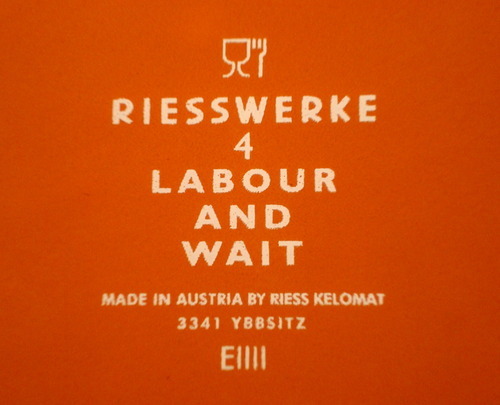
So who are Riess? And why do we like them so much? In a large part it is due to their history. Riess have been producing steel goods in the same location deep in the heart of Austria since 1550 - and high quality enamel items for over 80 years. This heritage ensures the best knowledge producing the best quality goods. It also helps to shape the company’s future, as they know that with such a proud past they must also look after the brand for future generations.
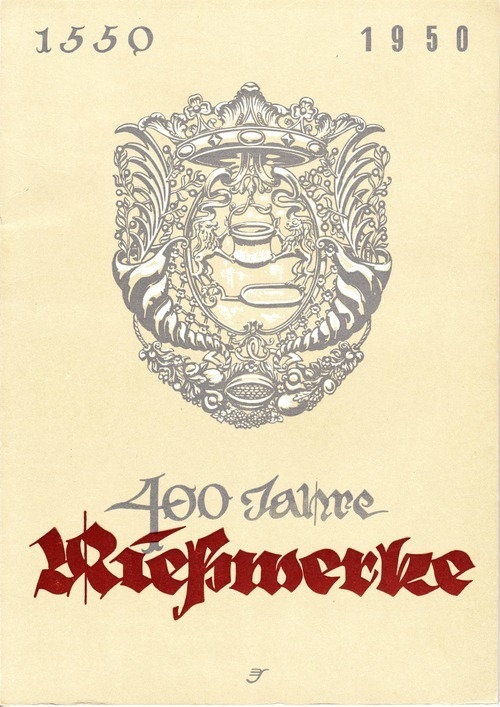

These beautiful illustrations are from Riess’s 400th anniversary celebrations in 1950 - although the factory floor looks much the same today.
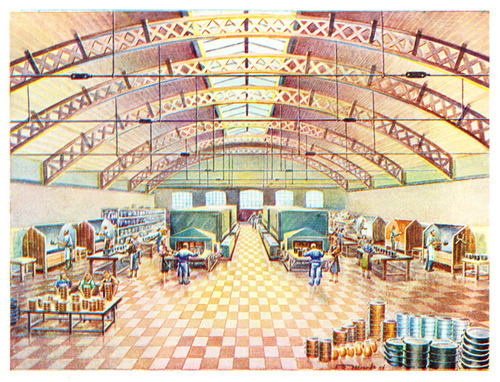
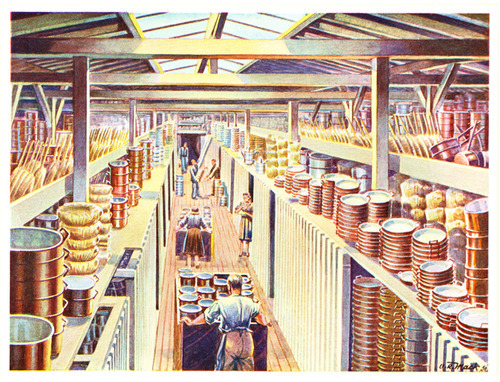
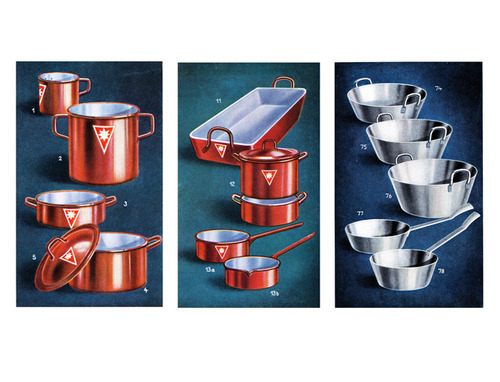

Many of the products we sell here have been in constant production at Riess for over 60 years; this heritage and history ensures the highest quality, especially in comparison to the cheaper, far-eastern made enamel ranges that are appearing more frequently these days.
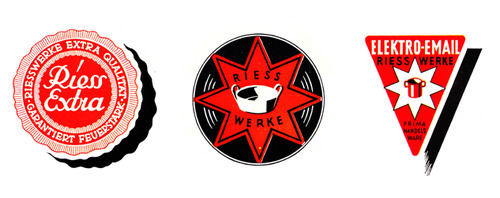
We have been visiting the Riess factory for many years now, to work on new products and colours, and also to see their fantastic archive, from where we have taken these pictures.
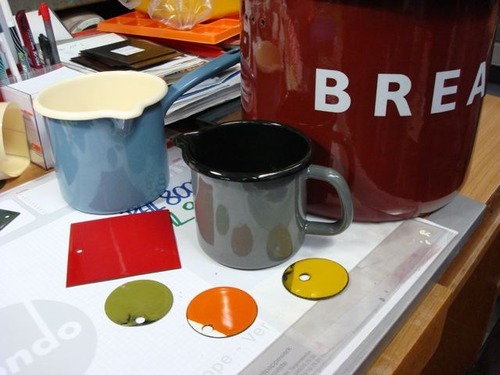
Here we see a selection of the enamel chips we’ve selected as possible colours, and a couple of our Labour and Wait items; the Airforce Milk Pot and the Bread Bin, as well as the new Grey Milk Jug.
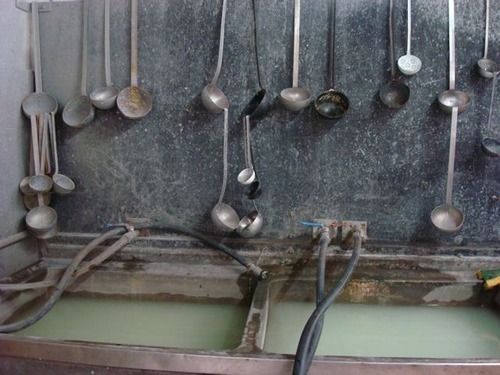
Riess’s knowledge of steelworking also means their kitchenware is of the highest quality, although here our Professional Ladle is used in a more industrial manner.

Simon and Stuart from Labour and Wait and Andres Riess outside the door of the Riess factory.
Riess are also very proud of their environmental policy, aiming to make the smallest ecological impact possible. To this end, in the 1930s they built their own hydro-electric plant, which still to this day powers their entire factory.
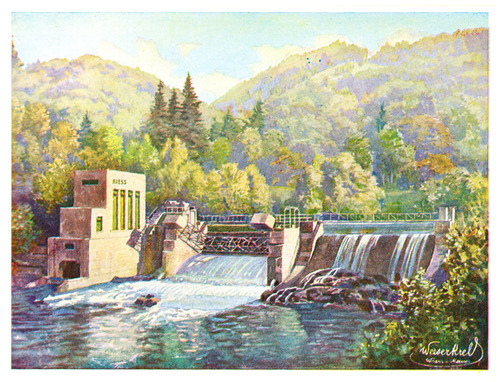






So if you are lucky enough to buy or receive some Riess enamel, you can know that you are in possession of a product of quality and history, all the way from the 'Mile of Forges’ in the foothills of the alps.

For more on enamel, you can read our 3 part Enamelware Guide - Enamel Production, Enamel Qualities and Enamel Care.
 CREAMORE MILL was established in 1981 in rural Shropshire. This family owned woodturning mill produces functional interior and garden accessories with an artisanal approach. All of their products are hand made using timber from sustainable sources.
CREAMORE MILL was established in 1981 in rural Shropshire. This family owned woodturning mill produces functional interior and garden accessories with an artisanal approach. All of their products are hand made using timber from sustainable sources.
Thank you to everybody who bought our 2013 ‘Tools of the Trade’ Calendar. We really enjoyed putting it together and found it fascinating to see some of the tools which are used to make our favourite products. However we didn’t have space on the calendar to explain exactly what these tools were - so here we present the first in a series of twelve blogposts about our Tools of the Trade.
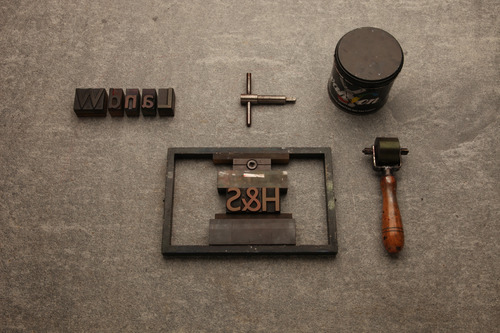
Our first set of tools are used to produce one of our most popular products; our Letter Postcards.

Each one is handprinted by Chrissie and Vicky in 'The Corridor’, their narrow workshop in Tufnell Park, North London - at 1.2metres wide ( or 244 pica ems ), it is just wide enough to pull out a case of type.
From this workshop, using their collection of Adana presses sourced from all around the country, Harrington and Squires produce our cards alongside their own range of printed material, including cards, bookmarks, badges and magnets, as well as offering a bespoke design and printing service.
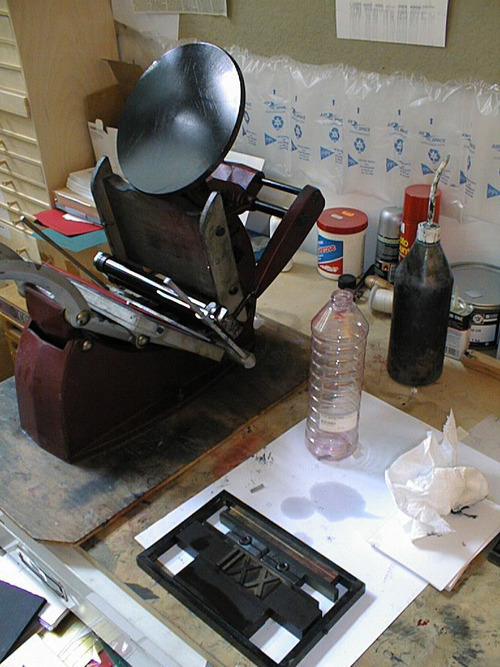
“The name Harrington and Squires is a homage to Bob Harrington and Horace Squires, ex-compositors and letterpress tutors at Hornsey College of Art in the late 60s and early 70s, and it conveys the bespoke quality of our work.”

The first Tool of the Trade is a sample of Gill Sans Titling wooden type. As used on our cards, this classic typeface has been used by Penguin Books, LNER, the BBC and Labour and Wait. Gill Sans is these days seen as a short-cut to mid-century Britishness, but we first loved it for its clean, clear lines and its quiet typographical authority.

Next to the type we have the Cornerstone quoin key and under that an 8x5 Adana chase, which is the frame in which type is secured or locked up ready for printing. The type is padded out with furniture ( pieces of wood or metal ) and tightened up with the quoin, which is a locking device to keep all the items in position in the chase.
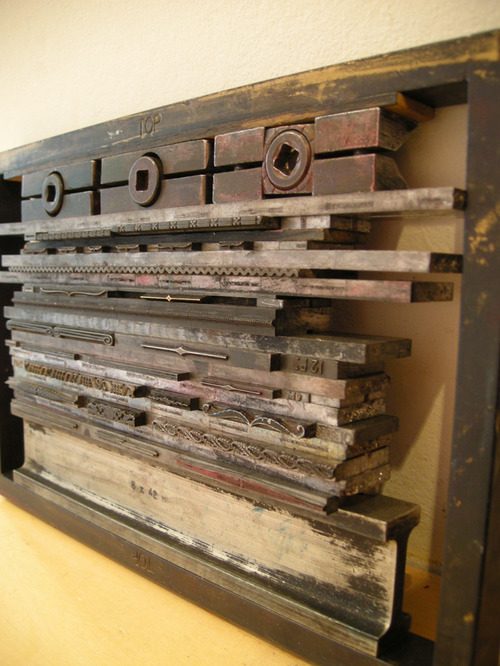
And finally next to the quoin and chase we have a tin of rubber based ink and a roller for inking up the type ready for printing.
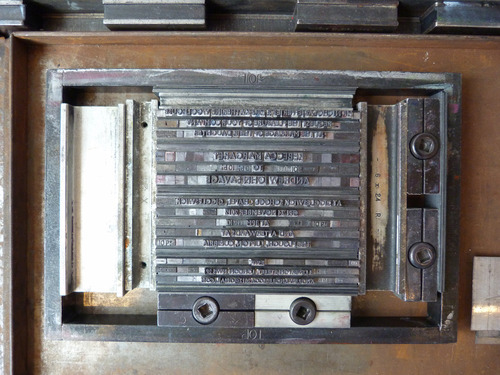
All of these tools are used together by Chrissie and Vicky to make our Letter Postcards.
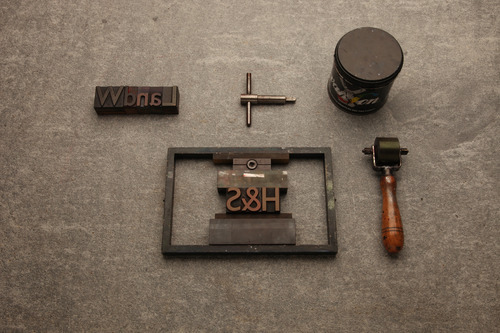
For those who would like to learn more, Harrington and Squires run letterpress workshops to introduce the art and technique of typesetting and printing.
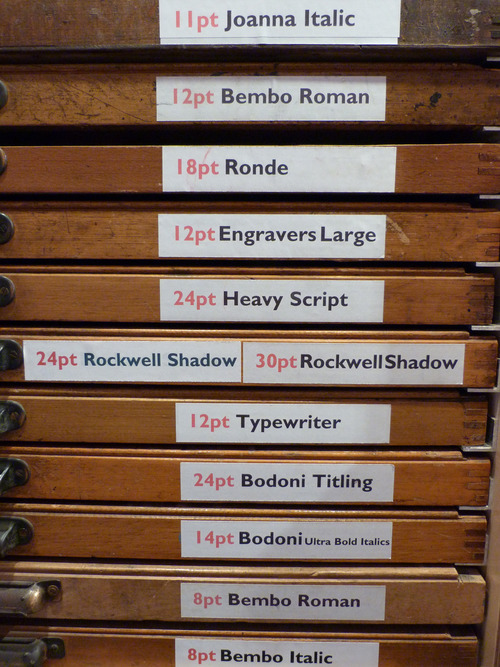
Our thanks go to Chrissie and Vicky for supplying us the tools to shoot, and for allowing us to share their pictures.
We’re back from our Christmas break, and the first thing to do is clear out our storeroom, which has accumulated another 6 months’ worth of samples, seconds and shop soiled goods.
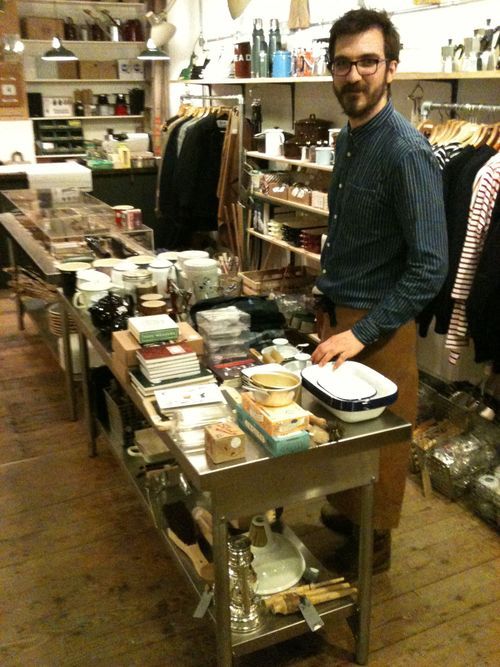
We’ve sorted through everything now, so if you don’t mind a slight chip in your enamel, or fancy some end-of-line bargains why not to pop down to Redchurch Street this weekend?
 HARRINGTON & SQUIRES is a small private printing press founded in 2002 in Tufnell Park in London. This press specialises in small format and limited editions where each job is designed and set, printed and finished, by hand using traditional methods and equipment.
HARRINGTON & SQUIRES is a small private printing press founded in 2002 in Tufnell Park in London. This press specialises in small format and limited editions where each job is designed and set, printed and finished, by hand using traditional methods and equipment.
Throughout the new year we will be sharing each monthly image from our 2013 calendar.
At LABOUR AND WAIT, we have always been keen to support craftspeople. In our opinion there is nothing like an objet made with care in which, you can detect the hand of the maker. These objects have life. The hand is, of course, the most important tool of all, but each maker has shared with us some of the faithful tools used in their everyday work. Ranging from the highly specialised to the humble and improvised, these still-lifes provide a fascinating insight into their worlds.

Our opening hours this Christmas are as follows:
Thursday 20th - 11.00am to 6.00pm
Friday 21st - 11.00 am to 8.00pm
Saturday 22nd - 11.00am to 6.00pm
Sunday 23rd - 11.00am to 6.00pm
Monday 24th December to Tuesday 1st January - CLOSED
Wednesday 2nd January - 11.00am to 6.00pm
Please note that during this period there will be no mail order service. You may place orders, but they won’t be picked and posted until the 3rd January.
Thanks to all our customers for their support this year, and have a happy Christmas!

The Christmas Mail Order Elves are working flat out, so have asked me to tell everyone that it is now time to place your last orders.
Today is the deadline for EUROPEAN ORDERS to be placed - if you are placing an order please make sure we have a contact telephone number as your local courier may need to contact you.
The deadline for UK orders is Wednesday 19th December. Our courier service is next-day, so if you must have it before Christmas please make sure to select UKMail rather than Royal Mail First Class.
Please bear in mind we are very busy, to please place your Christmas orders as soon as possible!
Also back in stock - after a long wait - our Rotating Soap Holder and Replacement Soaps.
Finally back in stock! And just in time for Christmas… our Enamel Candle Holder.
Christmas must really be getting close - we see now the arrival of brightly coloured wrapping paper, cheering up our grey December afternoons.
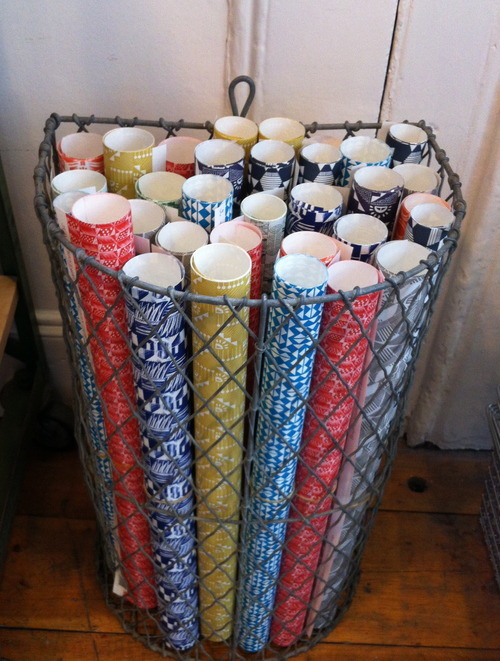
This Christmas we welcome back our traditional range of patterned papers, featuring designs from Eric Ravilious, Enid Marx, Edward Bawden and Jonathan Gibbs.
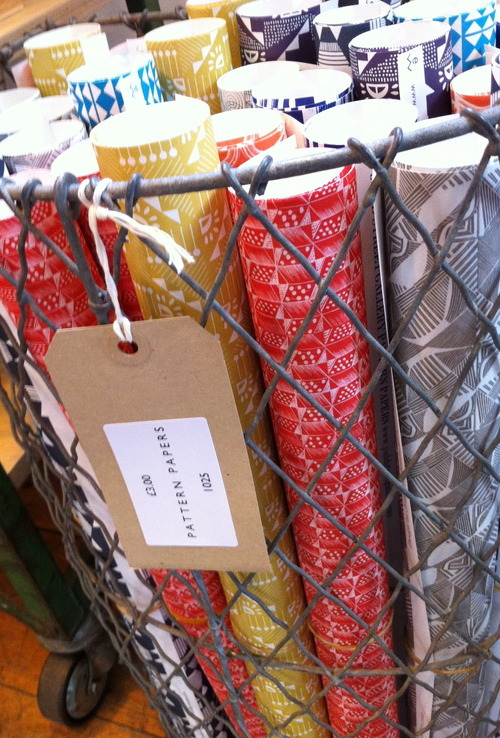
And joining them for the second year, we have papers from young London designer Esme Winter. Surely a must for every well-dressed present.
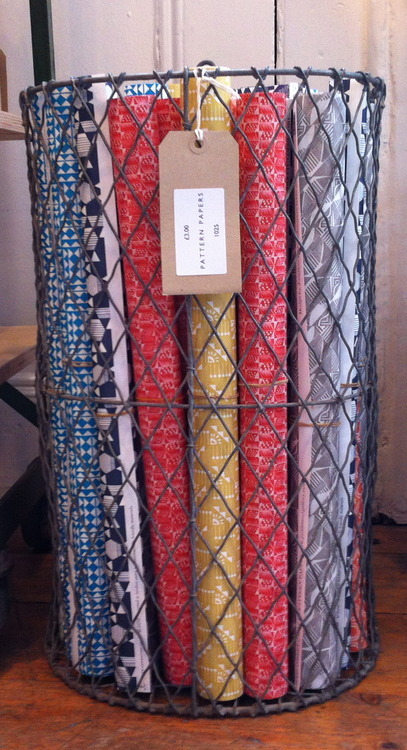
Available in store now.
Meet the Labour and Wait Mail Order Team.
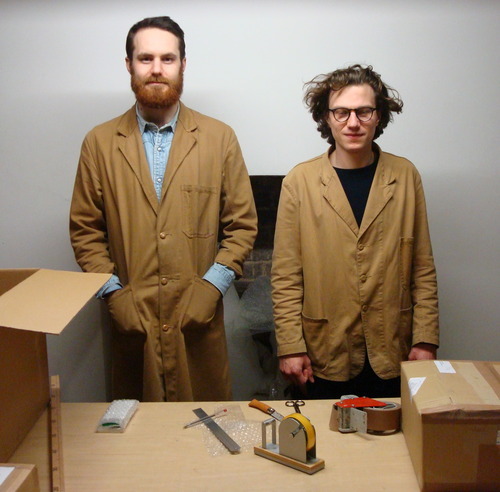
Every order that gets sent out from the subterranean Labour and Wait dispatch centre is expertly picked and packed by Jasper and Dominic - with help from old friend Brian during the busy Christmas period.
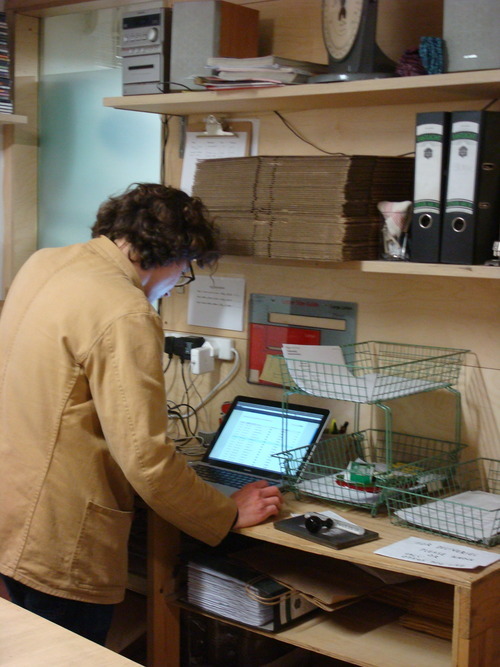
Orders are received in the nerve centre of the Admin Department. Each one will contain a unique mixture of products requiring the careful selection of the appropriate box from our cardboard mountain. We recycle as much of the packaging we receive as possible, so although your package may not look perfectly new, it is helping to save the planet.

Each box has any existing tape or stickers removed before it is repurposed. Although the packaging is recycled, the Mail Order Team pride themselves on sending out beautifully neat and tidy boxes.
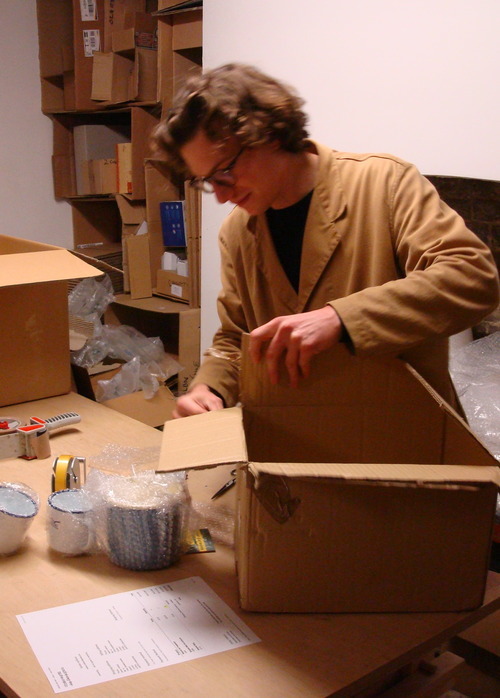
Many of our items are delicate so require careful wrapping in ( recycled ) bubble wrap.

The Housekeeper’s Bucket is a particular favourite with the Mail Order Team. They love carefully wrapping these to prevent damage from any possible mishandling in transit - why not order two, and brighten up their day?
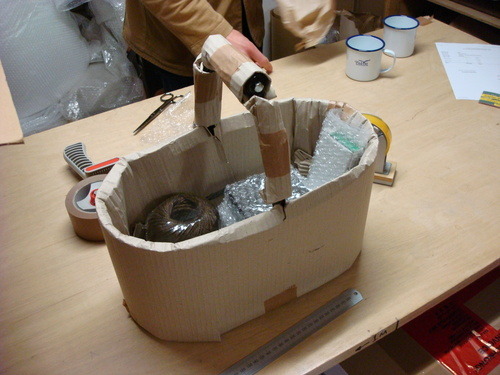
Boxes are often cut down to size, to ensure a snug fit for the contents.
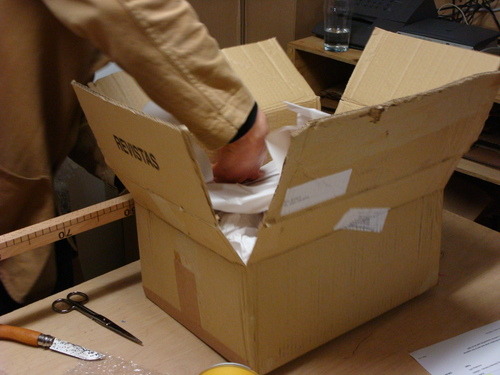
Other packages require more inventive solutions. Take the Large Feather Duster, for instance, which often finds itself in the most unusual of places.

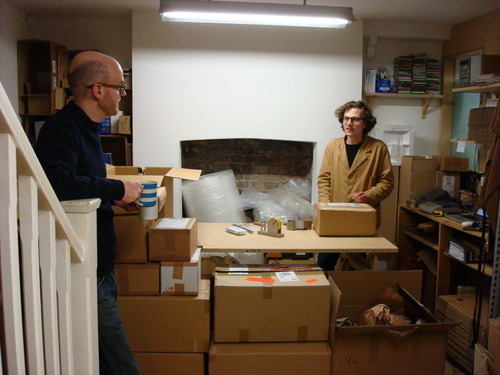
The lifeblood of any hard-working team is tea. Here it is used as inducement for Dominic - no tea until these orders are finished!

As Christmas approaches, the basement is taken over by cardboard - wall to wall, as far as the eye can see.

The Mail Order Team’s Tools of the Trade.
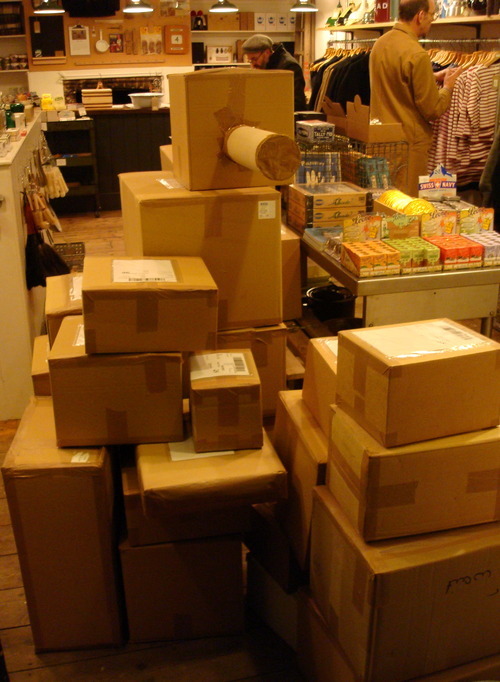
At the end of the day, the boxes are ready to be picked up. Some of these packages will travel as far afield as Clitheroe, Newport, Los Angeles and Slough - we imagine the excitement of the recipients as they receive their package and tear it open. This is the all the motivation that the Mail Order Team require. That, and lots of tea.
If you require delivery for Christmas, please ensure that we receive your order by Wednesday 19th December.
 A proper kettle. Perfect profile, rich chocolate brown and a great pourer to boot! What more do you need to warm up a winter's night?
A proper kettle. Perfect profile, rich chocolate brown and a great pourer to boot! What more do you need to warm up a winter's night?
Christmas is traditionally the time we find lots of new gift ideas, and this year is no exception. So let us introduce our Christmas 2012 line-up:
To start with, some toys, and a couple of old classics; the Gyroscope and the Kazoo.
To go with our best-selling Pinhole Camera Kit and Radio Receiver Kit, we now have a Morse Code Kit. Ideal for technically-minded and inquisitive kids of all ages.
And for the young entomologists and ornithologists, we have a Bug Identification Kit and a Birdwatching Kit.
For the older outdoors enthusiasts we have a Survival Tin, which includes a compass, fishing kit, sewing kit and mini knife, while the stainless steel Mini Multi Tool can be used as a screwdriver, wrench, ruler, bottle opener, can opener, wire stripper, wood saw and knife.
The Survival Tin includes an emergency whistle, but we thought we’d supplement this with the classic Acme Thunderer. And while you wait for your rescue, why not make a nice brew with the Storm Kettle? A favourite with outdoor enthusiasts worldwide, this formidable device will boil water in even the foulest weather.
To complete the backwoodsman’s kit we have the world famous, windproof and almost indestructible Zippo Lighter, and a Pocket Sharpening Stone - perfect for our Opinel or British Army Knives.
The Maglite Flashlight is a design classic, with heavyweight machining and a lifetime guarantee, and its little brother the Maglite Mini comes in a handy hard case.
We welcome the return of a couple of old Christmas favourites, the Kid’s Dustpan and Brush Set ( start them early ), and the German Nutcracker.
Christmas wouldn’t be Christmas without games, and we think a set of Playing Cards ( and a game of Newmarket ) is a great way to spend an evening. We also welcome the return of our page-a-day Pocket Diary.
Many of us here are keen cyclists, and we think this Dutch Puncture Repair Kit is a great little set, while the handy Mini Mess Tin can be used indoors or outdoors, in the studio, kitchen or office.
Th perfect vessel for our Italian Shaving Soap, we have found a beautiful Shaving Mug, and for a touch of luxury we have the famous ‘Major' Travel Shaving Brush.
We know many of customers are dog owners, so we have put together a great range, including this rope Dog Lead, made by the master rope makers at the Chatham Dockyards, and this professional Dog Whistle.
We love this traditional heavyweight ceramic Dog Bowl, and the perfect accessory for all pet owners must be our best-selling Rubber Grooming Brush.
And for the person stuck in the kitchen on Christmas Day? Why not treat them to an Enamel Stewpot or an Enamel Casserole - made in Austria by Riess these versatile pots can be used on the hob and in the oven, and are perfect for turkey stew on Boxing Day ( and the day after, and the day after that… )
All of our Christmas products are available in store, or on our website.
Our 2013 Calendar is now in stock online and in our Redchurch Street store.
This year’s theme is ‘Tools of the Trade’. Each month features a still life composition of the tools used by the craftsmen and women who make some of our most popular products. There is a limited stock of these calendars, so make sure to order yours in time!
Well done to all involved with the launch this week of the East End Trades Guild - see how many of your favourite shopkeepers you can spot here ( click to embiggen ).
Read more about the launch courtesy of the Gentle Author here.
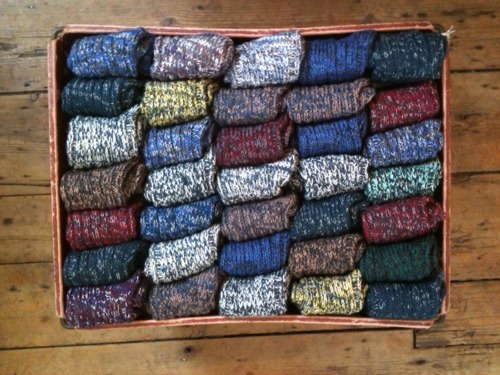
We are shamelessly using last year’s pictures ( in a different order ) to say that our Irish Cottage socks are back in stock. The perfect treat for winter feet.

Available in our Redchurch Street store now.
We see that Truman’s have announced the site of their new brewery.
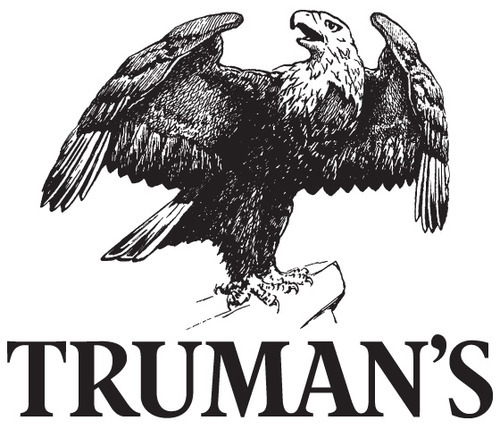
As reported by the blog with its ear to the ground and a correspondent on every street corner, the new home of the Truman Brewery will be in Hackney Wick, and should be brewing by early next year.
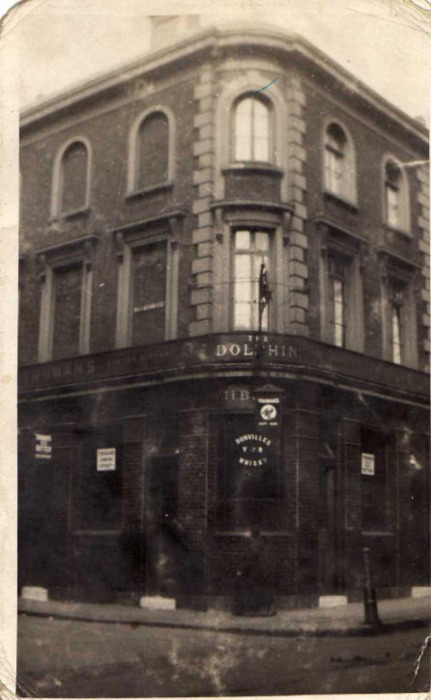
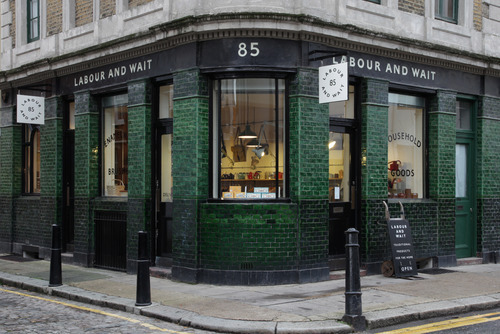
Labour and Wait’s home is an old Truman Brewery public house, and shares its distinctive green tiles with many of the old Truman pubs, some still in use, some converted to homes, some now shops and others derelict and forgotten. But the Truman name can be seen all over the East End, and the name is now synonymous with the old brewery on Brick Lane, long one of the cooler hang outs of this part of town.
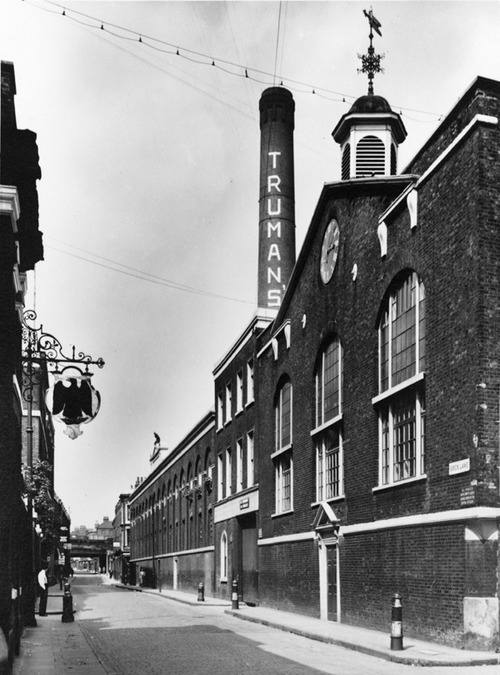

A before-and-after of Brick Lane and the Old Truman Brewery.
When we held our party to celebrate the opening of our new store, we served a couple of barrels of Truman Runner, so it’s great to see the opening of the new brewery and the appearance of more and more pubs selling Truman Beers - one hundred and fifty at the last count.
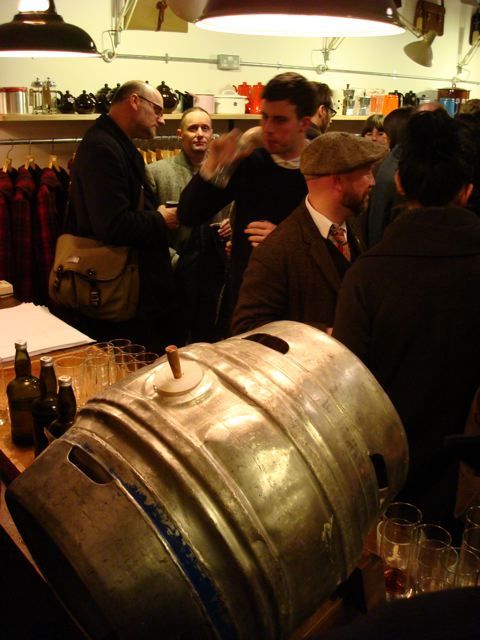
One of our barrels of Truman Runner in place.
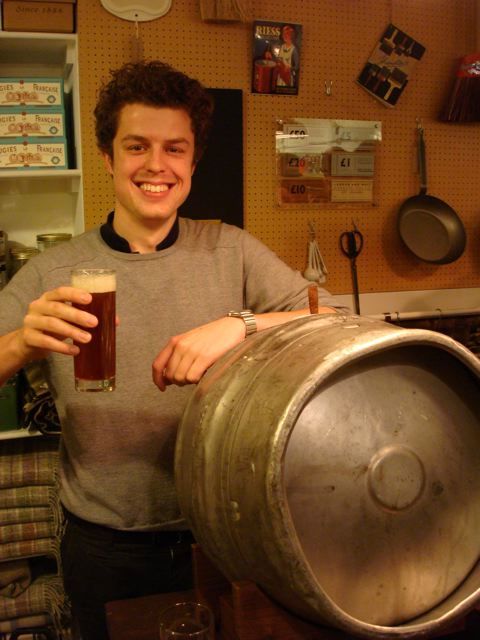
Michael-George of Truman, who has overseen the rebirth of the East End brewery.
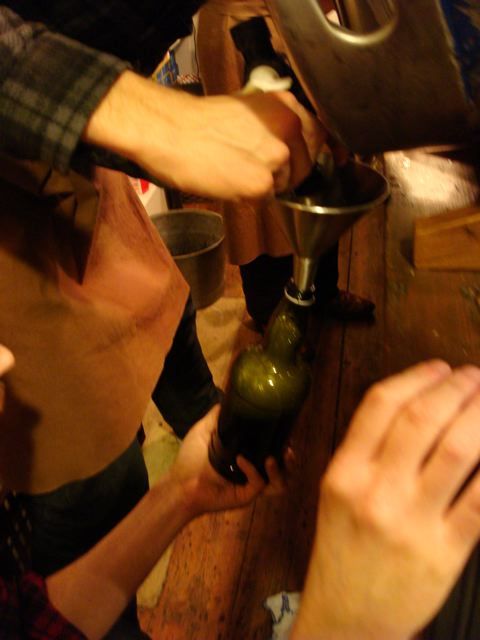
Taking advantage of the last few drops…
So we wish the best of luck to Truman’s and hope that by next year we’ll be enjoying another Hackney-brewed beer.
We’re very pleased to be one of the founding members of the East End Trades Guild.
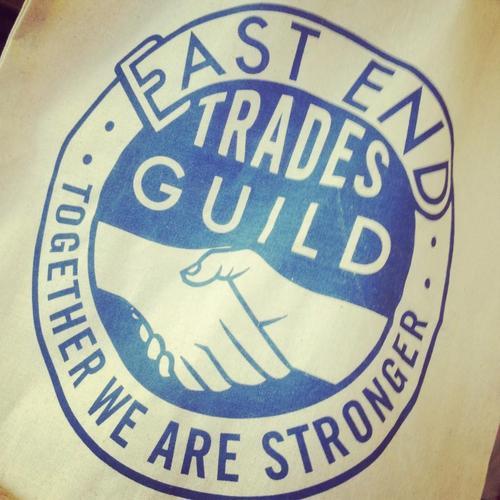
The East End Trades Guild logo, designed by James Brown.
We’ve been in this part of London for over 12 years now, and although not as long as some traders, we feel like one of the old guard. And we love to see all the new independent shops and businesses opening up around here, run by people who have recognised this area as the best place to start their small business, safe in the knowledge that customers are discerning and enthusiastic, and prepared to put their money into the hands ( and tills ) of the ‘small guy’.

Paul Gardner, local trader and inspiration behind the EETG.
Yet we’ve also seen the steady upwards creep - and often the rapid upwards shoot - of rents, as the success of the area has brought its own problems. In what we must call the 'Covent Garden Effect’, a somewhat shabby, tired market area is reinvigorated by exciting independent businesses before being 'discovered’, publicised and gentrified, before finally the big brands arrive, rents rise, and the original traders are moved on.
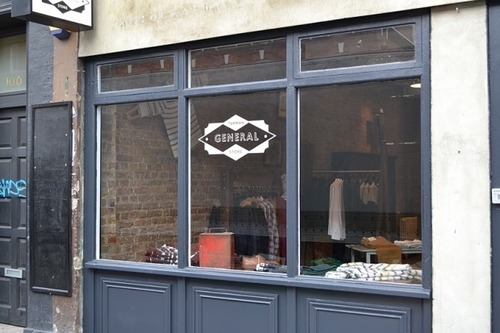
Topman 'General Store’ on Commercial Street.
Lest this sound like snobbery about the 'wrong type’ of shop moving into the area, let us look at the reasoning behind the EETG; to protect the commercial interests of small independent traders, often exploited by landlords, agents, big business and government, despite being the best businesses for a local area. For local businesses reinvigorate local areas, where big traders anonymise an area and suck the money out - take for example a quote from the manager of a local chain store, dressed as a cool independent store -
“My favourite place to eat would have to be either Wagamama’s or Nandos a few doors down… or Pret, I could go on forever.”
As small businesses we don’t have the financial backing of the chains, so as rents inevitably rise, we are competing with operations with deep pockets and little regard for anything other than the bottom line. Without the work of groups like the EETG, what is feared may become unstoppable, and then how long before Leila’s becomes a Nero, or Cafeand a Starbucks? Or if Pellici’s were forced out and replaced by a Pret a Manger? What then will happen to Shoreditch and the East End?
So let’s all wish the East End Trades Guild the best of luck as it launches this week, and lets hope it can inspire traders in other areas, towns and cities to unite, to work together to support the local economy. As their logo says - Together We Are Stronger.
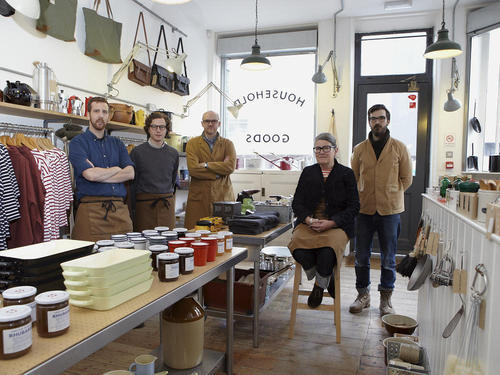
As part of the EETG project, all the members are being photographed - our thanks to Patricia Niven for this great picture.
The East End Trades Guild will officially launch on Monday 19th November at Christ Church Spitalfields.
 A little grey jug, which seems more like a sketch than the real thing. Seen from this angle the dynamic handle appears to diminish impossibly at its junction with the body.
A little grey jug, which seems more like a sketch than the real thing. Seen from this angle the dynamic handle appears to diminish impossibly at its junction with the body.
And so to Spitalfields Life, where the Gentle Author continues the quest to capture all of East End life in one compendious website, the modern Human Comedy in all its varied and various colours, shades, sounds and shapes.
Last weekend the Gentle Author joined local man of letters Clive Murphy for a tour around his Brick Lane flat. Visitors to our Redchurch Street shop will recognise Clive as the author of such works as “The Good Deeds of A Good Woman”, “Four Acres and a Donkey” and “Oiky, The Memoirs of a Pig Man”. A Gentle Author himself, Clive took to recording the stories of those people he saw around him in 1970s Brick Lane, capturing a demotic human history in the way that many of today’s writers, bloggers and tweeters will recognise.
We are glad to see Clive’s books attracting attention today, not least because it allows the author to pursue his interest in writing his Ribald Rhymes - not for the faint-hearted, although an ideal present for a favoured in-law.
Our thanks go as always to the Gentle Author for this story and for use of the photographs.
 This curious enamel coffee maker could only have been made in England! Its strangely baroque handle seems completely at odds with its otherwise pared down appearance. This anomaly, however, is what makes it so compelling.
This curious enamel coffee maker could only have been made in England! Its strangely baroque handle seems completely at odds with its otherwise pared down appearance. This anomaly, however, is what makes it so compelling.
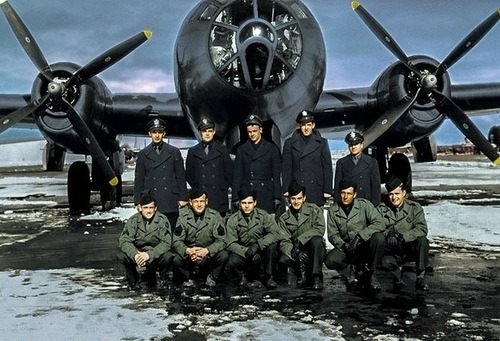
Well its that time of year. The summer clothes are being packed away and we search out our woolens as the evenings close in. We hold out hope that we may yet see one of our much-beloved Indian summers, but we are well prepared for the onset of autumn; and so we have now got a shop full of slippers, blankets, wooly socks and jumpers. And we are also pleased to see the return of the Pea Coat, one of our favourite winter staples.
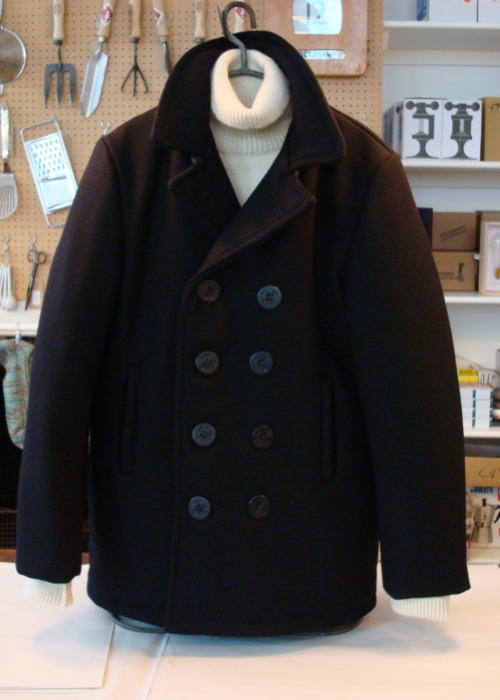
The Schott Pea Coat is, we believe, the finest quality example of this classic style. A true design original, this heavyweight jacket is one of the many reasons to welcome the arrival of colder weather.

Originating, as many menswear staples do, from the needs of military service, the Pea Coat was standard issue for British and American navies before being de-mobbed into civilian service. The heavyweight 32 oz Melton Wool is the original windcheater, being thick, warm and durable; the wool is mixed with 25% nylon and other threads which are interlocked and pressed together before being cut, to ensure maximum protection against the elements, whether you are battling your way against the high seas or up the high street.
The classic Pea Coat derives from the Royal Navy Reefer Jacket, originally intended for ‘reefers’ ( Midshipmen ) on board sailing ships, whose job was to climb the rigging and unfurl, or 'reef’, the ship’s sails. The jacket was short, to allow ease of movement through the rigging, while the double-breasted front, which displaced the buttons to each side, helped to reduce the chance of them getting caught on ropes as the wearer maneuvered the sails.

The classic Pea Coat has ten buttons; four pairs in the double breasted style, plus two at the collar. This allows the coat to be buttoned fully to the neck which, with the wide, heavy collar, ensures complete wind and weather resistance.

Richard Crenna exhibiting classic Pea Coat style in 'Wait Until Dark’
So why 'Pea Coat’? As ever with these stories, there are different explanations as to how this name was arrived at. The classic version is that these are 'P’ coats, as worn by the ship’s Pilot, although an older story has the name coming from the Dutch Pijjeker, where Pij is the coarse, heavy wool from which the jacket was made; this material itself became known as Pilot Cloth or P Cloth, hence the P Coat.
The longer, thigh length version is known as the Bridge Coat.
This year we are also offering this style in children’s sizes. As all well-dressed ladies know, the men’s cuts are often superior to the female and the Pea Coat is no exception. The female version has a shaped waist which offers a more feminine profile, but which also lacks the silhouette of the original style, so losing that classic look. The children’s Schott jackets offer the classic Pea Coat style even in smaller sizes.
Serge Gainsbourg showing how to wear a Pea Coat
Heavy but wearable, durable, and classic - the Pea Coat is perfect Winter wear and a wardrobe essential.
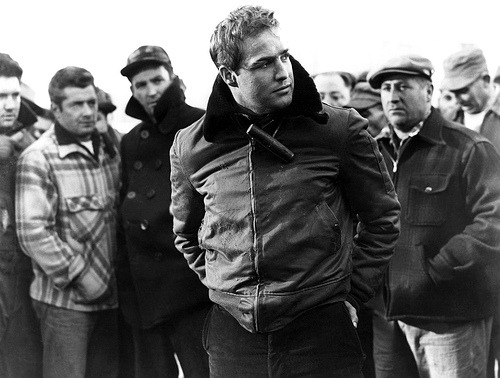
A Bridge Coat in a supporting role in 'On the Waterfront’

Robert Redford in a Pea Coat. You can’t get much cooler than this.
We’ve just seen that our supplier of leather goods has his own blog. And on it he has this picture of wallets, keyholders, cardholders and phone holders ready to go to our stores in Japan.
These are all hand-stitched so there is a lot of work there, but I can speak from experience when I say that this leather ages beautifully, and I am sure there will be some very happy Japanese customers very soon.
Many thanks to Ed and Joe at The Travelling Gin Company for their appearance at Redchurch Street on Sunday. Unfortunately we had to wait until at least the end of the day before we could test their wares, but we are pleased to report that it was worth the wait. Perhaps we should do this every Sunday?
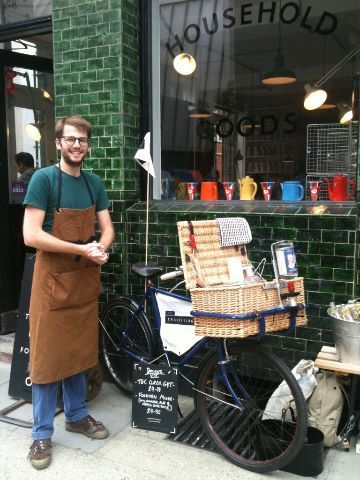
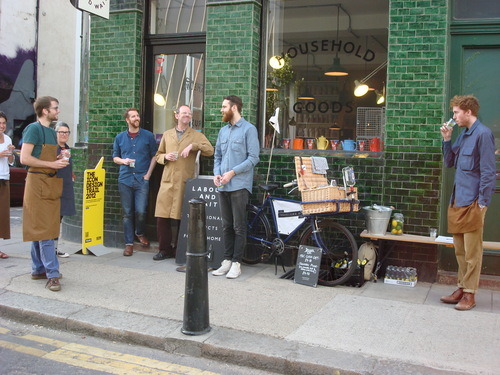
Their appearance was to celebrate the launch of Design Week, and our celebration of the Tala Cook’s Measure.
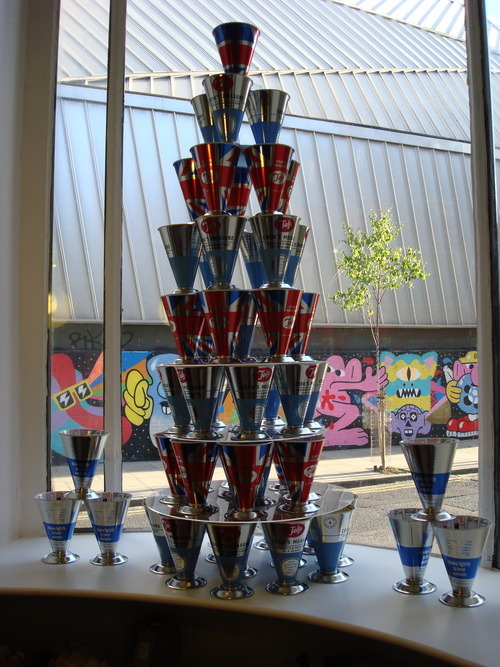

As part of the Icon Design Trail and Shoreditch Design Triangle,
Labour and Wait will be holding an exhibition celebrating the iconic
’Tala Cook’s Measure’.
A kitchen classic which is as useful today as when it was first introduced, the Cook's Measure is still made by hand in England, by a skilled workforce of only two people.
Join us in store as we celebrate throughout the London Design Festival from Saturday 15th until Sunday 23rd September.
The Travelling Gin Company will also be providing a rather unique bar experience straight from their bicycles throughout the day on
Sunday 16th September.
Exhibition Open Saturday 15th - Sunday 23rd, 11am - 6pm. Closed Monday.


 This preserving jar is from America. We are always looking for these jars, whose aqueous hue is so appealing. The earliest examples date from the 1930s and have beautiful irregularities in the glass.
This preserving jar is from America. We are always looking for these jars, whose aqueous hue is so appealing. The earliest examples date from the 1930s and have beautiful irregularities in the glass.
Due to recent legislation regarding the sale of lightbulbs, we would like to make clear to all customers that we sell our bulbs as ‘Rough Service’ lightbulbs, suitable for industrial or outdoor use.
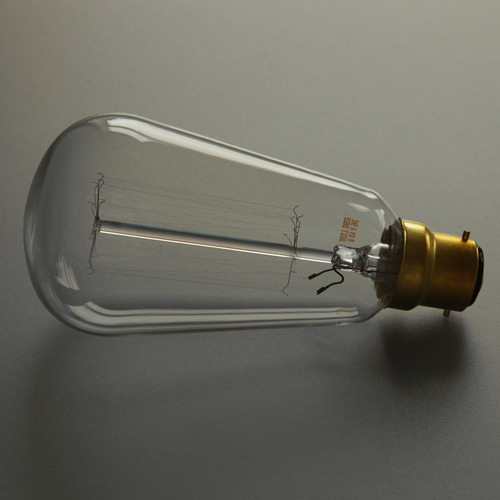
In selling these bulbs we declare that they are not suitable for household illumination. However, we can not prevent customers using them whichever way they choose.

We recently took a trip to to Austria to visit the factory of Riess, one of our enamelware suppliers. Inspired by this visit, we thought we should share some of the secrets of enamelware and spread the word about this durable and versatile material.
So here is the Labour and Wait three part guide to enamel:
Our Airforce Milk Pan is a traditional Riess product in our own custom colour.

Enamel consists of natural raw materials. Glass, potash and metal oxide are combined in a furnace and heated to between 1,000°C and 1,200°C. The resulting liquid enamel mass is then poured out between two water-cooled rollers, forming a thin plate which is then broken down into enamel chips, known as ‘frits’.

This raw enamel is then finely ground with additives and pigments before being mixed with water. Almost any colour can be created through this process, which creates the coloured slick.

Enamel can be applied to metals such as cast iron, aluminium and copper, although Riess use rough sheet metal. This is then either cold pressed or turned in a number of processes which create the base vessel.
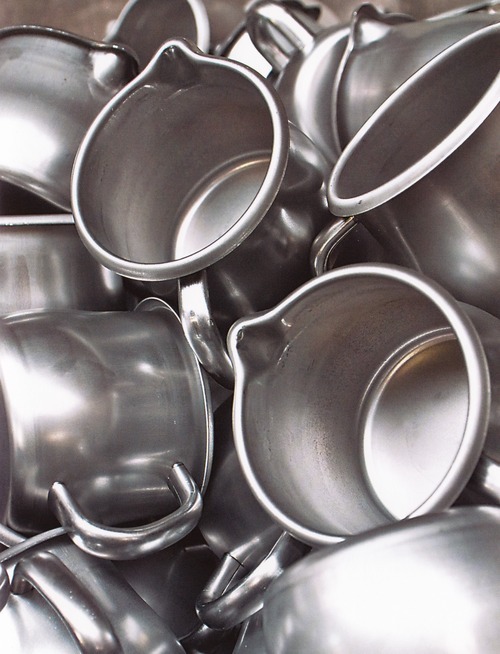
These metal blanks are then dipped in an acid bath to burn off any impurities before they are ready for the first coat of enamel.
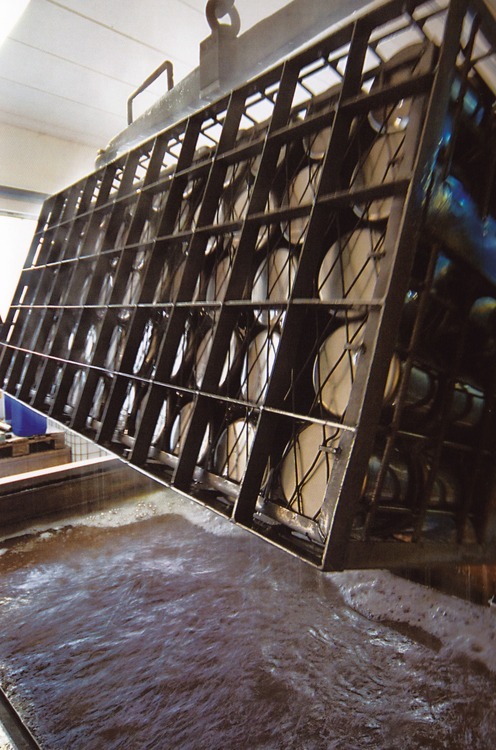
This first coat is the bisque, the plain undercoat. During the drying process these jugs will pass through the drying furnace at approximately 80°C.

At Riess each item is hand-dipped in the enamel slick.

A series of ingenious Heath-Robinson devices are then used to turn the pots after the enamel is applied. This allows the viscous enamel to slowly and evenly coat the surface, while a quick flick with each turn shakes off drips which can then be collected and reused.
 Each item will require at least two or three coats, including a grey undercoat, a base coat and the final colour, before the contrast interior colour is added.
Each item will require at least two or three coats, including a grey undercoat, a base coat and the final colour, before the contrast interior colour is added.
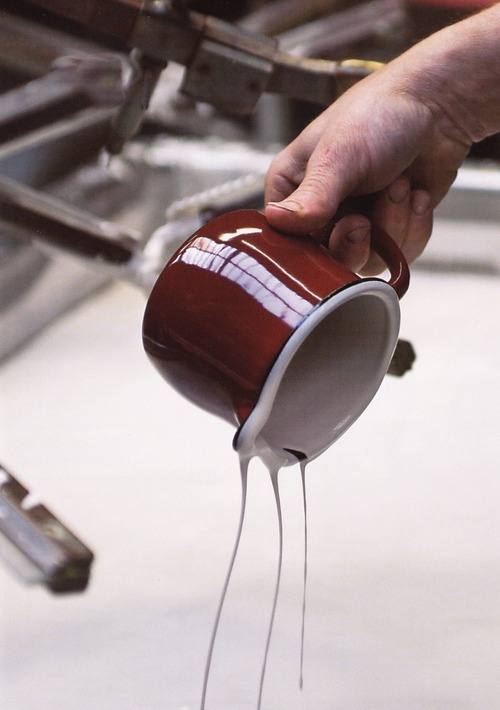
Hand finishing ensures each item is up to standard, with an even covering and no drip marks.
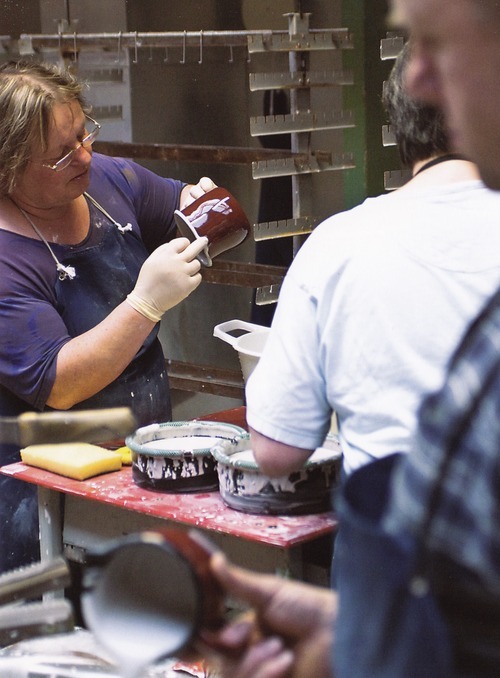
Each coat requires a trip through the furnace to fully dry, before the finished product is finally baked at a temperature of around 860°C. It is this final baking that creates the finished product - the vitreous coating and the steel base fuse together to create a new and unique material: enamel.
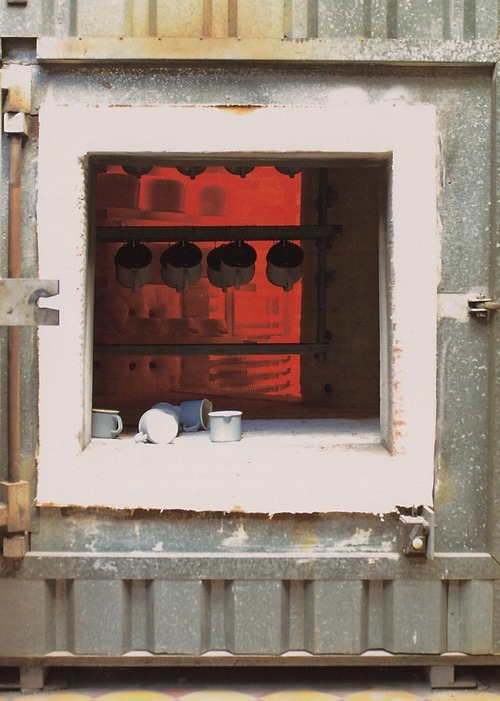

Enamel is a unique material, sharing the characteristics of glass and steel while offering more versatility than ceramic or plastic.
Enamel can be used on gas, electric or induction hobs, and can be taken straight from the hob to the oven to the table.
Premium enamel is distinguished by its exceptionally tough, cut- and scratch resistant surface.
The surface is resistant to dirt and bacteria and is easy to clean. The natural raw materials used in its manufacture means it is safe for all food uses, and it will not flavour or colour the food.
Enamel will not emit any harmful or noxious fumes, even when heated to very high temperatures.
Enamel’s high heat conductivity ensures hot food cooks quickly and thoroughly, while cold foods keep cool for longer.
Enamel’s qualities make it ideal all around the home, and not just in the kitchen.
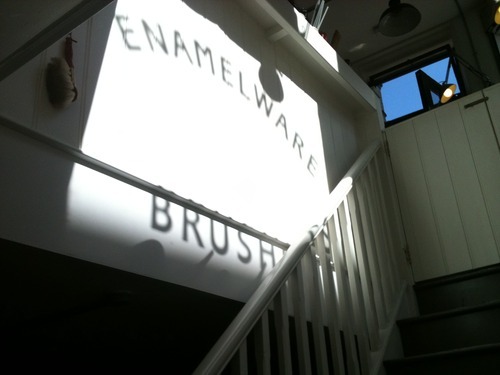
Looked after with care, your enamel product should last a lifetime. However, to ensure the best performance, please note the following instructions.
- Boil all enamelware with water before using for the first time.
- Rinse out briefly with water before filling with food that is prone to leave deposits behind ( e.g milk ).
- Never apply heat when empty - the base is liable to become deformed.
- Do not rinse enamelware when hot - allow to cool down first.
- Always soak stubborn food residues before cleaning. Never scrape burnt-on food away with hard objects or scourers. If necessary, boil saucepans using water and washing-up liquid.
- Do not place enamelware in the dishwasher, as the combination of the soap and washing action is abrasive.
- Enamel is extremely tough and highly accident-resistant. However, the enamel coating can be damaged if dropped onto a hard surface
 A clothes brush which unfolds to become a coat-hanger, or a coat-hanger which folds to become a clothes brush? This 'Heath-Robinson' device would have been indispensable to a seasoned traveler in the 1950s.
A clothes brush which unfolds to become a coat-hanger, or a coat-hanger which folds to become a clothes brush? This 'Heath-Robinson' device would have been indispensable to a seasoned traveler in the 1950s.
Shhh, don’t tell LOCOG -

We can’t help but be swept up by the sporting spirit in London at the moment and, despite our usual seen-it-all-before cynicism, we all agreed that the opening ceremony was a spectacular event - and the Heatherwick cauldron was an amazing piece of work. Good luck to Team GB and all the athletes taking part.
Please excuse the mess in our mail order department, but we’d just like to show you some of the vintage enamel that has recently arrived.

If you haven’t been in to our Redchurch Street store you may not know that we sell a selection of vintage items. This ‘new old stock’ is all in perfect condition, and can range from stoneware pancheons and flagons to enamel stewpots and glass measuring jars. We have sold these items for many years and, although they are becoming harder to find these days, we still manage to unearth some great examples.

Vintage enamelware is particularly hard to find, as it can chip or crack so easily if not looked after. So this hoard of perfect pots and jugs was a lucky find.
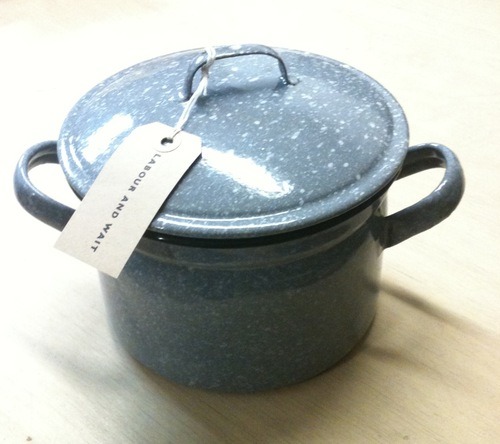
The speckled enamel in particular is something we really love here; despite searching all over Europe, we can’t find a factory that produces modern examples like this, and to the same standard.
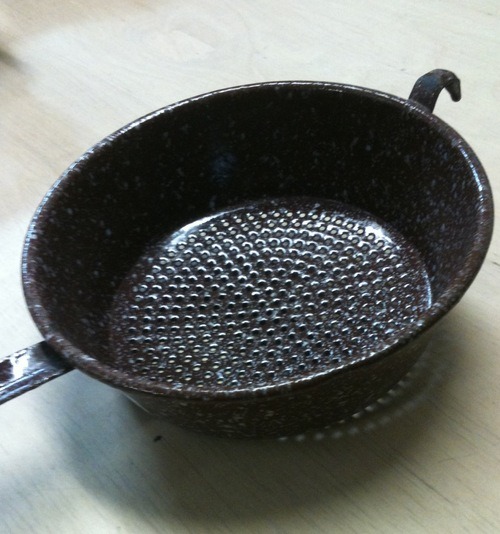
Until then, we just have to rely on finding vintage examples like these. Available now in our Redchurch Street store.
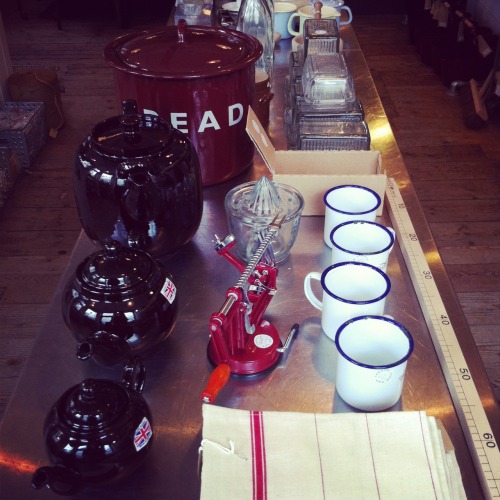
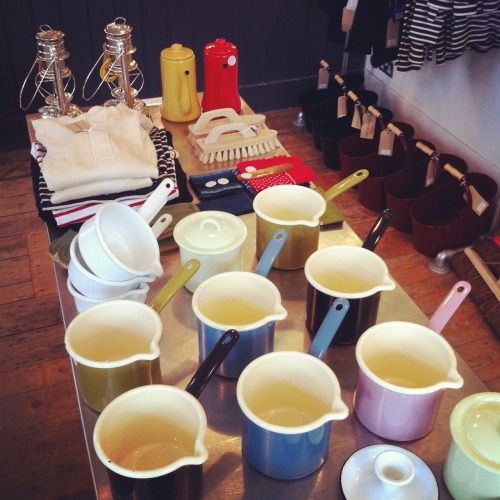
Pop in store Today & Tomorrow to catch our Weekend Sale. End of Line, Samples and Shop Soiled stock. Bargains galore!
Our aprons are now back in stock.

These ones have been put aside for various bars, cafes and restaurants, but there are still plenty available in all three styles -
The original Work Apron
The Bib Apron
And the new Waist Apron with Pocket.

These hard-wearing tote bags have been proving popular in our Redchurch Street store so we’re very pleased to introduce them to our Online Catalogue.
Originally made from leftover fabric from the Swiss Army, these bags are still hand-crafted in Germany from a military grade canvas. Adjustable leather straps, reinforced corners and zip pocket mean this is one ‘tough tote’.
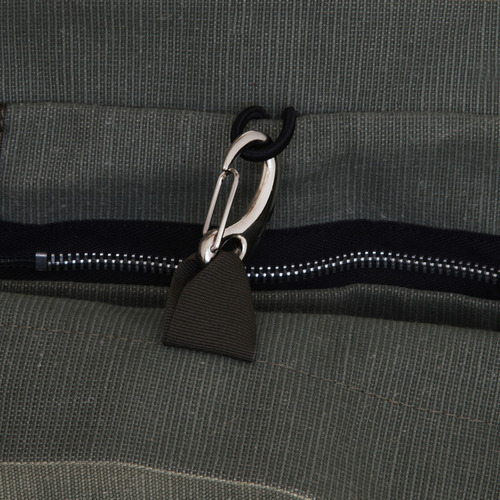

Large Totes are available for £80 in Green/Tan or Black/Grey.
As mentioned earlier on the blog, we now stock a range of locally made leather goods, these are all now available to buy online .
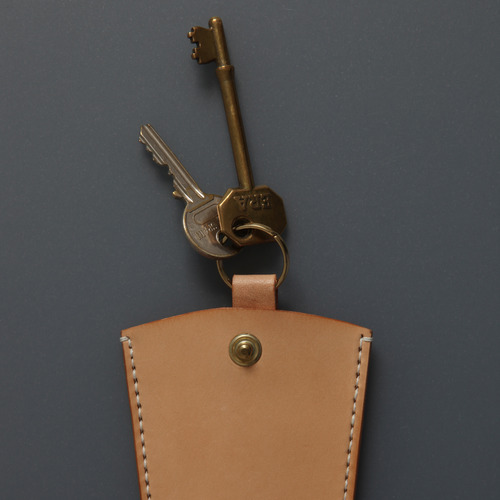
The Key Holder, £55.
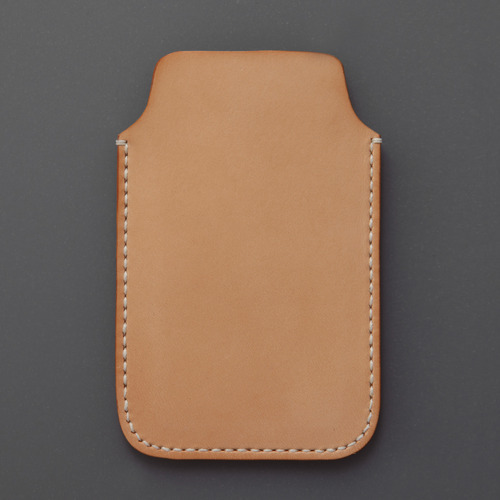
iPhone Case, £55.
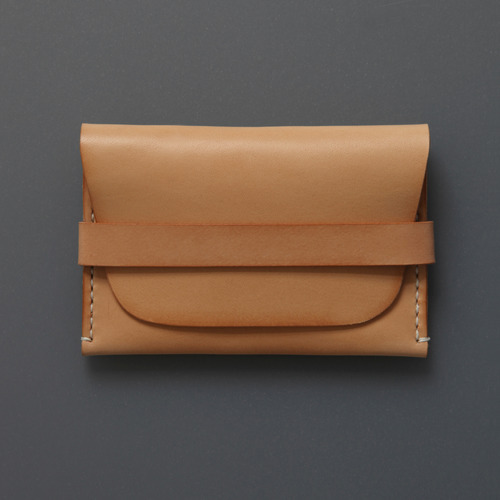
Wallet, £85.
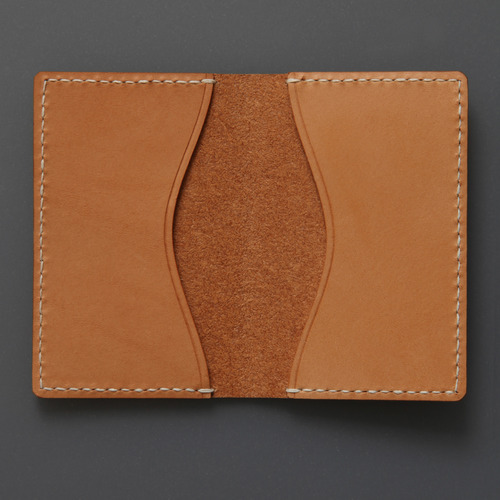
Card Holder, £50.
 We found this teapot at a vintage fair, and immediately fell for its quirky ugliness. The contrasting spout and wicker covered handle makes it demand attention. In ten years we have never seen another one!
We found this teapot at a vintage fair, and immediately fell for its quirky ugliness. The contrasting spout and wicker covered handle makes it demand attention. In ten years we have never seen another one!
In anticipation of some sunny weather, we have just received our new stock of espardenyes, fresh from Barcelona.
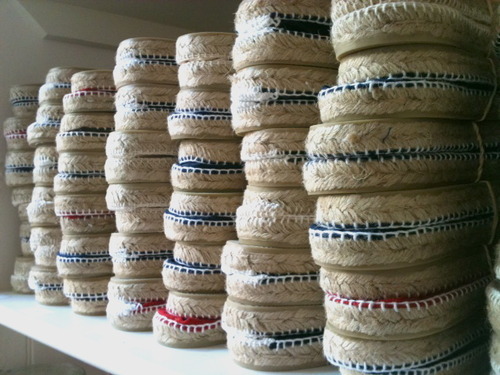
For more information on these classic summer favourites, you can read our previous post from last year, or just pop in to Redchurch Street.
Some father’s day gift suggestions for the Labour and Wait customer.

Our new Multi Spot Handkerchief, £5.00
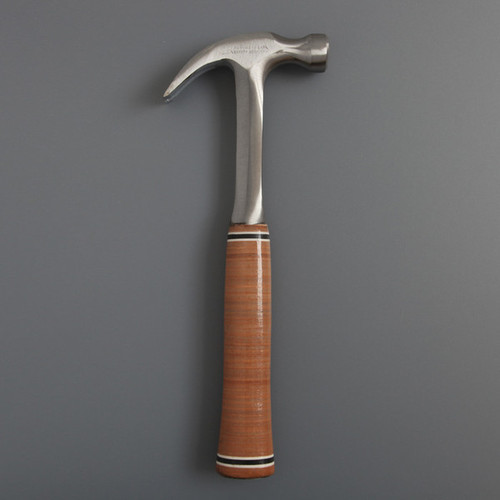
The triple-laminate leather handled American Hammer. £48.00
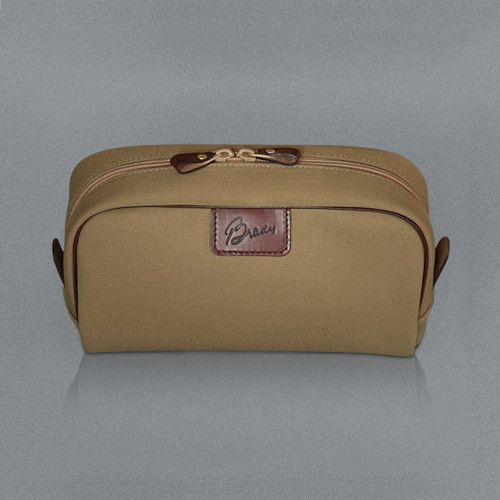
The Brady Wash Bag will last a lifetime. Available in Khaki or Black. £40.00
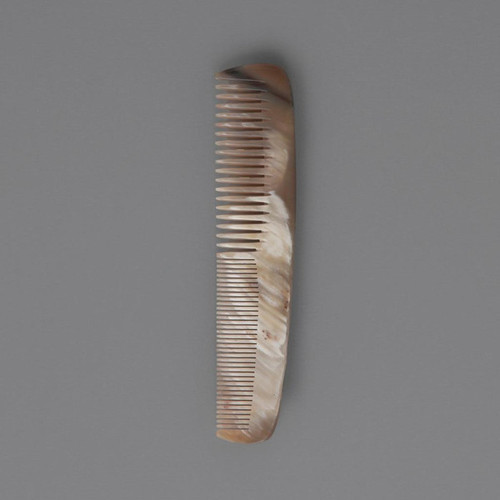
The Horn Comb, made from North African cattle horn. Each is unique. £10.00

The Professional Corkscrew from France. £22.00
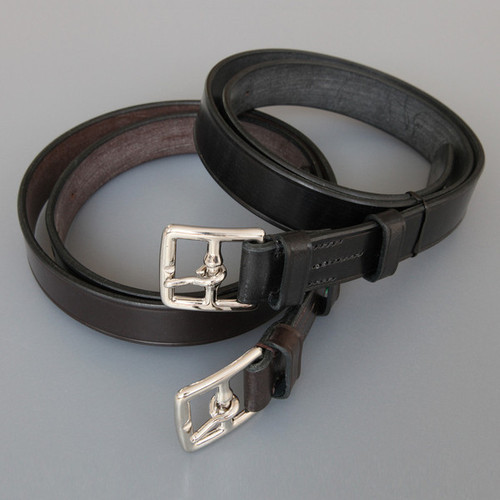
A Bridle Leather Belt, Handmade in England £60.00
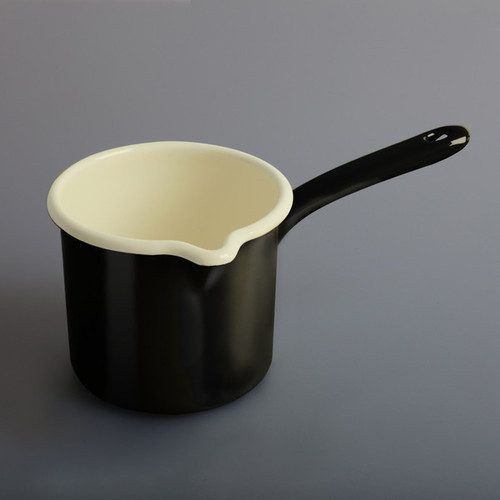
The Black Enamel Milk Pan, £20.00
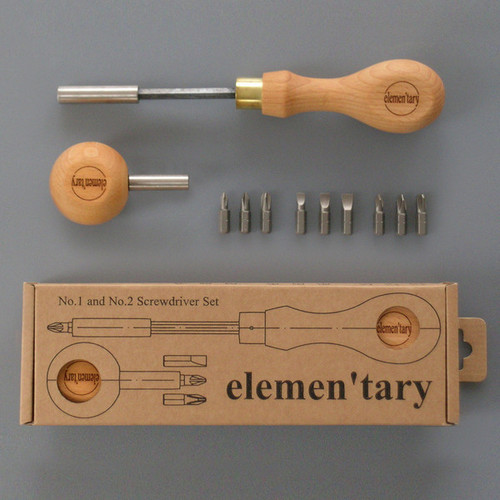
The Elementary Screwdriver Set, Handmade in the UK. £40.00
Also available individually.
May we introduce our new line of handmade leather accessories.
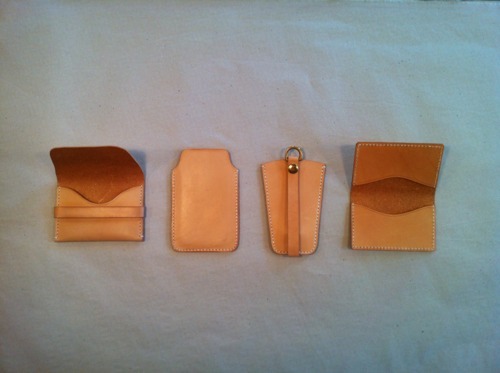
From left to right; wallet, phone case, key holder and card holder.
![]()
The wallet has space for up to six cards and a couple of folded notes inside, with an extra pocket on the rear.

Made of vegetable tanned leather and hand-stitched using beeswax linen thread, these items will age beautifully.

The phone case was designed to fit an iPhone, but will work for all modern smartphones.

Keys can be kept safely secure inside this holder; the strap can be pulled out or clipped securely when not in use.

The d-ring allows you to hang the holder up, to ensure your keys are always where you expect them to be.
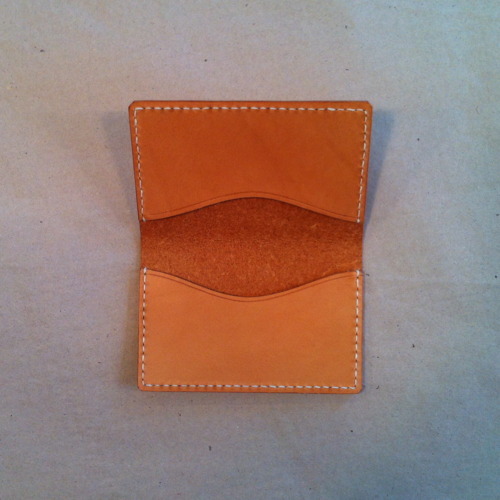
The small card holder will easily carry four cards, and is ideal for travelcards or oystercards.
All of these products are hand made in London.
Available now at our Redchurch Street Store and on our website.
To celebrate the Queen’s Diamond Jubilee we will be having a day off!

Labour and Wait will be closed on Tuesday 5th June, so our opening hours for this weekend are as follows:
Sat 11.00 - 6.00
Sun 11.00 - 6.00
Mon CLOSED
Tues CLOSED
Weds 11.00 - 6.00
And may we wish a happy long weekend to Royalists and Republicans alike.
 This jolly juicer dates from the 1970s. Its shape and colour implies its function perfectly. On picking it up, the urge to squeeze the handles is almost irresistible.
This jolly juicer dates from the 1970s. Its shape and colour implies its function perfectly. On picking it up, the urge to squeeze the handles is almost irresistible.
We found some postcards pushed through our letterbox the other day, with this picture on it.
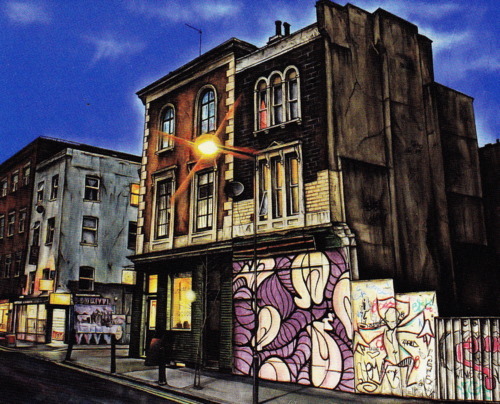
The artist is Marc Gooderham, who ‘captures the decaying still-lifes of a forgotten London.’ Well I hope we’re not that forgotten, but its interesting to see the old Georgian building next to our shop, which for many years was a squat, and which was demolished to make way for another new block of flats. No doubt offering exclusive urban living with a touch of Shoreditch edge.
The artist’s website is marcgooderham.co.uk.
Gin and Tonic on a bike; what a combination! We always like to see where our products end up so we are delighted to see the Travelling Gin Co. using our work aprons.
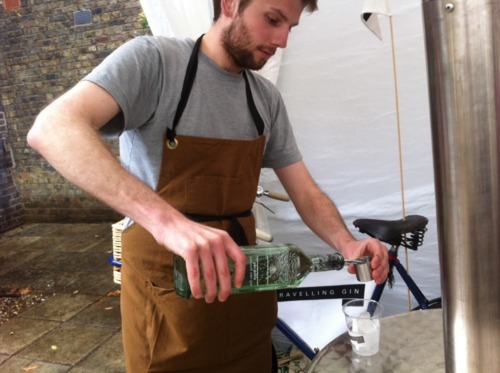
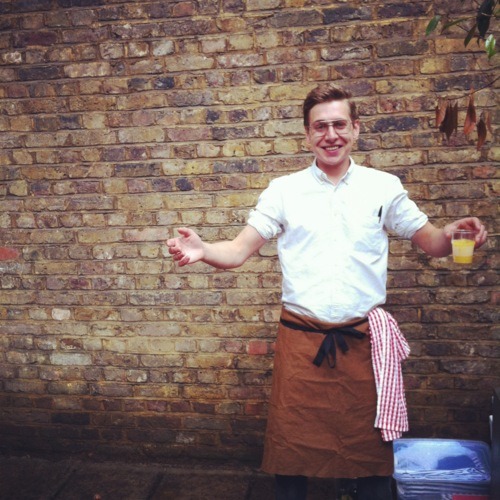

I think we can definitely see the need for a G&T or two outside Redchurch Street this summer…
 A recent find, the pleasing shape of this simple skimmer reminds us of the domestic still life paintings of artist William Scott.
A recent find, the pleasing shape of this simple skimmer reminds us of the domestic still life paintings of artist William Scott.
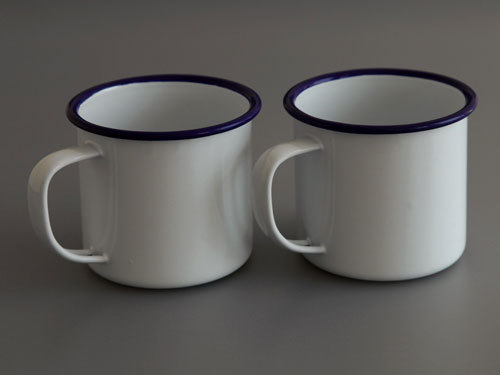
At last! We’re pleased to say that White Enamel Tea Pots, Mugs, Pudding Basins, Plates and Small, Medium and Large Pie Dishes are all back in stock.
 They don't make them like this any more (unfortunately!) A beautifully proportioned pail, enamelled in the mottled grey of an April sky. It is humble, but beautiful.
They don't make them like this any more (unfortunately!) A beautifully proportioned pail, enamelled in the mottled grey of an April sky. It is humble, but beautiful.
Allow us to pass you over to our favorite city chronicler and blue-eyed bohemian The Gentle Author to introduce a new series of ‘Field Trips’, in which our esteemed author chronicles our most noteworthy manufacturers and suppliers. The first visit is to R. Russell, Brush-maker.
 This old 'Betterware' brush is from our brush collection. We have always had a curious fascination with brushes as they come in so many different shades and sizes, often with very specific uses. This one, we believe, is simply for removing cobwebs.
This old 'Betterware' brush is from our brush collection. We have always had a curious fascination with brushes as they come in so many different shades and sizes, often with very specific uses. This one, we believe, is simply for removing cobwebs.
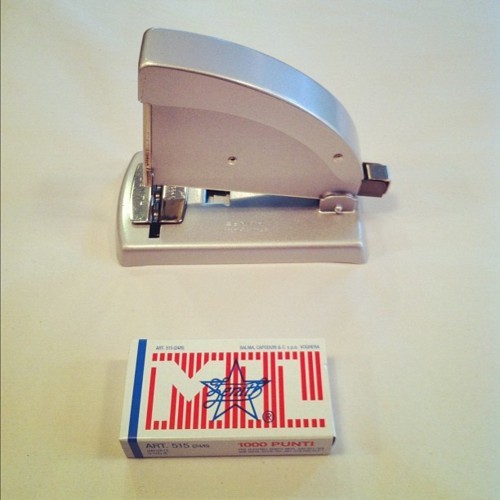
Zenith 520/E Desk Stapler

Zenith 548/E2 Handheld Stapler
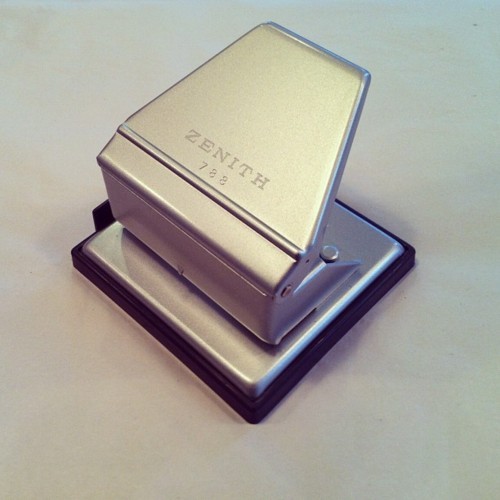
Zenith 788 Hole Punch

Zenith 580 Staple Remover
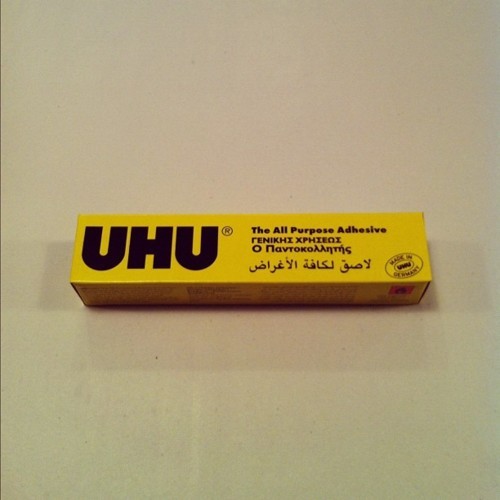
UHU All Purpose Glue.
Additions to our Stationery range. Now available in our Redchurch Street store.
![]()
 This small milk jug hails from Staffordshire. Its stripes have all the balance and harmony of a Ben Nicholson relief, or a Josef Albers painting. Art for the breakfast table!
This small milk jug hails from Staffordshire. Its stripes have all the balance and harmony of a Ben Nicholson relief, or a Josef Albers painting. Art for the breakfast table!
Our new products for 2012 are starting to arrive. We don’t seem to have had any time to look for new things since… well, since we started to plan Redchurch Street. So we welcome our first arrival of the year, these 100% linen Irish-made tea towels.

Available in red or blue, these are the best quality towels we’ve come across and, as vintage linen tea towels are getting harder to find and more expensive to buy, we are sure they will prove to be very popular.
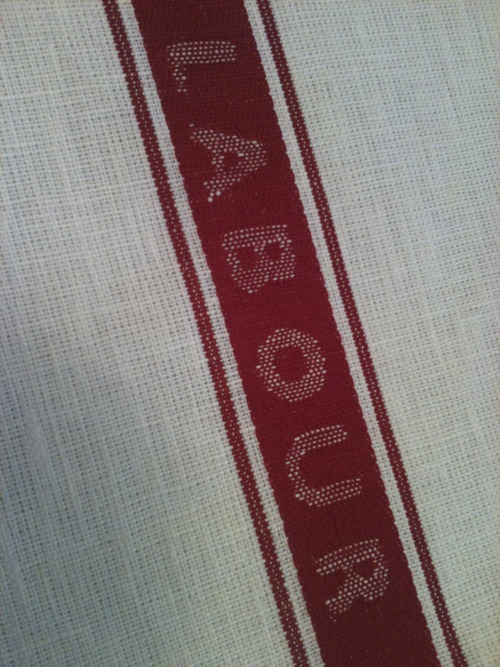
Linen is traditionally the favoured material for tea towels and glass cloths, as it leaves no marks or residue, and doesn’t shed fibres like cotton - just give them a hot wash before use and the mesh tightens up to leave you with a perfect tea towel.

Available instore now, at £14.00 each.
![]()
Its Tachiagari at Dover Street Market. This bi-annual rebirth sees the entire store closed, refitted and remerchandised, ready for the new season.
As always, we’ve played our part, refreshing our concession and removing any sign of winter, as we set ourselves for Spring / Summer 2012.
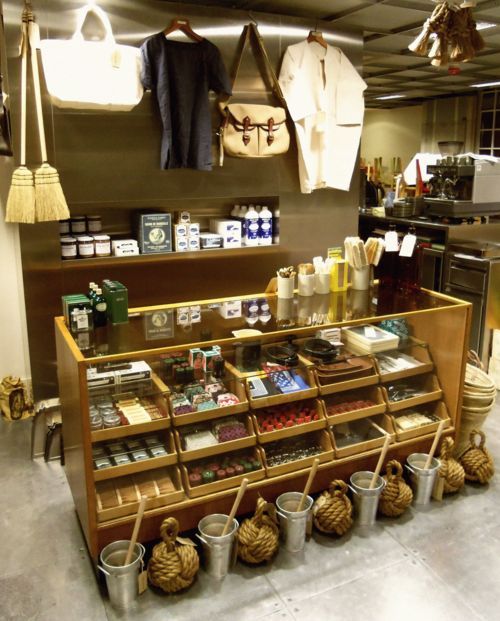
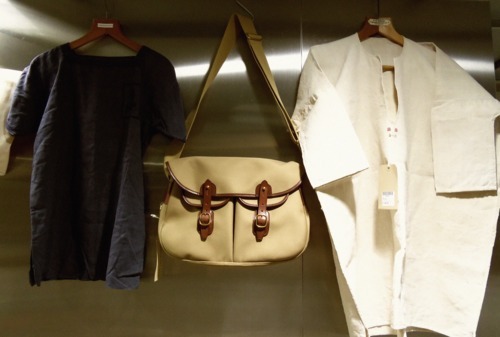
This season sees exciting new developments at DSM, as Hussein Chalayan and Sarah Burton for Alexander McQueen open new spaces on the third floor, while Michael Costiff and Ann Demeulemeester will completely renew their existing homes. Lanvin, Yves Saint Laurent, Stephen Jones and B Store will also be refreshing their spaces.
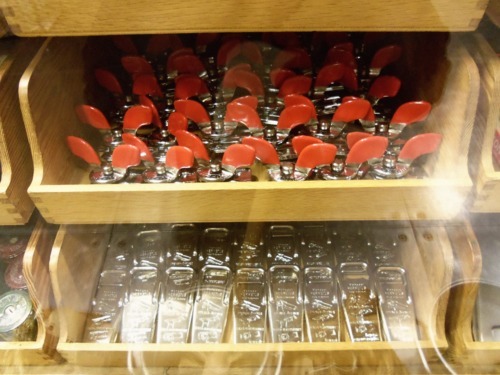
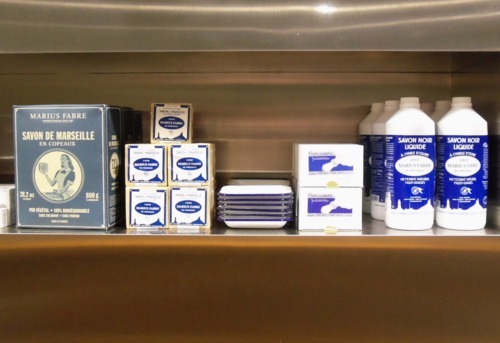
DSM are particularly excited to be introducing a lot of new highly individual and talented names in S/S 2012, ranging from collections by Simone Rocha, Jacquemus, Phoebe English, Tim Coppens, Craig Lawrence and Greg Lauren to shoes by Buruk Uyan, Simona Vanth, and lastly but very not leastly, Cherevichkiotvichki, amazing creations for the feet by Victoria Andrejeva.
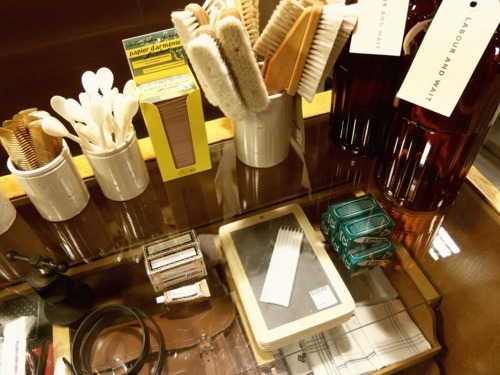

Of course, if you are just looking for a toilet brush or a teapot our concession will serve just as well.
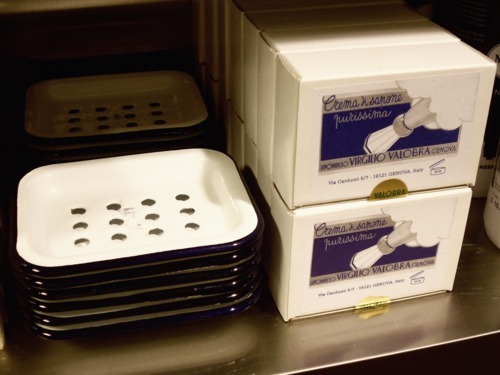
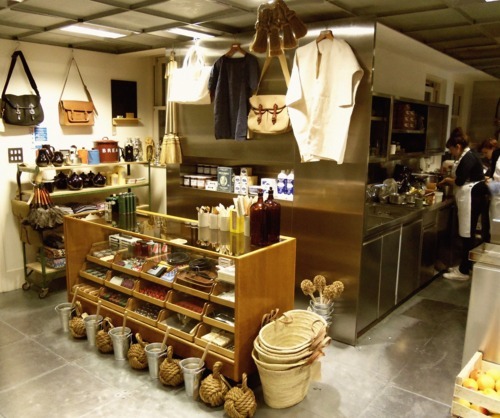
Dover Street Market will re-open on Saturday 17th of January, with Jake and Dinos Chapman signing copies of their new book ‘Flogging a Dead Horse’. Free drinks and snacks will be supplied by our neighbours on the fourth floor, the Rose Bakery.
Well we couldn’t have timed it any better; we sold out of our very last Independent London Store Guide on our last day before closing for Christmas, and we opened again in January with a delivery of Issue 3.
For those unfamiliar with this publication, Independent London is exactly what it says, your guide to the best independent shops and cafes in London, and is almost exactly like having a particularly knowledgeable and erudite friend telling you where to go and what to see. And who handily fits in your pocket.
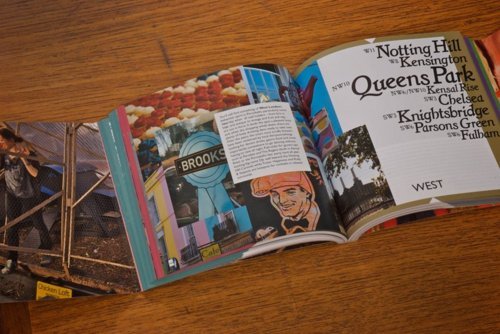
Issue 3 also sees an expansion into more food and drink, with additions such as The Kenton pub, and a family butchers in still-to-be-gentrified Well Street, as well as coffee roasters, fishmongers, brewers and a particularly mouth-watering Chocolaterie in Peckham.
As 2011 saw the opening of a vast East London shopping megalopolis to mirror its counterpart in the West, and the arrival into Shoreditch of ‘brands’ disguised by shipping containers, the start of 2012 seems as good a time as any to remind everyone of the need ( and the pleasure ) of shopping small, shopping local, and shopping independent.
 Bought several years ago in France, this two-piece coffee pot caught our eye with its perfect proportions. It has a pleasing simplicity of design married with a comforting homely appearance.
Bought several years ago in France, this two-piece coffee pot caught our eye with its perfect proportions. It has a pleasing simplicity of design married with a comforting homely appearance.
Throughout the new year we will be sharing each monthly image from our 2012 calendar.
At LABOUR AND WAIT we always stock a selection of vintage items which we hope customers will incorporate into their daily lives. For ten years we have enjoyed exploring vintage markets both in the UK and abroad in search of unique items to rescue and restore to life. We are always attracted by the often quirky design of products manufactured in the past, whose colours and shapes can seem startling to our eyes. We never know what we will unearth and sometimes we find it hard to part with our discoveries. In this calendar we would like to share some of our favourite finds with you.
A word about our postage, and in particular our environmental policy.
At Labour and Wait we are careful to reuse all our packaging. We go through vast amounts of cardboard, paper and bubble wrap, and all this is reutilised as we send out our own mail order.

We try to reuse everything that we receive from deliveries of our stock, which you can imagine, with such breadth in our offering, is quite substantial.

So if your package has old stickers, or tape marks, or is scuffed or scribbled on, or if your dustpan brush comes in a box marked ‘enamel mugs - priced’, then don’t worry, the items inside will be perfectly preserved and ready to be used, so just think of the old saying: Reduce, Reuse, Recycle.
Our Tokyobike collaboration took a trip around London on Saturday as part of the November Tweed Run.

Pictured above is a very dapper gentleman by the name of Neil, who would be happy to sell you a Tokyobike from his new showroom / workshop in the Sunbury Workshops, just around the corner from us here in Redchurch Street.
On the trip the Carradice Junior saddlebag attracted many admiring looks; we had a visit from Carradice recently, showing us a bag from their archive and discussing plans for the future. There look to be some great products coming down the line, tailored more for the urban cyclist rather than the traditional country hill-climber; more Peckham Rye than Pendle Hill.

We love traditional companies like Carradice. Owned and run by the same family for generations, they can tell you not only when each product was made, but in which factory, as the story of their expansion mirrors the story of their success.
When the Tweeders have lost interest, and dressing up as English Gent circa 1951 becomes passé ( or even outré ) there will still be companies like Carradice making great products for cyclists to use, and which make their bikes look even better. This is in complete accord with our philosophy of timeless functionality, favouring products that have always been and always will be desirable, outside of fashion or trends.
Carradice will be approaching their centenary soon, and they look as healthy now as they did in 1930.
Once again SCP have been very helpful in organising and co-ordinating all the Shoreditch shops of interest, and they have designed a map for the ’Shoreditch Christmas Triangle’. Although slightly outside of the strictest limits of the triangle itself, we are part of the wider Shoreditch Rhombus and so we can present the map here - with Labour and Wait included on the Eastern fringes.
( Click on map or here for a larger, downloadable copy of the map ).
The map highlights all the design-based shops in the Shoreditch area, with their plans for Christmas events, and is the perfect guide to what is happening in December.
As mentioned below, we will be open until 9pm on Thursday the 8th of December, and we will be serving mulled cider and mince pies, so come along and beat the Christmas rush!
The French jams are arrived!
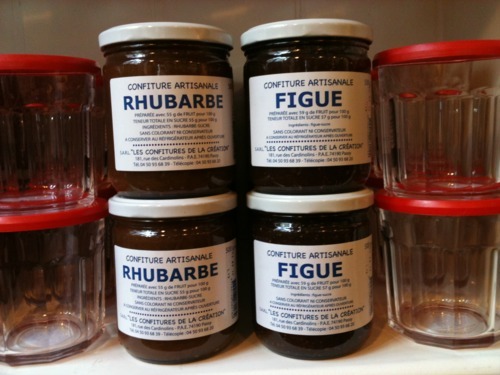
One of our perennial Christmas bestsellers, these French jams are perfect for presents or as a treat for yourself - we have six flavours: Rhubarb, Fig, Black Cherry, Quince, Greengage and Pear.
They will be on the website very soon or, if you can’t wait, drop us an email at orders@labourandwait.co.uk.
After last year’s blizzard-hit whiteout we’re hoping this year’s Christmas Shopping evening will be a bit more enjoyable! All are welcome on the 8th of December for mince pies and mulled cider.

All the shops on Redchurch Street and Calvert Avenue will be taking part, including Anthem, Aesop, Hostem, A.P.C, Sunspel, Luna and Curious, Tracey Nuel, Ally Capellino, Leila’s Shop and our new neighbours Carousel Emporium, so you can make a Christmassy East London night of it!
Thursday 8th December, 6 to 9pm.
We have received our delivery of books from Little Toller, an imprint of the Dovecote Press. From their Dorset base this publisher specialises in books of the English countryside, rescued from obscurity and reprinted in new editions inspired by the spirit of the original editions, replete with contemporary illustrations in a wonderfully tactile, sewn paperback.
We have chosen six titles, each a reprint of a classic depiction of nature or of rural life, from the centenary edition of the poet Edward Thomas’ South Country, to the exploration of 1970s inner-city wildlife that is Richard Mabey’s The Unofficial Countryside. As the winter evenings draw in, surely now is the perfect time to lose yourself in a good book?
Men and the Fields - Adrian Bell
Introduced by Ronald Blythe, with a preface by Martin Bell. This edition restores the original colour lithographs and black and white line drawings by John Nash that appeared in the first edition.

‘I sat against an oak trunk, staring at oak trunks, tracing their boughs upward to the hurrying white clouds beyond, and wondered why one worried about anything. But then I ceased even to wonder, but dozed awake, like a tree.’
Four Hedges - Claire Leighton
Introduced by Carol Klein, with a preface by David Leighton. Includes 84 wood engravings by the author.
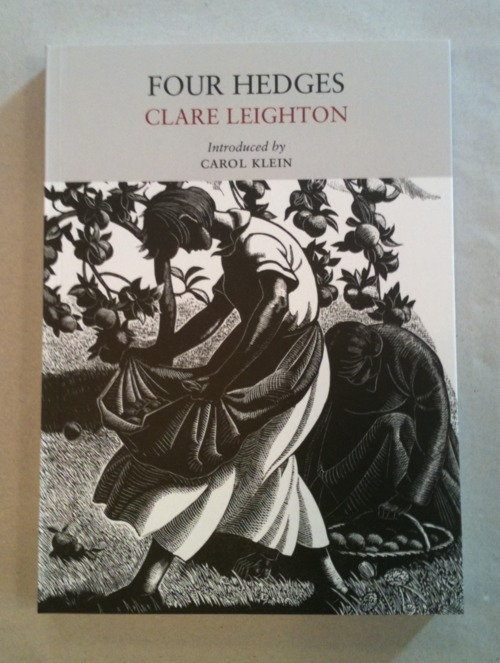
'In the Sky, above our meadow, larks sing. I feel a sudden rush of pride in the ownership of this untilled land; it is not that I value possession, but I am proud to be landlord to the lark who pays for his home with such boundless song.’
The South Country - Edward Thomas
Introduced by Robert Macfarlane. Cover illustration by David Inshaw, with engravings by Eric Daglish throughout.

'Unlearned, incurious, but finding deepest ease and joy out of doors, I have gone about the South Country these twenty years and more on foot… When, in the clear windy dawn, thin clouds like traveller’s joy are upon the air, it seems that up there also, in those placid places, they travel and know the joy of the road.’
Sweet Thames Run Softly - Robert Gibbins
Introduced by Luke Jennings. Cover by Edwin La Dell with wood engravings by Robert Gibbings.

’All I could see was the rushes and their reflections on either side of the river. Nothing was visible beyond them, and the banks, following each bend, cut off my view ahead so that I seemed to be floating on some enchanted lake, high up on the very rim of the world.’
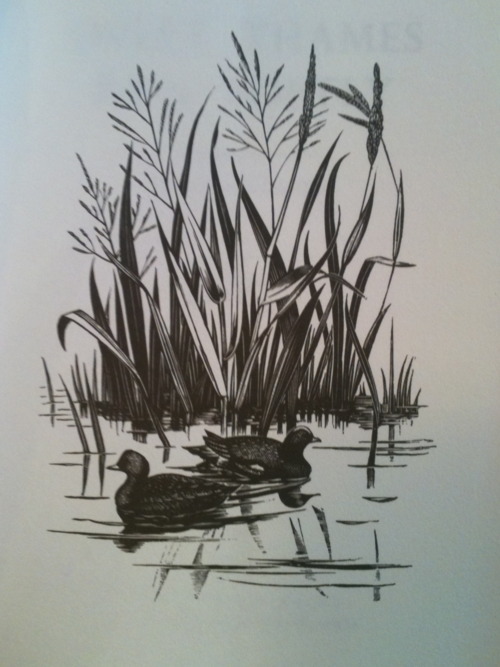
The Unofficial Countryside - Richard Mabey
Introduced by Iain Sinclair. Cover illustration by Mary Newcomb, with illustrations from Mary Newcomb’s sketchbook.
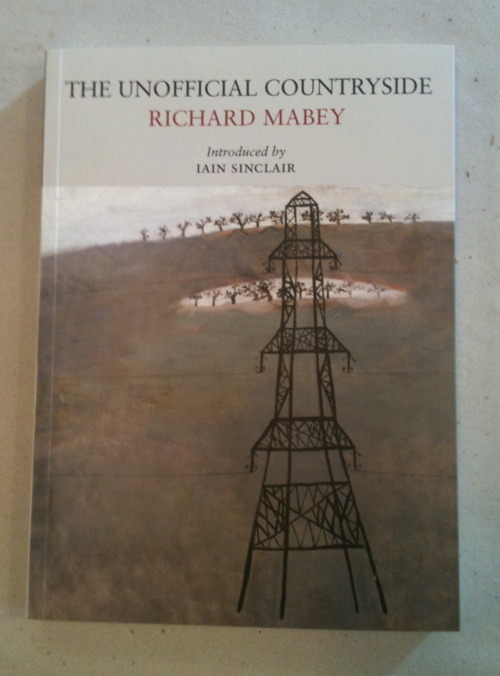
’… the canal here was as clear as a chalk stream. Yellow water lilies drooped like balls of molten wax on the surface. Near the edge of the water drifts of newly hatched fish hung in the shallows. Anglers, fresh out of work, were setting up their tackle on the bank, and family parties chugged past in holiday cruisers…’
The Journal of a Disappointed Man - W.N.P. Barbellion
Introduced by Tim Dee. Cover illustration by Ed Kluz, with 3 facsimiles of handwritten letters by the author.
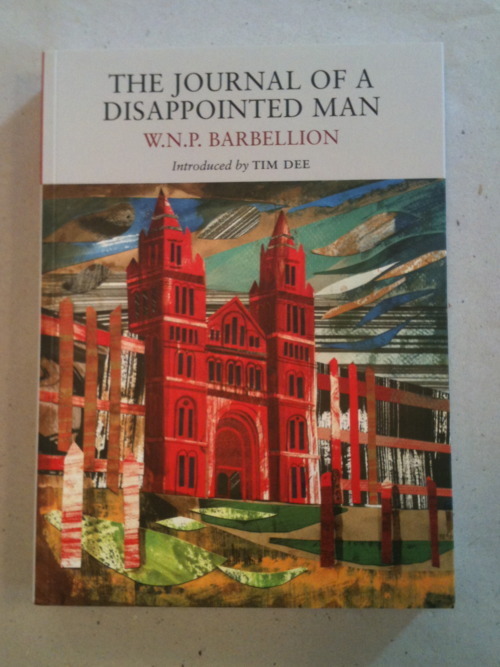
’… my pen is a delicate needle point, tracing out a graph of temperament… You get all my thoughts and opinions, always irresponsible and often contradictory or mutually exclusive, all my moods and vapours, all the varying reactions to environment of this jelly which is I… the book is a self-portrait in the nude.’
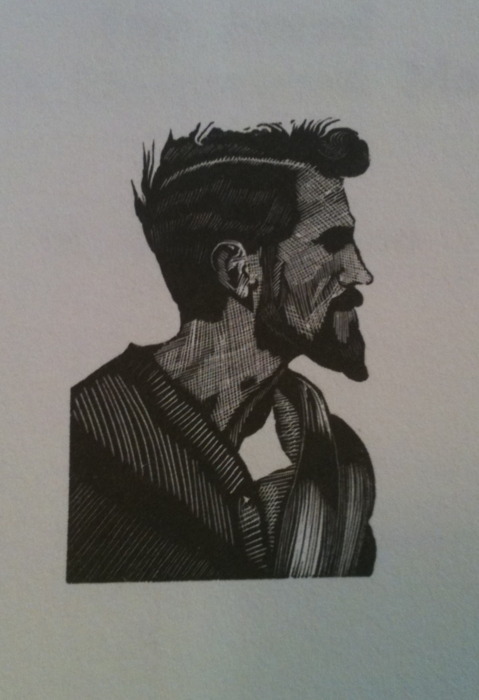
Each book is £10.00, and all are available at our Redchurch Street Store.
*Please note that this blog entry is from October 2011 and we no longer have North Sea Clothing in stock*
We’re very excited to be stocking North Sea Clothing Submariner Jumpers.

We’ve been looking for this particular product for a while now, and after having been tipped off about a company making perfect replicas of this classic style, we are happy to say that they are now in store.

War Office issue in both World Wars, the Royal Navy deck sweater was better known as the Submariner and, as is often the way, this item of clothing gained a new lease of life through ex-servicemen wearing them on civvy street, while at the same time large amounts of unused stock ended up in surplus stores.

During the 1950s this style was in particular favour amongst motorcyclists who would wear them underneath their leather jackets, and it is through a dealer of vintage Barbour and Belstaff leathers that this new Submariner came to life.
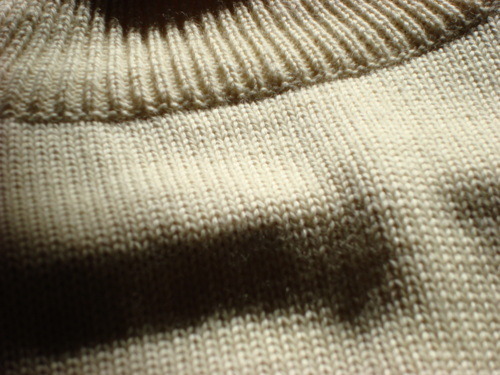
Made in Nottingham from the same heavy 5 gauge knit as the original, this loving recreation has been slightly altered for a modern market ( with longer sleeves and a shorter body ), while retaining all the classic features that made it such an essential piece of kit. The deep ribbing on the waist and the high roll-neck make it an unusual fit for one not used to the style, while the undyed wool can perhaps seem coarse to those more used to the fine gauges or cashmeres of many modern jumpers. These are, of course, part of the jumper’s essential raison d'etre and to smooth out these design features is to negate the very meaning of the jumper. In a similar vein, the slight aroma the jumpers carry is the lanolin in the wool, which helps to keep its new owners dry in the same was as it once did the original. All serve to remind that this is a functional product; yes, it looks great, but it was designed with a purpose in mind.
One of our most popular clothing lines is now back in stock.

The Schott Pea Coat is, we believe, the finest quality example of this classic style, and we are pleased to announce its rearrival for Autumn / Winter 2011. A true design original, this heavyweight jacket is one of the many reasons to welcome the arrival of colder weather.

Originating, as many menswear staples do, from the needs of military service, the Pea Coat was standard issue for British and American navies before being de-mobbed into civilian service. The heavyweight 32 oz Melton Wool is the original windcheater, being thick, warm and durable; the wool is mixed with 25% nylon and other threads which are interlocked and pressed together before being cut, to ensure maximum protection against the elements, whether you are battling your way against the high seas or up the high street.
The classic Pea Coat derives from the Royal Navy Reefer Jacket, originally intended for ‘reefers’ ( Midshipmen ) on board sailing ships, whose job was to climb the rigging and unfurl, or 'reef’, the ship’s sails. The jacket was short, to allow ease of movement through the rigging, while the double-breasted front, which displaced the buttons to each side, helped to reduce the chance of them getting caught on ropes as the wearer maneuvered the sails.

The classic Pea Coat has ten buttons; four pairs in the double breasted style, plus two at the collar. This allows the coat to be buttoned fully to the neck which, with the wide, heavy collar, ensures complete wind and weather resistance.

Richard Crenna exhibiting classic Pea Coat style in 'Wait Until Dark’
So why 'Pea Coat’? As ever with these stories, there are different explanations as to how this name was arrived at. The classic version is that these are 'P’ coats, as worn by the ship’s Pilot, although an older story has the name coming from the Dutch Pijjeker, where Pij is the coarse, heavy wool from which the jacket was made; this material itself became known as Pilot Cloth or P Cloth, hence the P Coat.
The longer, thigh length version is known as the Bridge Coat.
This year we are also offering this style in children’s sizes. As all well-dressed ladies know, the men’s cuts are often superior to the female and the Pea Coat is no exception. The female version has a shaped waist which offers a more feminine profile, but which also lacks the silhouette of the original style, so losing that classic look. The children’s Schott jackets offer the classic Pea Coat style even in smaller sizes.
Serge Gainsbourg showing how to wear a Pea Coat
Heavy but wearable, durable, and classic - the Pea Coat is perfect Winter wear and a wardrobe essential.

A Bridge Coat in a supporting role in 'On the Waterfront’

Robert Redford in a Pea Coat. You can’t get much cooler than this.
Here is a very quick sneak-peek at our new 2012 Vintage Finds Calendar.

Over the years we have collected some odd, unusual and interesting vintage items which we have then sold in the store. Some, however, were so nice that we couldn’t bear to sell them but thought instead that they should be put on display somewhere. Hence the Labour and Wait Calendar 2012.

A collection of 12 of our most interesting vintage finds, this calendar comes as loose leafs with a complimentary clipboard - in future years, the new design will simply slip into the existing clipboard. Quick, convenient and re-usable.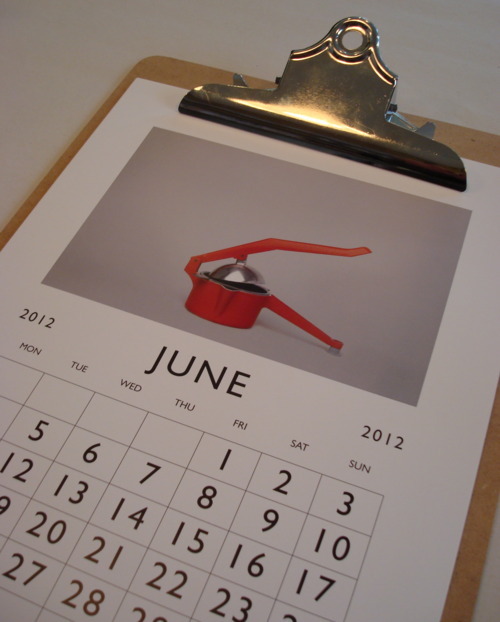

The calendar is available in store for £14.00, and will be available online soon.

Unfortunately one of our long-serving members of staff is leaving us - Nick will have been a familiar sight for many of our Sunday customers, and for many people in and around Shoreditch and Spitalfields, where he and his partner Paul could often be found engaging in the fine and half-forgotten art of flaneuring.
But now the time has come for Nick to leave us; we wish him well, and start the search for his replacement. If you are interested in working for us on Sundays, have experience of customer service, understand and appreciate the Labour and Wait ethos and are available over Christmas, please send your C.V to the address above, or pop in to the store.

We are also looking for temporary Christmas staff, so applications are welcome for these positions too.
We are pleased to introduce the Turner and Harper range of Luxury Goods and Homewares.
Turner and Harper is a British brand devoted to creating quality crafted products for the home. We create products which nod to tradition, balancing timeless aesthetics with considered material choices. At our core is a fascination with translating the small details that fill our daily lives into products which communicate their quality, function and place.

The Turner and Harper range of brushes and domestic tools represent a return to craft traditions and considered material selection. The quality of the woods and of the hog bristle, as well as the enameling on the bowls, make these an outstanding collection of products and, though you’d be tempted not to use them and to put them on display for all to see, they are functional products, designed to be used.
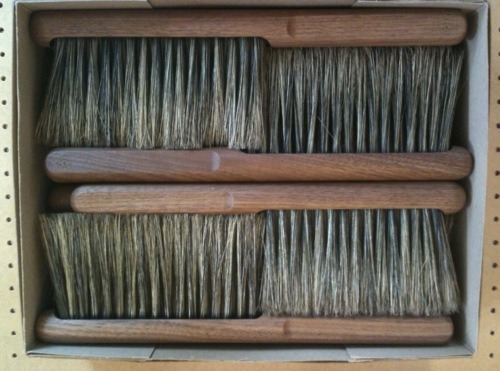
Brush
Completely hand made, finished with a hard wearing stain proof oil. Bristled with soft hog hair that will collect fine dust with ease. The bristle can also be washed to restore it as use takes its toll.
Materials: Black Walnut, Pure Hog Bristle.
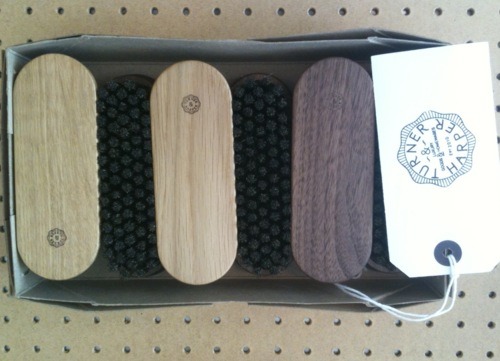
Clothes Brush
A hard wearing stiff bristled brush, suited to brushing clothes, scrubbing vegetables or as a nail brush. Hand machined and finished with a waterproof oil; the unique quality of each piece is accentuated by the differing grain in the carefully selected wood.
Materials: Oak, Black Walnut, Pure Hog Bristle.

Dustpan
Brushed stainless steel dustpan with a rubber coated handle to grip the brush. The metal is shaped with a hyde mallet, carefully assembled by hand and finished with refined industrial processes.
Materials: Stainless Steel, PVC Rubber.
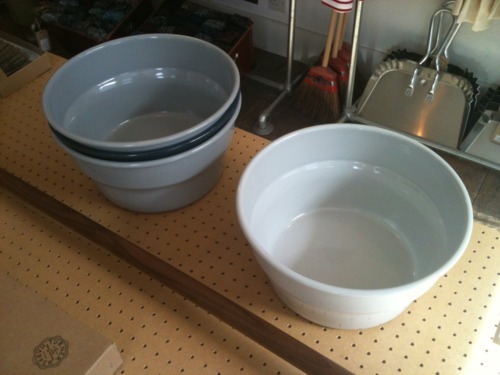
Enamel Household Basin
A vitreous enamel basin with tall sides that lend themselves to carrying water without spillage. The kink in the sides serves to make holding a full, heavy vessel more comfortable, while the unique properties of enamel result in a very hard wearing finish which is inert to chemicals.
The steel is cold formed in a spinning process which hardens the material, resulting in a strong, durable product.
Materials: Steel, Vitreous Enamel.

Broom
A soft hog bristle broom ideally suited for use on tiled and wooden floors. The wood is selected, machined and finished by hand, giving a unique character to each piece.
Supplied with a small hook to aid storage and prolong the life of the bristle.
Bespoke stainless steel bolts fix the handle to the brush head, employing skills usually reserved for restoration of vintage motorcycles. By bolting the elements together, the connection is strengthened, allowing for any maintenance that may be required with time and use.
Materials: Black Walnut, Pure Hog Bristle, Powder Coated Steel, Bespoke Stainless Steel Fixings.
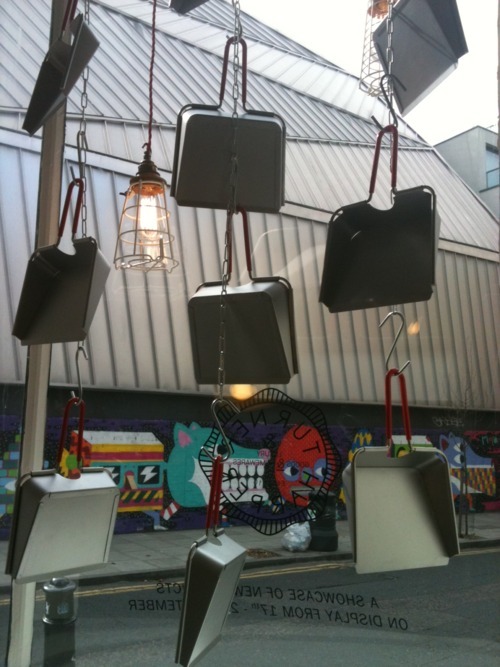
Turner and Harper is being launched exclusively through Labour and Wait during London Design Week.

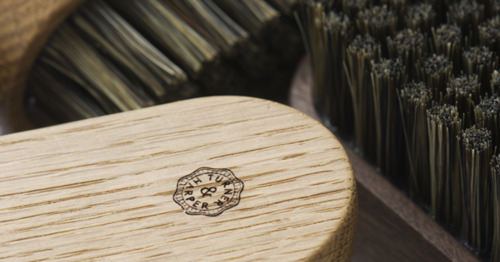



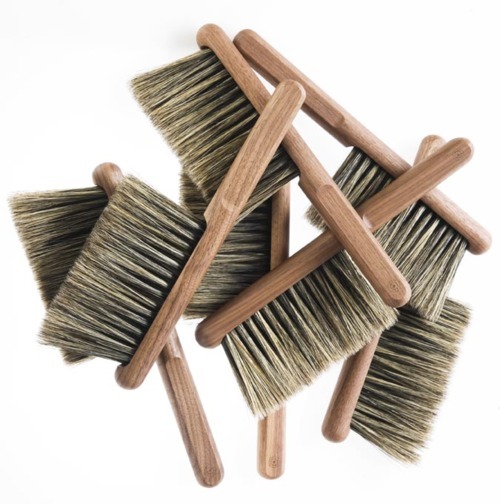

As part of this launch, and as part of Shoreditch Design Triangle, our Redchurch Street store will be opening late on Tuesday 20th September, when designer Tom Harper will be in store to introduce his range of products.

Labour and Wait feature in the October issue of The World of Interiors, alongside four other independent shops specialising in timeless and practical products.
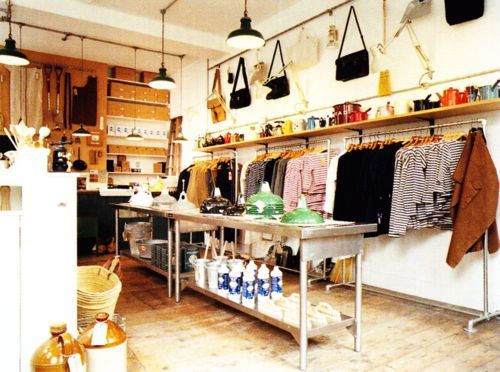
We are no strangers to photoshoots in this shop, so we always know it will be a good one when the photographer has not only a medium format camera, but medium format film; these World of Interior photos prove the truth of this rule.
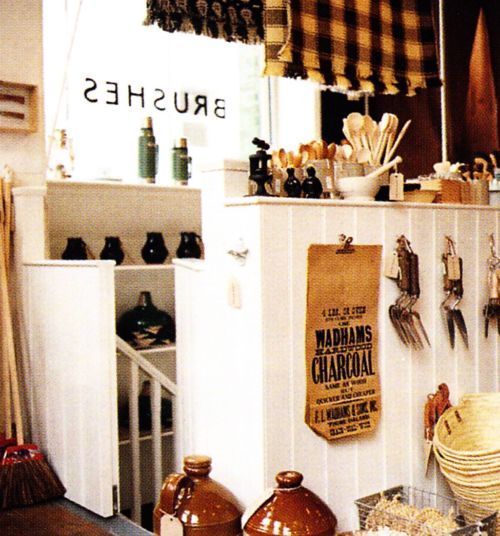
Labour and Wait have been shortlisted in the Best British Retailer section of the British Design Awards 2011.

The British Design Awards (BDAs) recognise beautiful, useful and original new work created by designers for UK and international brands, and are brought to us by ELLE Decoration in association with John Lewis and with support from Telegraph Magazine.
Although we don’t count as new, we’d like to see ourselves as being beautiful, useful and original. Thanks to all at Elle and the BDAs for including us.
( Should you wish to, you can vote here )

With the sudden onset of autumn, its time to for us to start introducing some of our warmer and woolier lines; these Irish Cottage Socks are a real treat for frozen feet and one of our most popular winter products.

Available in our Redchurch Street store now, or email us for more info.
Who is the Gentle Author? This mysterious character is as much a part of Spitalfields’ myth and mystery as any of the personages past and present featured in the exquisite historical and sociological blog Spitalfields Life.
We are very proud to have appeared in the backpages of this fascinating online record of the life and times of this part of London in which we settled ten years ago, and which we now call home. So we were intrigued by the appearance of an invitation to the unveiling of the Map of Spitalfields Life.
Drawn by Adam Dant, himself a Spitalfields character of no little renown, whose beautifully drawn, delicate and detailed maps of the East End of London have entertained and intrigued locals and visitors alike, this map promises to reveal the stories of fifty of the people who have made Spitalfields so distinctive.
The map, devised and drawn under the strictest security, will be unveiled by Sandra Esqulant, Queen of Spitalfields, at 7 o'clock sharp on Thursday 15th September, at Town House, Fournier Street. We’ll be there, and we can’t wait to see who’ll be on the map.
From the 17th to the 25th of September Labour and Wait will be taking part in this year’s Shoreditch Design Triangle. Thirty four local shops, galleries and studios will be hosting a variety of events and exhibitions showcasing the best in contemporary design.
As part of this, and to tie in with London Design Week, we will be launching the Turner and Harper range of brushes, as well as participating in the Late Night Shopping event on Tuesday 20th. This will be a chance to meet the designer of this exclusive range, as well as to have a browse of our Redchurch Street store, and to see all the interesting events taking place in and around Shoreditch.
The Design Triangle is coordinated by SCP with their media partners Dezeen, and a map and guide to the events can be found here.
We are pleased to present Labour and Wait’s collaboration with Tokyobike.

The resurgence of interest in urban cycling is one of the most remarkable stories of the past few years.
Perhaps the influence of ‘fixie’ culture has worked its way into the mainstream, for there is no avoiding the brightly coloured, narrow handlebarred single-geared machines weaving in and out of the London traffic, nor the classic ( and not so classic ) racers and their hunched and frantic riders. All these cyclists now take their place on the roads alongside the town bikes, the tourers, the Dutch bikes, mountain bikes, Bromptons, shoppers, choppers, BMXs, and cruisers; and lets not ignore the invigorating renaissance of the bike shops, workshops, renovators and restorers and, most curiously, the birth of the bike café.
Those of us who have cycled for many years recognize the freedom and the spontaneity of cycling, as well as the pure and simple pleasure of getting on your bike and pushing hard on the pedals, and it is a joy for us that this is something that more and more people are taking pleasure from. And it is also worth noting that at the start of the twenty-first century so many people are turning to a machine that has survived virtually unchanged for over one hundred years.
So we are delighted to be able to reveal our collaboration with Tokyobike. We first became aware of this company a couple of years ago, both through our Japanese contacts and through their British distributors, when we were taken by the simple, clean lines of the bicycles and the thoughtful, curated appeal of their pop-up shops.

The best way to describe the Tokyobike classic – the basis of this bike – is with the word that appears most often in our blog, in our shop and in our thinking: timeless. The Labour and Wait Tokyobike is truly timeless, for we are neither neon hipster nor tweed-clad gent, but we are who we are.
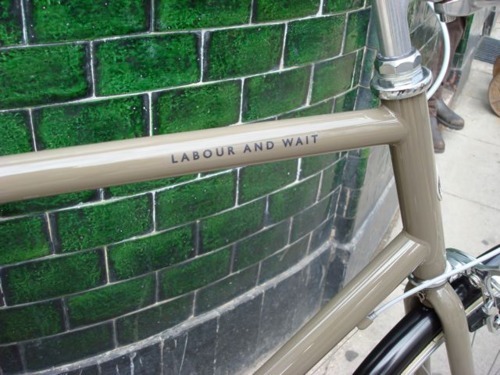
We love the mix of modern and classic on this bike – the full steel frame and Shimano gears with our specification Brooks B17 leather saddle and Carradice Junior saddlebag. The bike is a hybrid of Japanese and British style, the frame designed and built in Japan, the accessories handmade here in the UK.
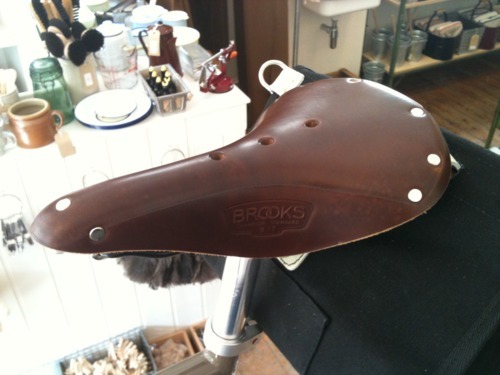

This bike represents Labour and Wait, for it is not about ‘retro’ or nostalgia, but the simple pleasure of a well designed, functional and timeless product.
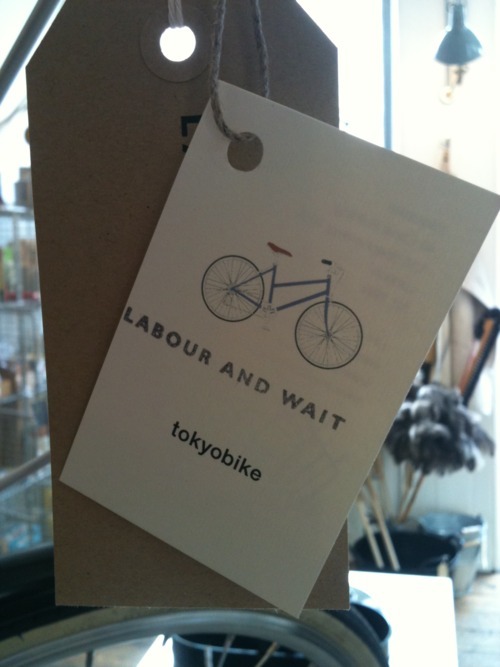
With most blogs and articles on cycling, it seems correct to quote H.G Well’s famous words ( “Every time I see an adult on a bicycle I no longer despair for the future of the human race” ), but in this instance we should turn instead to another author, Iris Murdoch, for our closing sentiment:
“The bicycle is the most civilized conveyance known to man. Other forms of transport grow daily more nightmarish. Only the bicycle remains pure in heart.”
Here is a sneak preview of a collection we will be launching as part of London Design Week.
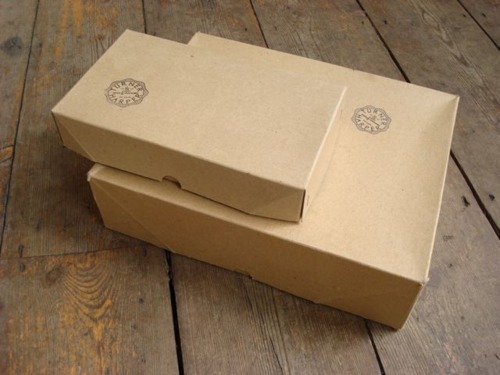
These boxes contain hand made brushes which, in the words of the designer, ‘combine a material quality that nods to tradition with a contemporary design aesthetic’. They will remain hidden, however, until their launch in September.

Based in North Yorkshire, Turner & Harper are a new British company focused on the design and manufacture of timeless, functional products for the home, and we are delighted that they have chosen to launch their brand and their products through Labour and Wait.
The launch will take place in London Design Week 2011 ( 17th - 25th September ), when all will be revealed!
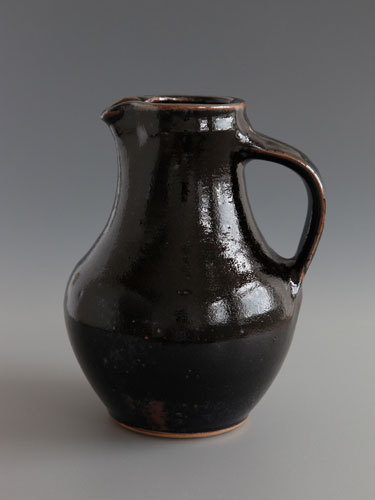
Our recently arrived – and long awaited - delivery of Japanese products included amongst it a small selection of Syussai pottery. The story of the Syussai kiln is a fascinating one, a story that crosses back and forth across the globe and which makes clear the connections between English Arts and Crafts and Japanese Mingei, between British studio potters and Japanese craftsmen and which links the Cornish town of St. Ives with a small kiln on the banks of the Hiikawa river.
The Syussai kiln was established in 1947 by five friends who each shared the aim of making simple, utilitarian crockery for everyday use. Their work was influenced by the Mingei “folk craft” movement founded by Yanagi Muneyoshi in the early years of the Twentieth Century, and which saw pure and natural beauty in ordinary objects created by unknown craftsmen for practical purposes. Mingei products celebrate the work of the artisan and the fulfillment of an object’s innate purpose.

Tatano Hiromitsu, one of the founders of the Syussai kiln, learnt about Mingei through his studies of William Morris and the Arts and Crafts Movement, the celebration of artisan craftsmanship which was in part a reaction against the industry and mass production of late Victorian England. Together with Kawai Ganjiro, an associate of Yanagi, Tatano came up with the idea of creating a kiln where individual craftsmen could create utilitarian pottery in a traditional manner.

The Syussai kiln was strongly influenced by the English potter Bernard Leach. Born in Hong Kong, Leach studied at the London School of Art and travelled and worked extensively in Japan and China before, in 1920, opening his own traditional Japanese “climbing kiln” in St Ives with his friend the Japanese potter Shoji Hamada. For the next 50 years, this kiln was the focal point for the studio pottery movement. Throughout Leach’s career he advocated that the potter’s focus should not be on decoration or embellishment but in the tactile and functional perfection of objects designed for everyday use. This belief, shaped by the principles of Mingei, defined the studio pottery movement and the St Ives kiln became the college for a new generation of potters making their way through Leach’s apprentice system.

Leach’s philosophy of pottery is contained in his classic A Potter’s Book. The required manual for any studio potter, practical tips are combined with aesthetic ideals and Leach’s interpretation of the values of Mingei - “Enduring forms are full of quiet assurance. Overstatement is worse than understatement.”
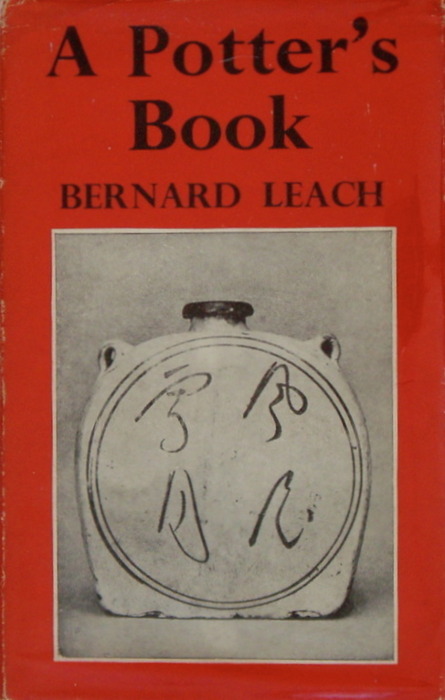
The Syussai kiln is one of the few remaining where Bernard Leach originally stayed and where he shared his designs and expertise; the jug we are selling is one of Syussai’s Leach products. The most noteworthy feature of it is the handle, in a Western style, and which Leach called the ‘wet handle’. This is made from a ball of clay and shaped using the heat and humidity of the hand, imagining a branch growing from the trunk of a tree. The shape of the potter’s thumbprint remains, making an ergonomic grip. Even within Syussai there are only a few craftsmen who can make this handle.
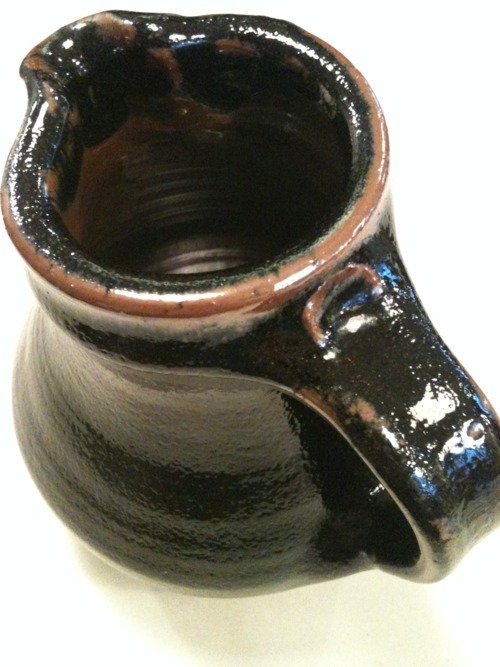
After 60 years, the Shussai kiln still insists on using local materials for its clay and glazes, and despite its fame, it continues to make practical crockery for ordinary people in the Izumo area. We are delighted to be able to provide this beautiful pottery to our customers here in England. The thread between English Arts and Crafts and Japanese Mingei, between St Ives and Hiikawa, runs through this Syussai pottery and defines the concept of studio pottery as laid down by Leach - the Marriage of East and West.
The Syussai jugs are available in three sizes from our Redchurch Street store.
The Leach Pottery in St Ives is still open as a studio, museum, gallery and shop.
We’re delighted to introduce our new range of lighting accessories. Bulbs, bulb holders and fabric cable are now available in store and online, the perfect partners for our enamel lampshades.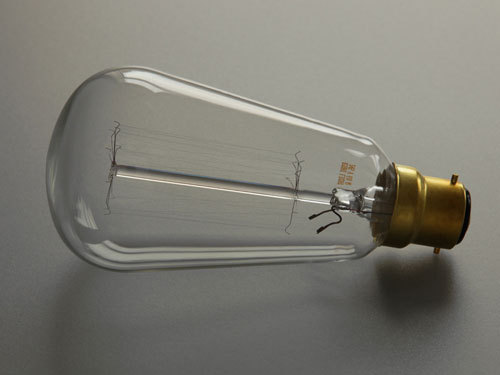
The delicate appearance of the Swiss-made filament light bulb belies the strength of its illumination, and as we have them above the counter here in our shop we can vouch for their quality and longevity.
The 60Watt bulb has a bayonet fitting, as have our bulb holders. These are available in brass, nickel and bronze and have a plastic grip to ensure a tight hold on the cord.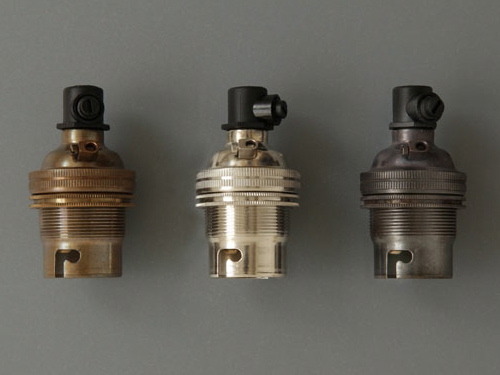
The Italian-made fabric cable is available in four colours; brown, red, black and white. With four colours of lampshade also available, there is plenty of scope to create your own fabulous lighting arrangement.
More information and pictures of our enamel lampshades can be seen below.
All products are available online from our website.
